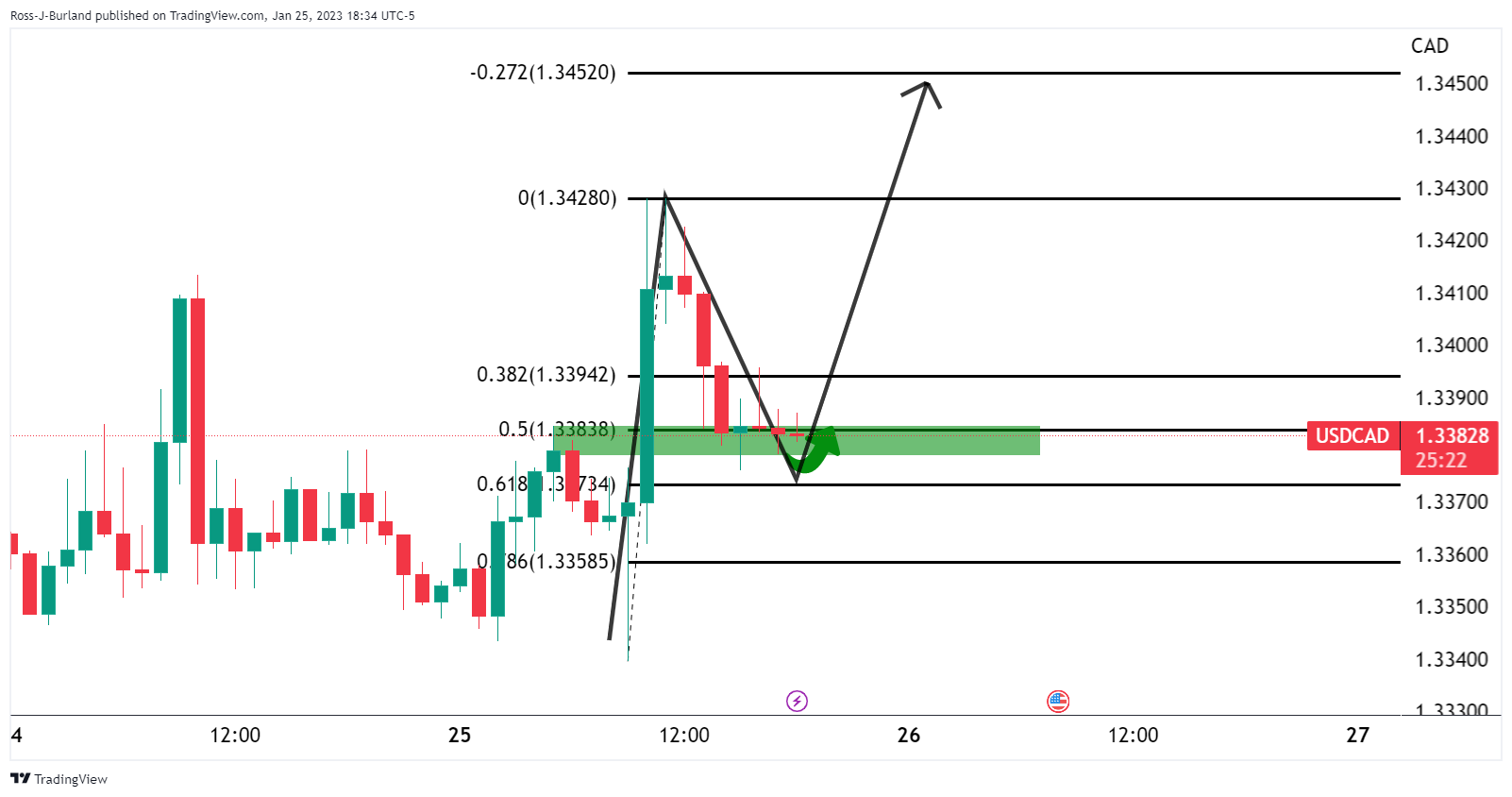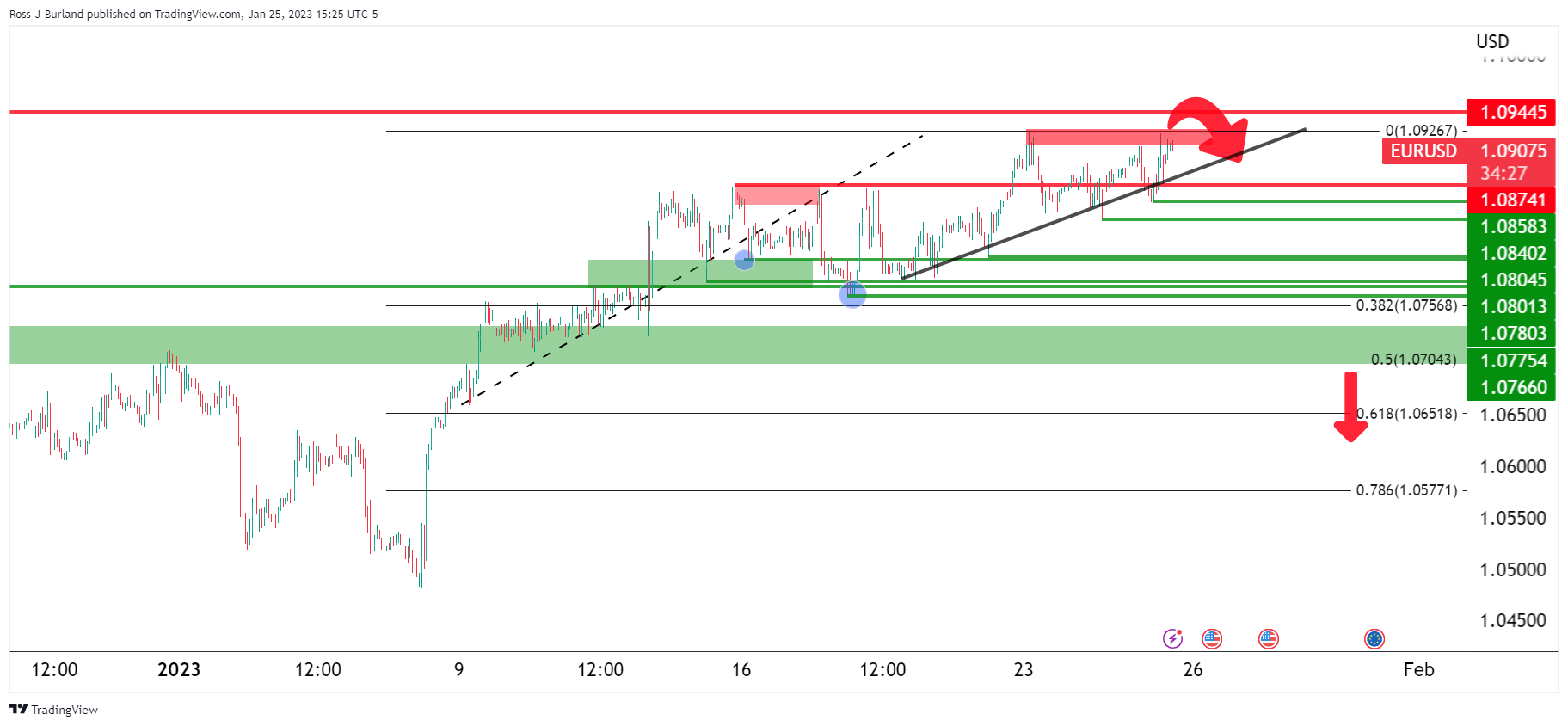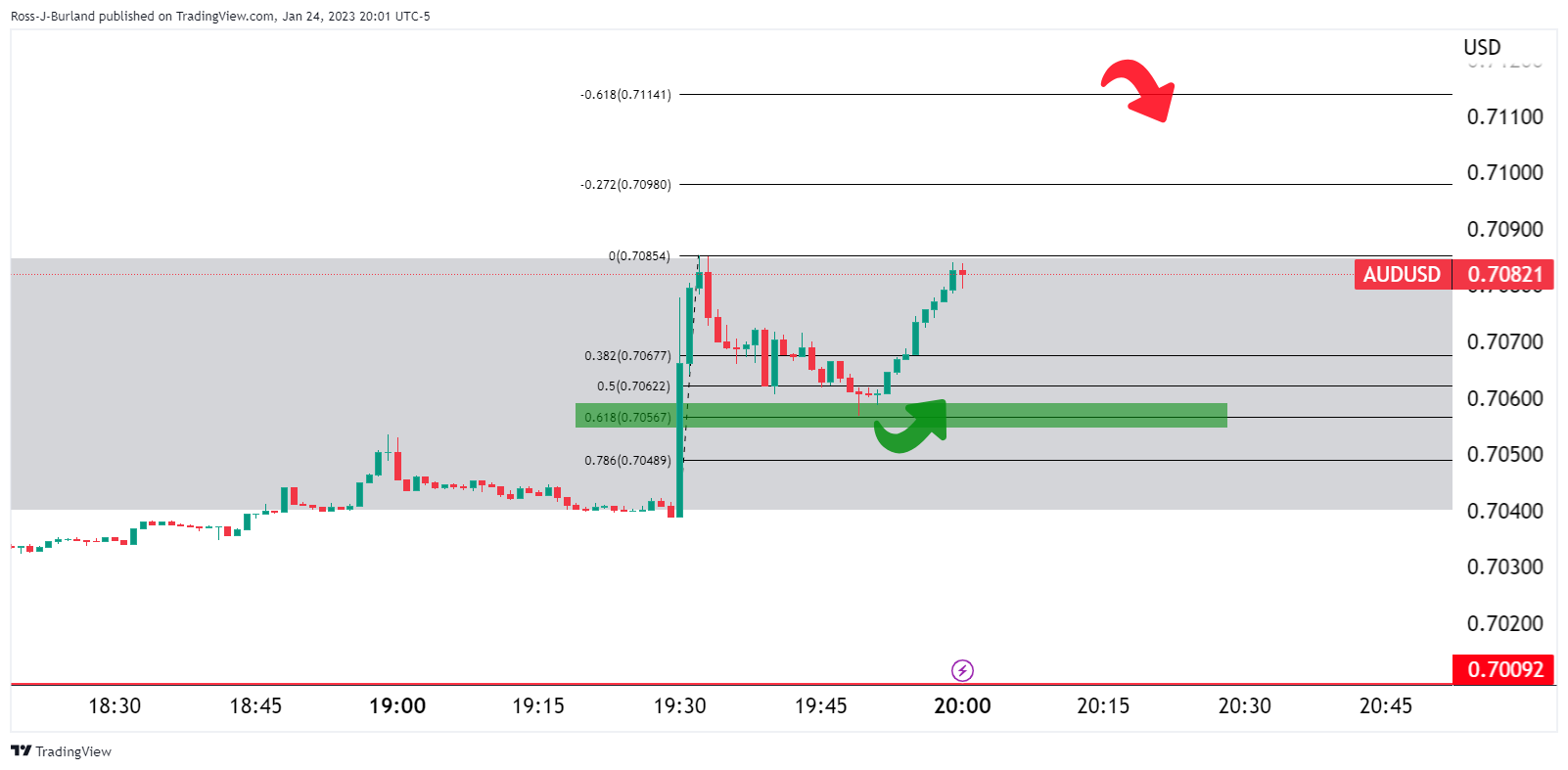- Phân tích
- Tin tức và các công cụ
- Tin tức thị trường
Tin tức thì trường
- US Dollar Index holds lower ground near the six-month bottom marked the last week.
- Divergence between Fed and ECB policymakers’ latest comments, as well as data from Europe and US, weigh on DXY.
- Treasury bond yields, Wall Street remain mixed ahead of the key catalysts.
US Dollar Index (DXY) remains on the back foot as sellers attack the multi-month low marked the last week around 101.30, close to 101.55 by the press time of early Thursday. In doing so, the greenback’s gauge versus the six major currencies braces for the third consecutive weekly fall while renewing the intraday low.
It’s worth noting that hopes of a dovish Federal Open Market Committee (FOMC) grew stronger amid the Fed blackout and weigh on the DXY. The reason could be linked to the previously downbeat US data surrounding wages for December and activities for January. “Traders broadly expect the Fed to increase rates by 25 basis points (bps) next Wednesday, a step down from a 50 bps increase in December,” said Reuters.
Additionally weighing the US Dollar could be the hawkish comments from the European Central Bank (ECB), as well as the upbeat data from the bloc. On Wednesday, Germany’s IFO Business Climate Index matched 90.2 forecasts for January versus 88.6 prior but the Current Assessment eased from 94.4 to 94.1, versus 95.0 expected. Further, the IFO Expectations for the said month also came in higher-than-consensus 85.0 while rising to 86.4, compared to 83.2 previous readings.
That said, ECB Governing Council member Gabriel Makhlouf became the last policymaker from the bloc’s central bank to fire the hawkish shot, suggesting a 50 bps rate hike, ahead of the one-week blackout pre-ECB. "We need to continue to increase rates at our meeting next week – by taking a similar step to our December decisions," said ECB’s Makhlouf. Makhlouf further added that they need to increase rates again at the March meeting.
Elsewhere, cautious optimism in the market adds strength to the bearish bias for the US Dollar Index as traders expect a China-inspired economic rebound to push back the recession fears.
Against this backdrop, as well as taking clues from the mixed earnings report, Wall Street closed mixed and the US Treasury bond yields remained sidelined near 3.45. The S&P 500 Futures also remain sluggish around 4,036 by the press time.
While the DXY bears are in control, their further dominance depends upon the first readings of the US fourth quarter (Q4) Gross Domestic Product (GDP), expected to print annualized growth of 2.6% versus 3.2% prior. Also important to watch will be the US Durable Goods Orders for December and the Q4 Personal Consumption Expenditure (PCE) data. Should the scheduled data print upbeat outcomes, the US Dollar Index traders may get a reason to pare latest losses.
Also read: US Gross Domestic Product Preview: Three reasons to expect a US Dollar-boosting outcome
Technical analysis
Although December 2022 low near 101.45 restricts short-term US Dollar Index rebound, the DXY’s further downside remains elusive unless the quote breaks a six-week-old descending support line, currently around 101.10.
- USD/CAD stalls on the correction post-BoC and bulls are holding the first at a 50% mean reversion.
- USD/CAD's daily 61.8% Fibonacci resistance is a compelling target that meets structure and the 20 EMA.
USD/CAD was a mover on Wednesday due to the Bank of Canada's interest rate decision whereby the pair shifted gears on the announcement, rallying from a low of 1.3340 to score a high of 1.3428 prior to correcting back into the rally following a consolidation around the BoC's governor, Tiff Macklem's, comments on the policy outlook and responses to questions from the press.
The following illustrates the price action that occurred over the event and prospects for a move higher, depending on the outcome of today;'s critical pre-Fedral Reserve meeting US economic data.
USD/CAD H1 chart
The correction has stalled at the 50% mean reversion of the move. This area also has a confluence with the prior resistance earlier in the week which raises the probability of a move up from here over the course of the next sessions, namely the London and US trade.
USD/CAD daily chart
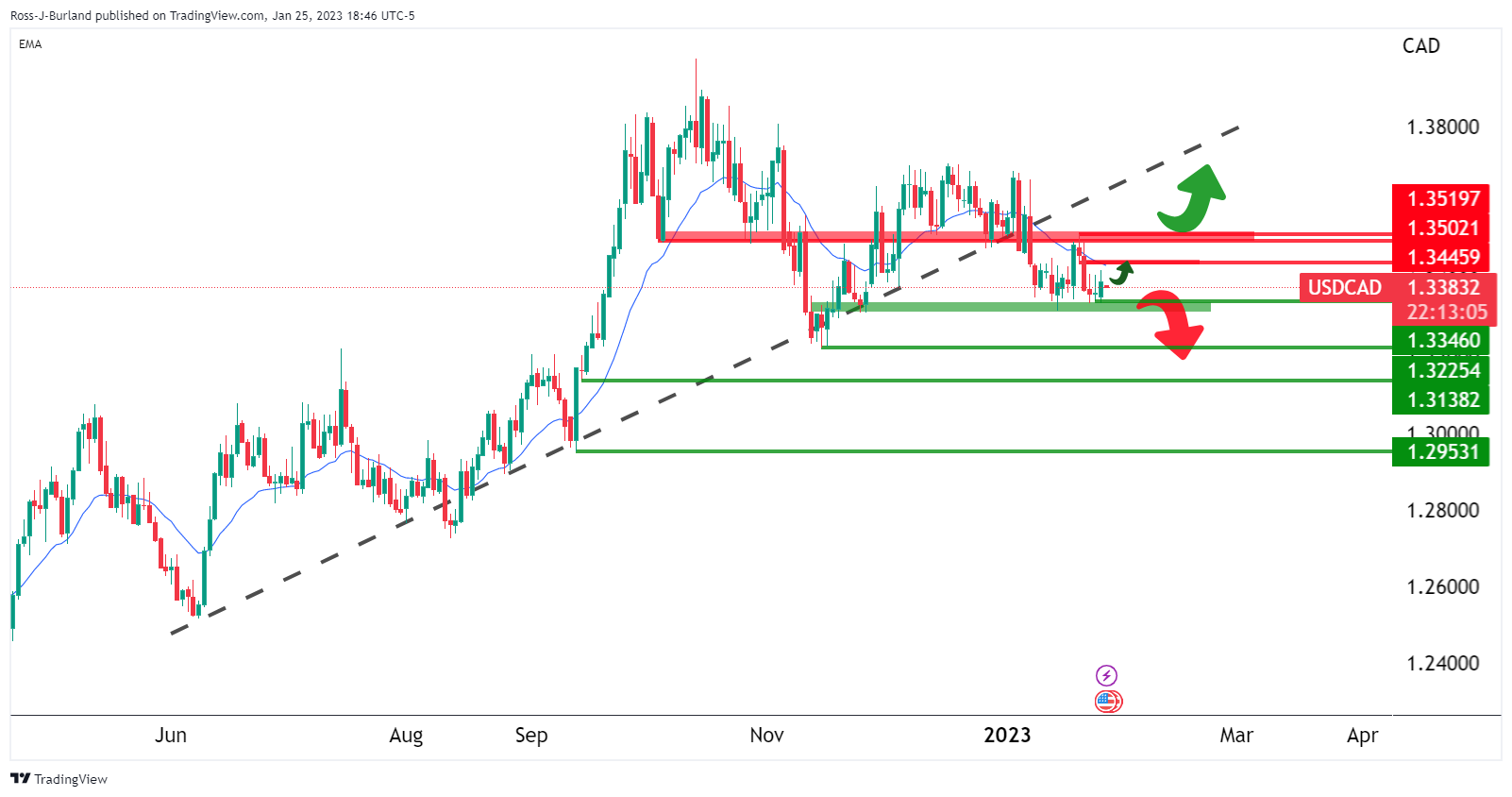
there would be prospects of a bullish breakout as per the above daily chart above should the bulls break above 1.3520. However, 1.3450 is guarded by the 20-day EMA and 1.3500 could also prove a tough area to break above. Meanwhile, the 61.8% Fibonacci resistance is a compelling target that meets structure and the 20 EMA:

- Oil price is oscillating around $80.50 as investors await US GDP for fresh cues.
- The black gold has not shown any power-pack action despite a smaller-than-expected jump in oil inventories.
- United States President Joe Biden is considering refilling the Strategic Petroleum Reserve.
West Texas Intermediate (WTI), futures on NYMEX, is displaying back-and-forth moves around $80.50 in the early Asian session. The black gold is displaying a sideways auction as investors are awaiting the release of the United States Gross Domestic Product (GDP) data for fresh impetus. According to the estimates, the US GDP is expected to shrink to 2.8% vs. the prior release of 3.2%.
The declining scale of economic activities indicates the consequences of rising interest rates by the Federal Reserve (Fed). A contraction in economic activities clears that the oil demand is facing pressure, which could hurt the oil prices ahead. On the same note, the chances of a slowdown in the pace of the interest rate hike by the Fed will accelerate as a contraction in economic activities will also strengthen recession fears.
The oil price has not shown a power-pack action despite the release of the lower-than-anticipated increase in the oil inventories reported by the US Energy Information Administration (EIA). For the week ending January 20, the EIA has reported an increase in oil stockpiles by 533,000 barrels vs. the expectations of 971,000 barrels.
Meanwhile, celebrations of the Lunar New Year in China have triggered short-term pain in the oil price. Economic activities have dropped significantly which has trimmed the oil demand and might result in a pile-up of oil inventories.
On the supply front, the United States is considering refilling of the Strategic Petroleum Reserve (SPR). US President Joe Biden exploited the oil reserves in CY2022 to fight rising oil prices, which could result in a fresh rally in the oil price ahead.
- USD/CHF takes offers to refresh intraday low and extend the previous day’s losses.
- US Dollar bears approach the six-month low marked the last week amid dovish concerns over FOMC amid Fed blackout.
- Market sentiment remains dicey ahead of multiple US data, including Advance readings of Q4 GDP.
USD/CHF stands on slippery grounds as it drops to 0.9170 during Thursday’s Asian session. In doing so, the Swiss Franc (CHF) pair renews its intraday low to extend the previous day’s pullback from the weekly high.
The quote’s latest south-run seems to take the clues from the broad US Dollar weakness, as well as upbeat Swiss data. That said, the Swiss Zew Survey – Expectations improved to the highest levels since March 2022 while flagging -40.0 figure versus -47.6 expected and -42.8 prior.
On the other hand, the US Dollar Index (DXY) remained on the back foot while bracing for the third consecutive weekly loss around 101.65 as hopes of a dovish Federal Open Market Committee (FOMC) grew stronger. “Traders broadly expect the Fed to increase rates by 25 basis points (bps) next Wednesday, a step down from a 50 bps increase in December,” said Reuters.
It should be noted that dicey markets and a lack of major data/events, not to forget the Fed blackout period and Chinese holidays, also allowed the USD/CHF bears to keep the reins. While portraying the mood, as well as taking clues from the mixed earnings report, Wall Street closed mixed and the US Treasury bond yields remained sidelined near 3.45.
Moving on, a slew of US data will entertain the USD/CHF traders even if the Fed policymakers’ absence from the podium tests momentum. Among them, the first readings of the US fourth quarter (Q4) Gross Domestic Product (GDP), expected to print annualized growth of 2.6% versus 3.2% prior, will be crucial amid the recession talks. Additionally important will be the US Durable Goods Orders for December and the Q4 Personal Consumption Expenditure (PCE) data.
Also read: US Gross Domestic Product Preview: Three reasons to expect a US Dollar-boosting outcome
Technical analysis
A clear downside break of one-week-old ascending trend line, now resistance near 0.9250, directs USD/CHF towards the yearly low marked in the last week around 0.9085.
- AUD/USD seesaws around five-month high as bulls take a breather after four-day uptrend.
- Higher highs on RSI (14) contrast with the lower high on prices to probe the bullish trend.
- Overbought RSI conditions, seven-month-old horizontal hurdle also challenge buyers.
- 61.8% Fibonacci retracement, previous weekly high restrict immediate downside.
AUD/USD pauses the four-day uptrend around the highest level since August 2022 as it makes rounds to 0.7100 during Thursday’s sluggish Asian session. Even so, the Aussie pair braces for the biggest weekly gains since early November.
The quote rose to the multi-month high on crossing the 61.8% Fibonacci retracement level of its April-October 2022 downside. However, the overbought RSI (14) seems to probe the buyers afterward.
Also challenging the upside bias is the hidden bearish RSI divergence, a condition where the price prints lower highs but the indicator prints higher highs.
As a result, the AUD/USD bulls should wait for a confirmation of the latest bullish trend. In doing so, the horizontal area comprising multiple highs marked since June 2022, near 0.7140 will be the key to watch.
Following that, a run-up towards the June 2022 high near 0.7285 can be expected. It’s worth noting that the 0.7200 round figure may act as an intermediate halt during the likely run-up.
Alternatively, pullback moves need to conquer the 61.8% Fibonacci retracement level, also known as the ‘golden ratio’, around 0.7090, to tease the AUD/USD bears.
Even so, the previous weekly high near 0.7065, could act as the additional downside filter before convincing the sellers to attack the 0.7000 psychological magnet.
AUD/USD: Daily chart
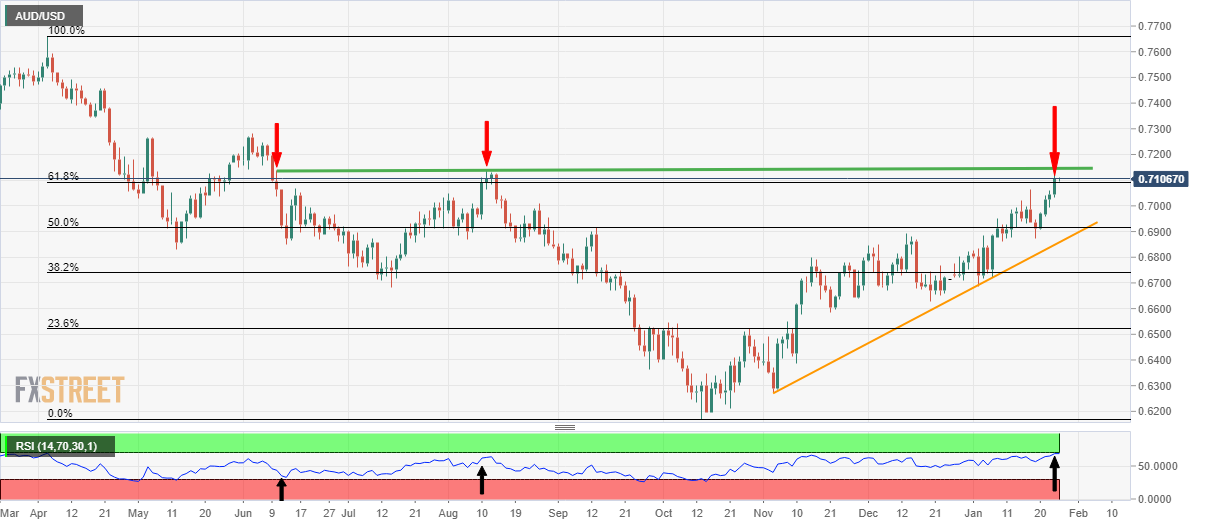
Trend: Pullback expected
- Dragonfly doji surfaced as the GBP/JPY recovered from weekly lows around the mid-159/160 mark.
- GBP/JPY Price Analysis: Neutral to downward biased, but in the short term, it could test the 200-DMA.
The GBP/JPY is almost unchanged as the Asian session kicks in, though Wednesday’s session witnessed the cross falling to new weekly lows of 159.50. However, the GBP/JPY pair staged a comeback and formed a dragonfly doji, which suggests bulls are moving in. The GBP/JPY is trading at 160.50 at the time of writing.
GBP/JPY Price Analysis: Technical outlook
From a daily timeframe perspective, the GBP/JPY is still neutral-to-downward biased, with the exchange rate remaining below the trend-setter 200-day Exponential Moving Average (EMA) at 162.14, which is also above the 50-day EMA at 161.74. For the GBP/JPY to continue its downtrend, it would need to crack the 20-day EMA at 160.05, and then, the pair may pose a threat to break below the weekly low of 159.50.
As an alternate scenario, for the GBP/JPY bullish continuation, the pair needs to reclaim the psychological 161.00 figure. Break above will expose the 50-day EMA, followed by the 162.00 mark. Once broken, the bulls could challenge the 200-day EMA at 162.14.
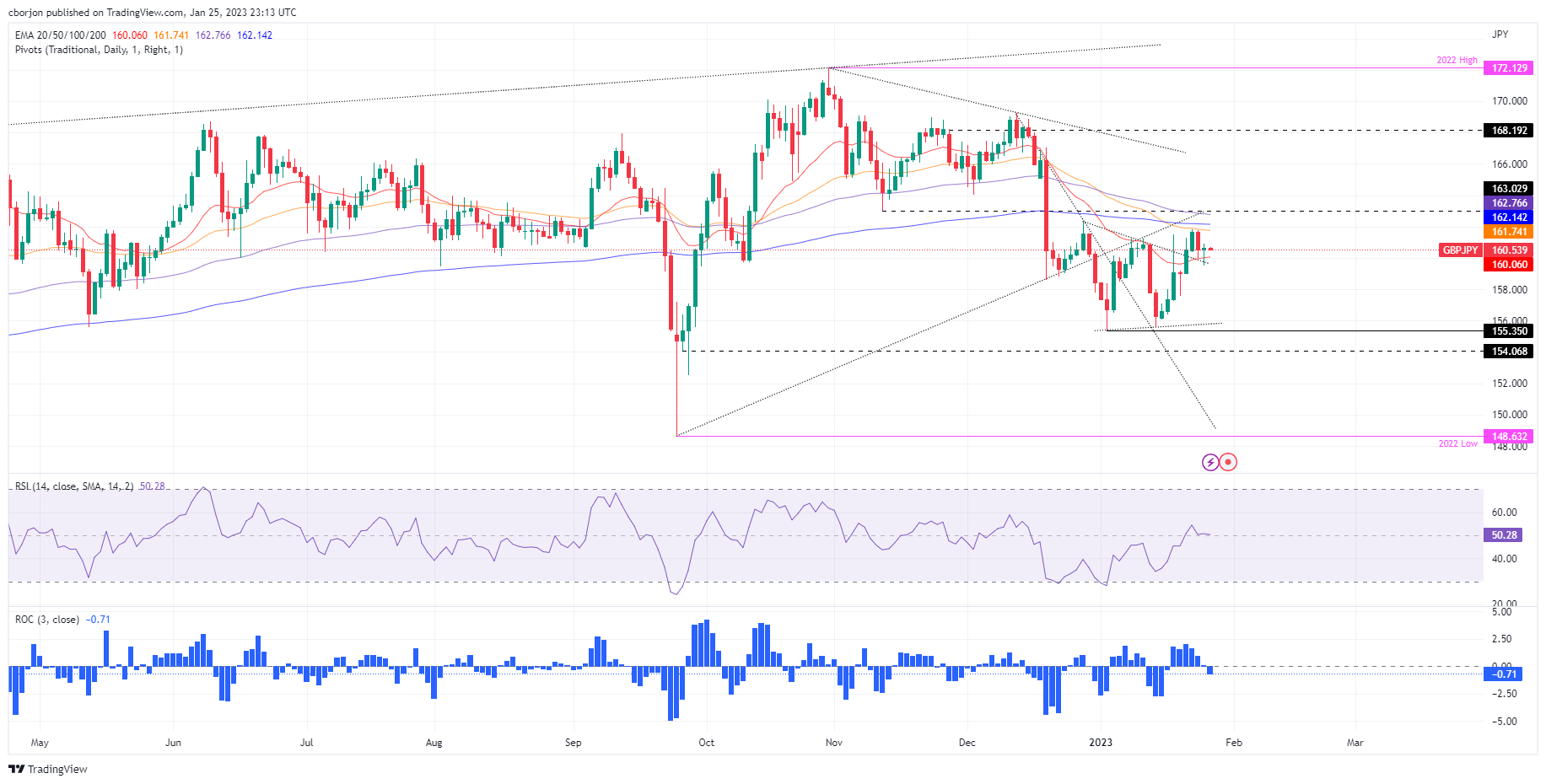
GBP/JPY Key Technical Levels
- EUR/JPY has slipped after sensing selling interest around 141.50 ahead of Tokyo inflation.
- Tokyo’s headline CPI is seen at 4.4% while the core CPI might scale to 2.8%.
- The ECB is constantly reiterating the need for further policy tightening to contain the inflation mess.
The EUR/JPY pair is facing pressure in extending its recovery move above the immediate resistance of 141.50 in the early Tokyo session. The cross attempted a recovery below 141.00 on Wednesday after a massive sell-off move. The Euro faced immense pressure after the release of the German IFO- Business Climate (Jan) data. The economic data remained in line with the estimates at 90.2 but higher than the former release of 88.6.
German IFO Business Survey, the institute’s Economist Klaus Wohlrabe cited that “the German economy is starting the year with cautious optimism.” He added that the economy might not face any recession but the Gross Domestic Product (GDP) will probably shrink slightly in Q1 - mainly due to consumption. It is worth noting that 48.4% of companies complained in Jan about supply bottlenecks vs. 50.7% in Dec.
For further policy tightening European Central Bank (ECB) President Christine Lagarde and other policymakers are continuously reiterating the need for further interest rate hikes to contain the inflation mess.
ECB Governing Council member Gabriel Makhlouf said on Wednesday "We need to continue to increase rates at our meeting next week – by taking a similar step to our December decisions," as reported by Reuters. He further added that they need to increase rates again at the March meeting.
On the Tokyo front, investors will be focusing on the release of the Tokyo inflation, which is scheduled for Friday. The headline Tokyo Consumer Price Index (CPI) (Jan) is seen higher at 4.4% vs. the former release of 4.0%. Also, the core inflation that excludes oil and food prices is expected to increase marginally to 2.8% against the 2.7% released earlier.
- NZD/USD is marching higher to recapture the 0.6500 hurdle amid the risk-on market mood.
- An absence of inflation softening in New Zealand might force the RBNZ to hike interest rates further.
- The US Dollar will display a power-pack action after the release of the US GDP and Core PCE data.
The NZD/USD pair has rebounded after a minor correction to near 0.6470 in the early Asian session. The kiwi asset is looking to recapture the psychological resistance of 0.6500 amid positive market sentiment. The New Zealand Dollar displayed sheer volatility on Wednesday after the release of the Q4CY2022 Consumer Price Index (CPI) data.
The annual CPI of New Zealand for the fourth quarter increased marginally to 7.2% from the expectations of 7.1% but remained constant in comparison with the prior release. Also, the inflation rate escalated marginally to 1.4% vs. the expectations of 1.3% on a quarterly basis. An absence of inflation softening in the Kiwi zone indicated that the Reserve Bank of New Zealand (RBNZ) might continue to hike interest rates further to contain soaring inflation.
It is worth noting that RBNZ Governor Adrian Orr has already increased the Official Cash Rate (OCR) to 4.25% and might be forced to continue to tighten policy further amid a hot-inflated environment.
Meanwhile, investors’ risk appetite has improved again as S&P500 recovered losses witnessed earlier on Wednesday. The US Dollar Index (DXY) has cracked to a near seven-month low of around 101.40 as the pace of policy tightening by the Federal Reserve (Fed) is set to calm down further. Analysts at Wells Fargo warned that the greenback has already embarked on a prolonged period of depreciation that could last into 2024. They further added that relative economic growth performance and monetary policy outlook have turned less supportive of the US dollar.
Going forward, investors will witness a power-pack action by the US Dollar after the release of the United States Gross Domestic Product (GDP) data, which is expected to contract to 2.6% from the prior release of 3.2%. Apart from that, investors will also focus on Durable Goods Orders and Core Personal Consumption Expenditure (PCE) data.
- EUR/USD steadies around nine-month high after five-day uptrend.
- Upbeat German data, pre-Fed consolidation favor bulls amid sluggish market.
- ECB’s Makhlouf fired the last hawkish shot before the one-week silence before monetary policy meeting.
- Advance reading of US Q4 GDP will be crucial ahead of next week’s FOMC.
EUR/USD bulls are in command near the nine-month high, despite recently taking a breather around 1.0915, as the major pair traders await the first readings of the US fourth quarter (Q4) Gross Domestic Product (GDP). The quote cheered broad US Dollar weakness and the upbeat German data, not to forget the hawkish bias surrounding the European Central Bank (ECB), to print a five-day uptrend by the end of Wednesday.
That said, the US Dollar Index (DXY) remained on the back foot while bracing for the third consecutive weekly loss around 101.65 as hopes of a dovish Federal Open Market Committee (FOMC) grew stronger.
On the other hand, Germany’s IFO Business Climate Index matched 90.2 forecasts for January versus 88.6 prior but the Current Assessment eased from 94.4 to 94.1, versus 95.0 expected. Further, the IFO Expectations for the said month also came in higher-than-consensus 85.0 while rising to 86.4, compared to 83.2 previous readings. Following the data release, IFO Economist Klaus Wohlrabe said that “the German economy is starting the year with cautious optimism.”
Elsewhere, ECB Governing Council member Gabriel Makhlouf became the last policymaker from the bloc’s central bank to fire the hawkish shot, suggesting a 50 bps rate hike, ahead of the one-week blackout pre-ECB. "We need to continue to increase rates at our meeting next week – by taking a similar step to our December decisions," said ECB’s Makhlouf. Makhlouf further added that they need to increase rates again at the March meeting.
Amid these plays, market sentiment remained dicey as the calendar was light elsewhere and there were few macros, amid the China holidays and the Fed blackout. That said, Wall Street closed mixed and the US 10-year Treasury bond yields ended Wednesday with minor moves around 3.45%.
Looking forward, a slew of the US data will entertain the EUR/USD traders even if the Fed and the ECB policymakers are restricted from speaking. Among them, the first reading of the US Q4 GDP, expected to print annualized growth of 2.6% versus 3.2% prior, will be crucial amid the recession talks.
Also read: US Gross Domestic Product Preview: Three reasons to expect a US Dollar-boosting outcome
Technical analysis
Although a weekly support line restricts the immediate downside of the EUR/USD pair near 1.0865, the monthly high and April 2022 peak, respectively near 1.0926 and 1.0936, could challenge the bulls.
- The daily chart portrays that the GBP/USD is still upward biased.
- Short term, the GBP/USD breaking a downslope trendline paved the way for further upside.
- GBP/USD Price Analysis: Intraday speaking, a test of 1.2400 is on the cards, followed by 1.2440.
The GBP/USD is trading almost flat as the Asian Pacific session begins. On Wednesday, the GBP/USD closed on a higher note, up by a half percent (0.50%), but fell short of achieving a daily close at 1.2400. Nevertheless, the uptrend remains intact, and the GBP/USD exchanges hands at 1.2392, registering minimal losses of 0.04%.
GBP/USD Price Analysis: Technical outlook
From a daily chart perspective, the GBP/USD remains upward biased, with sellers failing to drag prices below the 20-day Exponential Moving Average (EMA) at 1.2254. To further extend its uptrend, GBP/USD bulls need to reclaim 1.2443, which would exacerbate a rally towards June’s high of 1.2597, shy of the 1.2600 figure.
Intraday speaking, the GBP/USD is neutral to upward biased. After breaking above a downslope resistance trendline drawn from January 23 highs, broken around 1.2370/75, opened the door to challenge the 1.2400 mark. Nonetheless, the Relative Strength Index (RSI) slope is aiming downward, which suggests that a pullback to the daily pivot point level at 1.2363 is on the cards. Following that, the GBP/USD might print a leg up towards 1.2400, followed by the R1 daily pivot at 1.2440, followed by the R2 pivot at 1.2483.
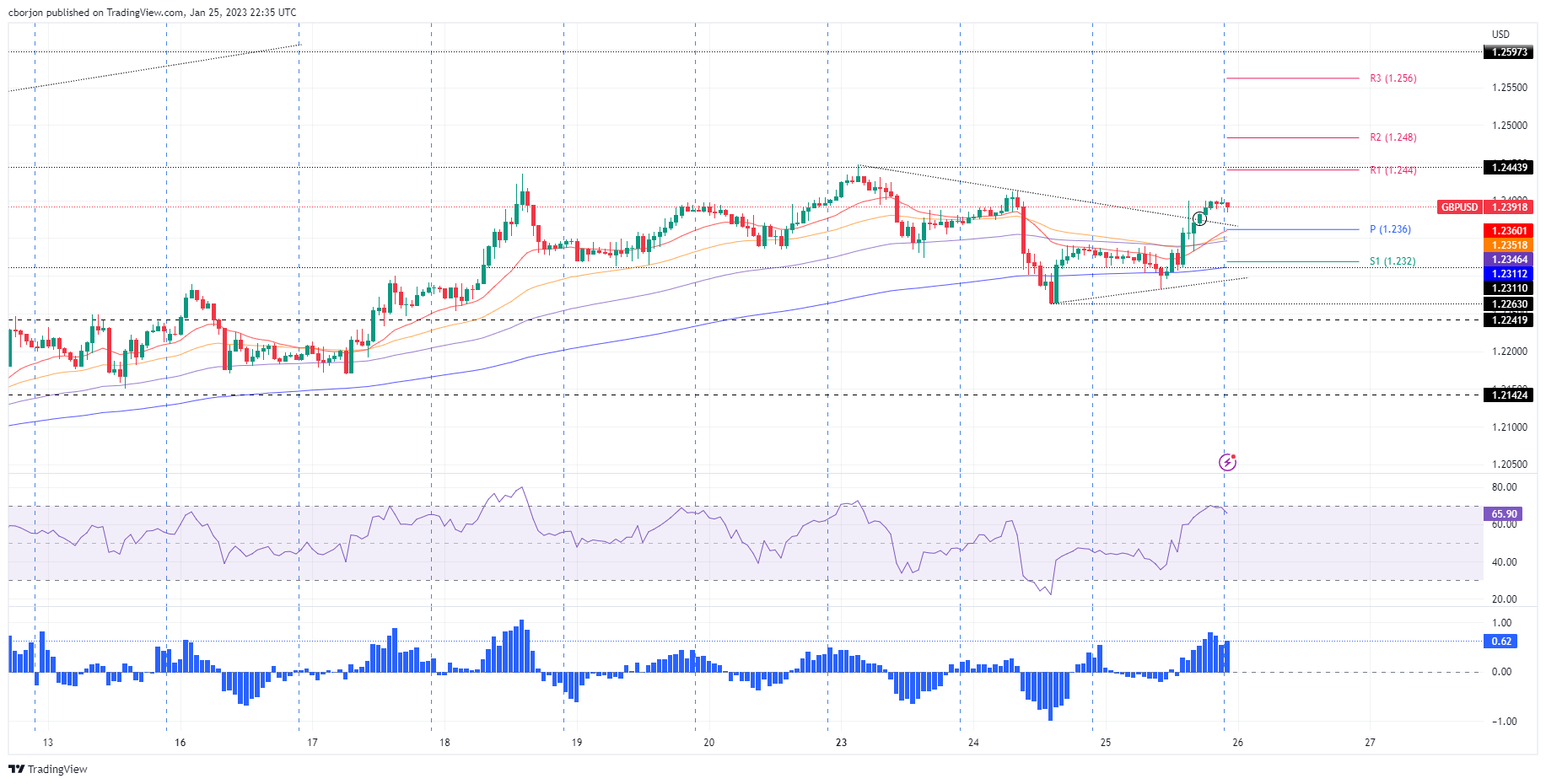
GBP/USD Key Technical Levels
- USD/CAD picks up bids to reverse post-BoC losses, eyes the first weekly gain in six.
- BoC matches market forecasts of 0.25% rate hike but rate outlook, comments from Governor Macklem flashed mixed messages.
- WTI crude oil fails to cheer softer US Dollar, EIA data amid fears of supply increase.
- Slew of US data to entertain Loonie pair traders, advance readings of US Q4 GDP is the key.
USD/CAD picks up bids to add to the first weekly gain in six as bulls poke 1.3400 during the early hours of Thursday’s Asian session. In doing so, the Loonie pair consolidates the post-Bank of Canada (BoC) moves amid softer Oil price and a lack of clarity on the BoC’s next moves. Adding strength to the rebound could be the cautious mood ahead of the first readings of the US fourth quarter (Q4) Gross Domestic Product (GDP).
"Prepared to increase policy rate further if needed to return inflation to 2% target; continuing the quantitative tightening program," mentioned the BoC statement after matching 0.25% rate hike expectations. However, the Canadian central bank also mentioned that it will likely hold rates at this level while assessing the impact of recent policy moves. Following that, BoC Governor Tiff Macklem shrugged off rate cut talks. Hence, mixed signals from the BoC allowed USD/CAD buyers to sneak in even if the central bank becomes the first among the majors to talk about the pause in rate lifts.
On the other hand, WTI crude oil struggles to defend $80.00 amid fears of sustained supply cuts from the global oil producers, as well as the US readiness for more Strategic Petroleum Reserve (SPR) release if needed. On the same line could be the fading of China-linked optimism amid the Lunar New Year (LNY) holidays, as well as a cautious mood ahead of the key data/events. Alternatively, a smaller inventory rise in the US, per the US Energy Information Administration’s (EIA) Crude Oil Stocks Change data for the week ended on January 20, 0.533M versus 0.971M expected and 8.408M prior, as well as the softer US Dollar failed to inspire the energy bulls.
It should be noted that the market sentiment remained dicey amid a light calendar elsewhere and the lack of major macro, amid the China holidays and the Fed blackout. That said, Wall Street closed mixed and the US 10-year Treasury bond yields ended Wednesday with minor moves around 3.45%. However, the US Dollar Index (DXY) remained on the back foot for the third consecutive week.
Having witnessed the BoC-led moves, the USD/CAD traders are likely to witness a volatile day as a slew of US data is up for release. Among them, the first reading of the US Q4 GDP will be crucial amid the recession talks and due to the next week’s Federal Open Market Committee (FOMC) meeting.
Also read: US Gross Domestic Product Preview: Three reasons to expect a US Dollar-boosting outcome
Technical analysis
USD/CAD appears clubbed between 10-week-old support and a downward-sloping resistance line from January 06, respectively near 1.3345 and 1.3440.
- Gold price is looking to test the $1,950.00 resistance amid volatility in the USD Index.
- A pause in BoC’s policy tightening conveys that major central banks are near to the terminal rate.
- More-than-projected contraction in the US Q4 GDP might accelerate recession fears.
Gold price (XAU/USD) is aiming to test the $1,950.00 resistance for the first time in the past nine months as the US Dollar Index has faced immense pressure. The precious metal displayed a vertical rally after dropping to near $1,920.00amid rising hopes that the Federal Reserve (Fed) has no other option than to announce a smaller interest rate hike ahead. Also, a pause announced in the policy tightening by the Bank of Canada (BoC) has conveyed a message that major central banks have reached to the terminal rate.
The US Dollar Index (DXY) has dropped to near seven-month low of around 101.20 and a downside break will trigger massive selling from the market participants. S&P managed to recover losses, portrayed optimism in the market and dips are being capitalized as a buying opportunity in the risk-perceived assets by the market participants. The 10-year US Treasury yields dropped to 3.44%.
For further guidance, investors will keep an eye on the release of the preliminary United States Gross Domestic Product (GDP) data for the fourth quarter of CY2022. As per the projections, the annualized GDP is seen lower at 2.6% vs. the prior release of 3.2%. An expression of a contraction in overall economic activities might accelerate recession fears on a broader basis.
Gold technical analysis
Gold price is in a strong uptrend forming higher highs and higher lows on a daily scale. The precious metal has witnessed three consecutive buying tails, which indicates that the market participants are buying the dips with immense interest. On a broader note, horizontal support plotted from June 13 high at $1,879.26 will be a cushion for the Gold price.
The 10-and 20-period Exponential Moving Averages (EMAs) at $1,924.74 and $1,895.26 respectively are aiming higher, which signals more upside ahead.
Also, the Relative Strength Index (RSI) (14) is oscillating in a bullish range of 60.00-80.00, which indicates that the bullish momentum is active.
Gold daily chart
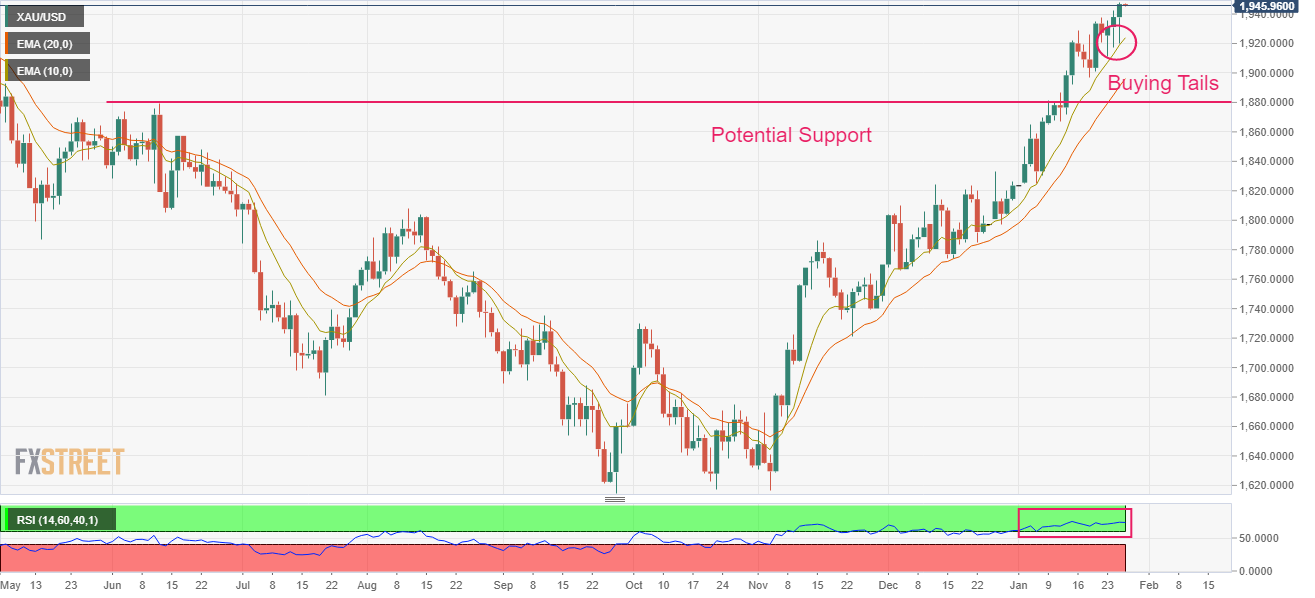
Here is what you need to know for Thursday 26 January:
The clock is ticking down as we head towards the end of the month and the Federal Reserve/ European Central Bank meetings. A storm is potentially building in the forex space and Thursday's data events will be critical in that regard.
It was somewhat subdued across some pairs, but lively in others as investors and traders roll up their sleeves ahead of today's slew of key economic numbers that will go towards the Federal Reserve's interest rate decision on February 1.
The US Commerce Department set to release its initial advance fourth-quarter Gross Domestic Product estimates at the same time that the nation's Core PCE prices will be due, likely accelerating to a 0.3% moM pace in December, though a 0.4% gain can't be discarded, analysts at TD Securities argued. ''The yoY rate likely slowed to 4.5%, suggesting prices continue to moderate but remain sticky at high levels,'' the analysts argued. In regards to the growth data, the analyst said, ''we also look for Gross Domestic Product growth to have stayed strong in Q4, posting another above-trend gain. Growth was likely supported by firm showings from the consumer and inventories.''
Ahead of this data, WIRP suggests a 25 bp hike on February 1 is fully priced in, with less than 5% odds of a larger 50 bp move. Another 25 bp hike on March 22 is about 80% priced in, while one last 25 bp hike in Q2 is only 35% priced in.
The dovish outlook saw the US Dollar once again fall against the euro on Wednesday, although traders are not seeing this through and EUR/USD stuck to a 1.0875 / 1.0923 range on the day.
Elsewhere, there was some better movement in USD/JPY. The pair closed down the prior day which gave the bears the fuel to continue selling against pullbacks, denying the bulls space into the peak formation set earlier in the week USD/JPY fell from a high of 130.58 to a fresh low of 129.26 when the NY traders came on line, extending London's supply. this made for great opportunities for trades targeting prior support structures on the way down to 129.50 and then the 129.20s.
USD/CAD was another pair that offered traders opportunities with two-way action on the day over the course of the Bank of Canada's interest rate decision. The Bank of Canada, as expected, raised the key interest rate by 25 basis points to 4.5%. In the statement, the central banks mentioned that will likely hold rates at this level while assessing the impact of recent policy moves. The Loonie weakened across the board as a result but soon r found buyers as the BoC's governor Tiff Macklem delivered his remarks on the policy outlook and responded to questions, warning that they are not ruling out further hikes and are data dependent. The USD/CAD rose from 1.3365 to 1.3426. It then pulled back into a prior support structure in the 1.3375s in a 50% mean reversion of the BoC rally.
The Australian Dollar and Kiwi were higher on Wednesday after a surprisingly red-hot inflation report for Australia and as for Yesterday’s Q4 CPI inflation from NZ, (while still far too strong at 7.2% YoY in Q4) analysts at ANZ Bank argue that it ''was much better under the hood than the RBNZ feared at the time of the hawkish November MPS.'' The Kiwi traded between 0.6450 and 0.6504 while the Aussie between 0.7032 and 0.7122 (a key level for the day ahead that guards 0.7150.
Elsewhere, the US 10-year yield was 1bp lower at 3.45% and WTI was down 0.1% to USD80/bbl. Gold popped 0.8% to $1940.4/oz.
- Higher-than-expected Australian inflation data increased the odds of a rate hike by the RBA.
- Sentiment shifted mixed as Wall Street’s fluctuated between gainers/losers.
- AUD/USD Price Analysis: A daily close above 0.7100 will pave the way for further gains.
The Australian Dollar (AUD) rose to a fresh five-month high at 0.7122 against the US Dollar (USD) on Wednesday, following the release of Australian inflation data that cemented the case for further tightening by the Reserve Bank of Australia (RBA). Except for the Australian Dollar, risk aversion keeps high beta currencies pressured. Hence, the AUD/USD is trading at 0.7106 at the time of writing.
Australia’s CPI data justifies another RBA hike
Wall Street shrugs off some of its earlier losses, though it’s a mixed bag with the S&P 500 and Nasdaq posting gains, while the Nasdaq is fluctuating. An absent US economic docket left AUD/USD traders adrift to Australia’s economic data.
Earlier in the Asian session, the Australian Bureau of Statistics revealed that the Consumer Price Index (CPI) surged 1.9% in Q4, above estimates of 1.6%, while the annual rates climbed to 7.8% from 7.3%, its highest level since 1990. Some analysts estimated that the RBA might pause its hiking cycle as global recessionary fears loom. Nevertheless, the CPI report increased the likelihood of a 25 bps rate hike by the RBA at the February 7 meeting, five days after the US Federal Reserve (Fed) monetary policy meeting.
Digging into the report, core trimmed CPI rose by 1.6%, above estimates of 1.4%, while YoY jumped by 6.9%, above the last month’s 6.1%. Therefore, money market futures have begun to price in 50 bps of hikes, implying a peak of 3.60%, compared with 3.40% just before the CPI release.
Consequently, the AUD/USD extended its gains and prepared to test the August 11 daily high of 0.7136, which could soon be the major’s eyes to close above 0.7100.
AUD/USD Technical Analysis
Technically speaking, the AUD/USD remains upward biased, and if it achieves a daily close above 0.7100, it will open the door for further upside. The case is cemented by oscillators confirming the uptrend. Though shy of overbought conditions, the Relative Strength Index (RSI) continues to aim higher. At the same time, the Rate of Change (RoC) witnessed a volatility jump in two consecutive days, suggesting buyers are moving in.
Therefore, the AUD/USD first resistance would be the August 2022 high of 0.7136. The break above will expose the 0.7150, ahead of the 0.7200 psychological level.
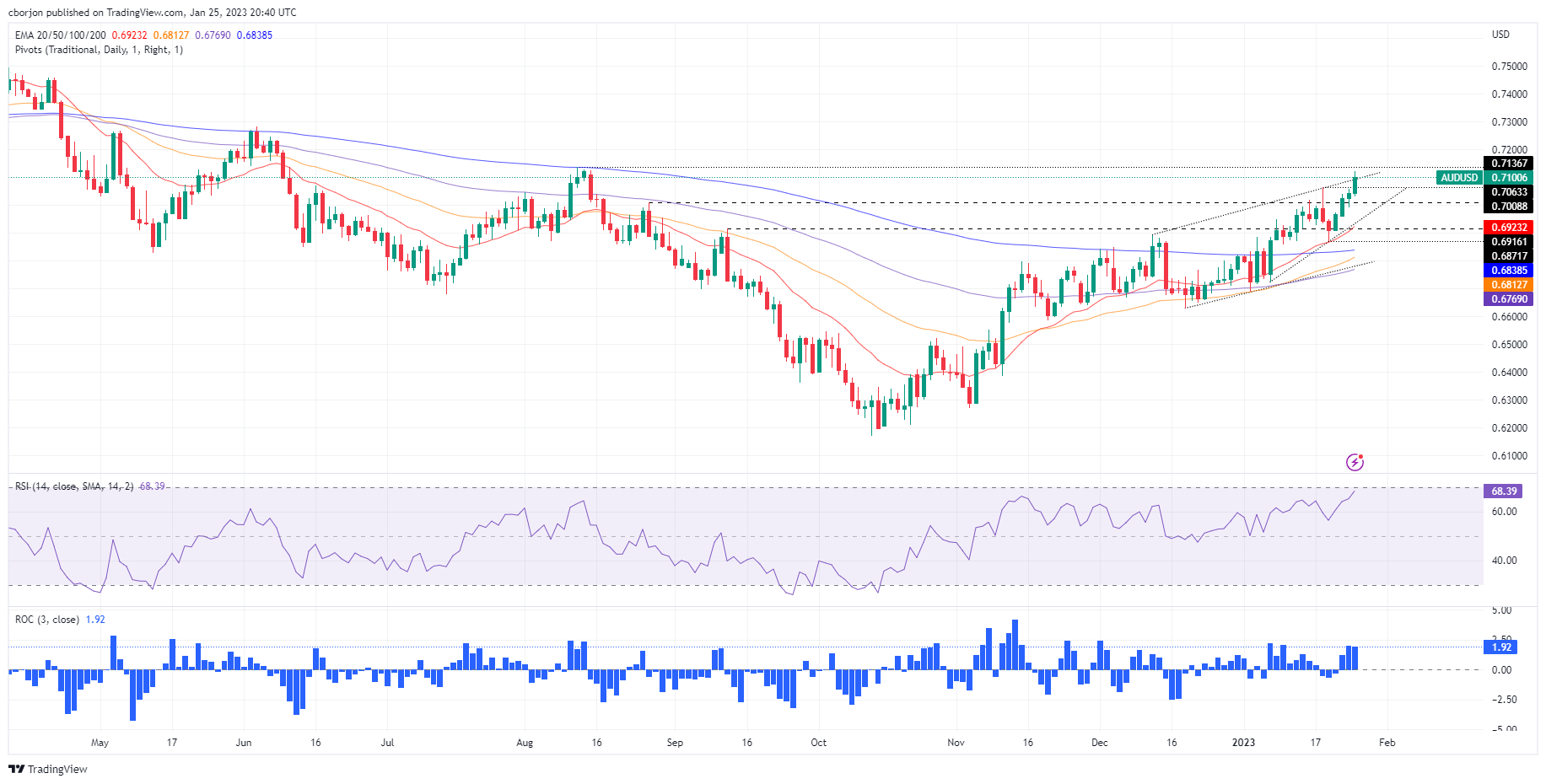
- EUR/USD 1.0950 is a key player in the current market structure.
- The bears need to get below 1.0850 or face continued momentum to the upside.
As per the prior day's analysis, EUR/USD Price Analysis: Bears in play while below 1.0950, and the pre-open analysis at the start of this week, the euro remains within the forecasted schematic and below the 1.0950s ahead of critical data on Thursday and the Federal Reserve next week.
EUR/USD prior analysis
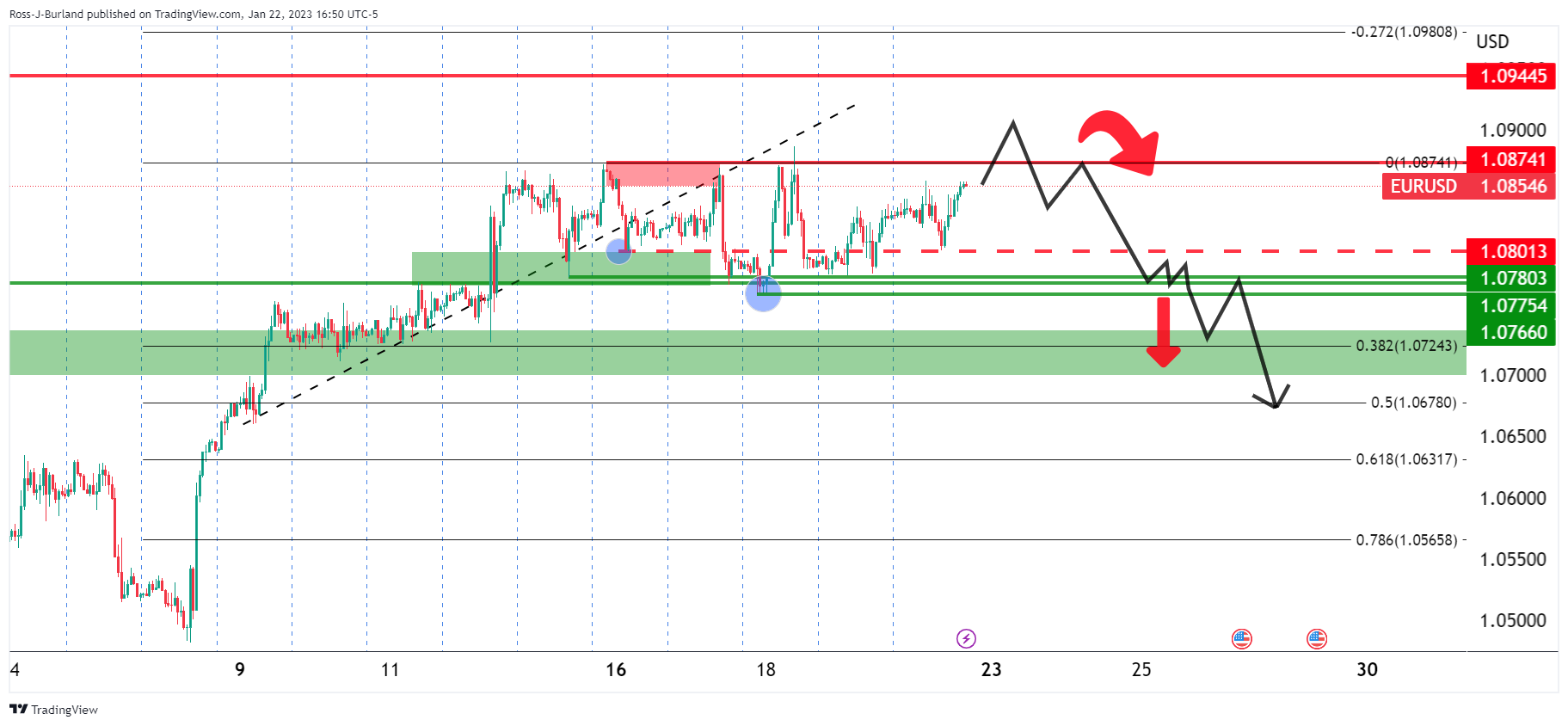
EUR/USD update
The bears are still lurking at key resistance and there are prospects of a blow-off to the downside for the end of the week. If the price were to melt below 1.0850, then that could be a significant development.
However, a test of stops above 1.0950 could be on the card to go high before coming down so the London session could be playing a key role in the build-up to the NY sessions.
- US Dollar bulls are lurking at critical support.
- The weekly bearish impulse coupled come undone in the next days and lead to a bullish correction with the 38.2% Fibonacci eyed around 103.10.
- US data nd the Fed will be key in the next cycle of the greenback.
The US Dollar has been pressured this week leading into the key US data events on Thursday although subdued trading is expected form here as investors will be hesitant to make any moves into Thursday and next week's central bank meetings, including the Federal Reserve and the European Central Bank. At the time of writing, DXY is trading down some 0.25% and has travelled between a high of 102.118 and a low of 101.576.
Key US data on the cards
Earlier in the week, the US dollar got a brief boost due to the S&P Global reporting preliminary January PMI readings. The Manufacturing PMI came in at 46.8 vs. 46.0 expected and 46.2 in December, Services PMI came in at 46.6 vs. 45.0 expected and 44.7 in December, and the Composite PMI came in at 46.6 vs. 46.4 expected and 45.0 in December. ''This suggests some upward potential for ISM PMI readings out next week,'' analysts at Brown Brothers Harriman said.
Meanwhile, the US Commerce Department set to release its initial advance fourth-quarter Gross Domestic Product estimates at the same time that the nation's Core PCE prices will be due, likely accelerating to a 0.3% moM pace in December, though a 0.4% gain can't be discarded, analysts at TD Securities argued. ''The yoY rate likely slowed to 4.5%, suggesting prices continue to moderate but remain sticky at high levels,'' the analysts argued. In regards to the growth data, the analyst said, ''we also look for GDP growth to have stayed strong in Q4, posting another above-trend gain. Growth was likely supported by firm showings from the consumer and inventories.''
Federal Reserve outlook
The markets are pricing in a dovish outcome for the months ahead with regard to the Federal Reserve. US stocks have benefitted as have high better currencies that are enjoying some of their domestic data points as well. The combined sentiment and convergence between the central banks have been pressuring the greenback lower in 2023.
Inflation measures have eased in the US but analysts at Brown Brothers Harriman noted that the labour market remains red hot. We will have the nonfarm Payrolls in the next several days also falling in at the start of each new month where the consensus sees 175k for January. ''While down from 223k in December, hiring remains firm,'' the analysts at BBH argued are arguing for a more hawkish longer outcome from the Federal Reserve.
''WIRP suggests a 25 bp hike on February 1 is fully priced in, with less than 5% odds of a larger 50 bp move. Another 25 bp hike March 22 is about 80% priced in, while one last 25 bp hike in Q2 is only 35% priced in. We think these odds are too low,'' they said. ''Furthermore, the swaps market continues to price in an easing cycle by year-end and we just don’t see that happening.''
US Dollar remains vulnerable to market sentiment
The US Dollar is likely to remain on the back foot until the market sentiment, if ever, switches back to a more hawkish Federal Reserve. This is what makes tomorrow's data so key. Any publication that points more towards 25 than towards 50bp on February 1 will likely be the nail in the coffin for the DXY index that is hanging over the edge of the abyss as the following technical analysis will illustrate. However, it might take a really outsized outcome in the data to really shift gears considering that the market has already lowered its expectations as regards the next rate step by the Fed.
US Dollar technical analysis

As we can see here on the 4-hour chart, 101.59 and 101.30 are key levels guarding against a move lower as per the weekly structure:
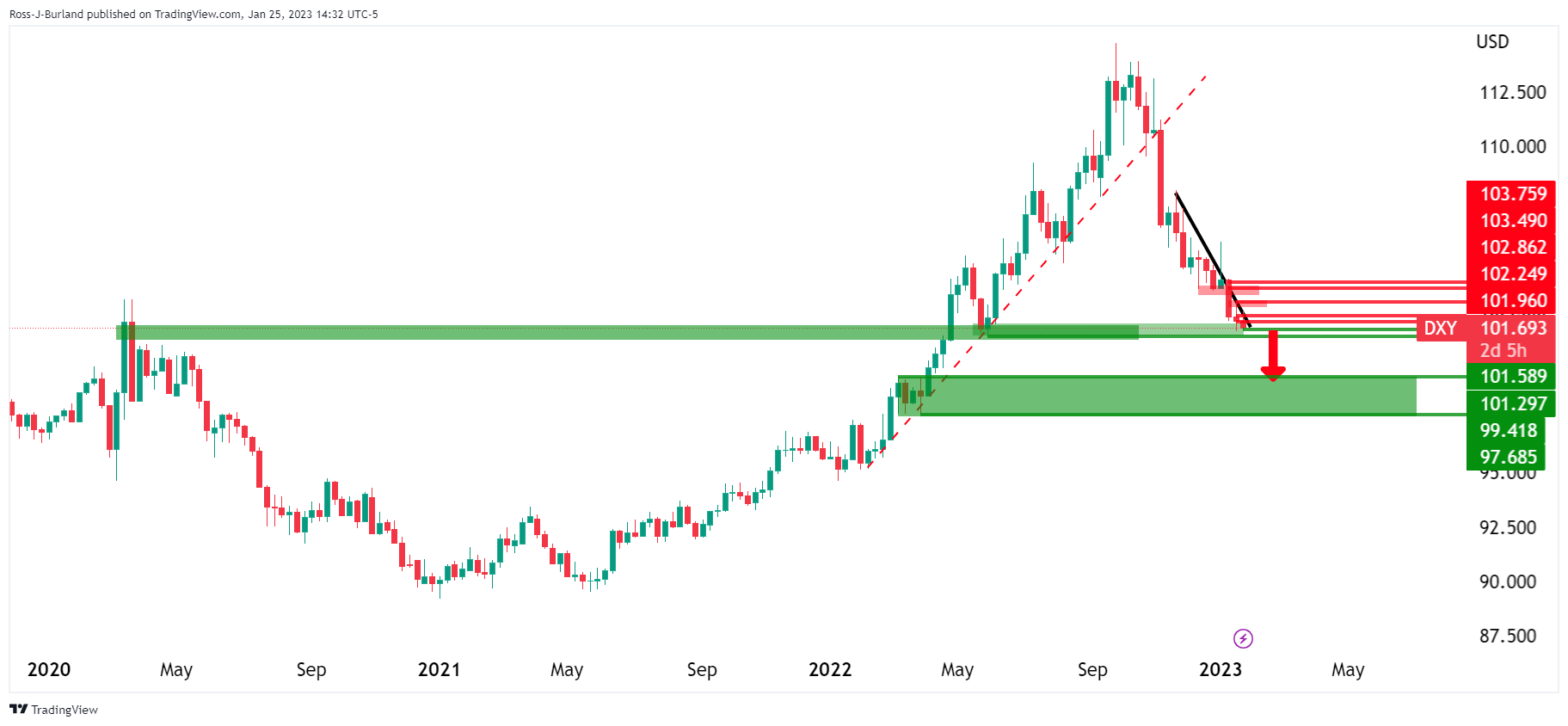
A move to test 100.00 coupled be in store around a dovish Fed. However, it is usual for markets to swing and the current support could be the fuel that is used to ignite a bullish correction and a test of prior supports as follows:
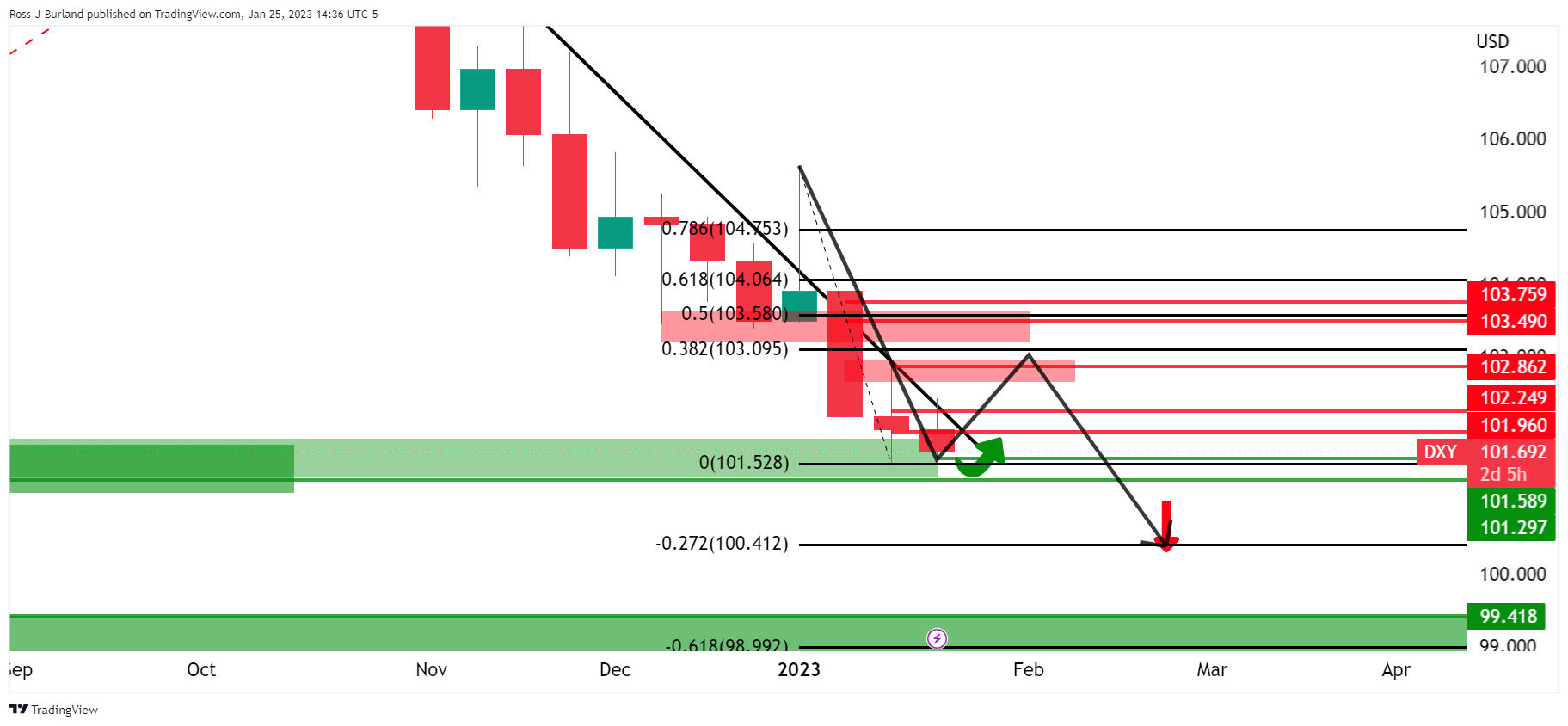
The weekly bearish impulse coupled come undone in the next days and lead to a bullish correction with the 38.2% Fibonacci eyed around 103.10.
- USD/CHF bull’s clashed with the 20-day EMA, then jumped from the boat as bears stepped in.
- The pair is headed toward the psychological 0.9100, which, once broken, could put the YTD low into play.
- USD/CHF: Failure to register a new YTD low could exacerbate an upward correction.
The USD/CHF battles to break above the 20-day Exponential Moving Average (EMA) and slips beneath 0.9200 to fresh two-day lows at 0.9172 as the US Dollar remains offered in the FX space. Also, a risk-off impulse underpins the safe-haven status of the Swiss franc (CHF). Hence, the USD/CHF exchanges hand at 0.9182 after hitting a daily high of 0.9245.
USD/CHF Price Analysis: Technical outlook
The USD/CHF continued its downtrend after hitting a weekly high of 0.9297, unable to reclaim 0.9300, which exacerbated the fall below the 20-day EMA at 0.9241. Also, the path for the USD/CHF pair was opened to test the year-to-date (YTD) lows of 0.9085, though initially, it would need to hurdle demand zones in between.
On its way to the YTD lows, the USD/CHF’s first support level would be this week’s low of 0.9159. Break below will expose the January 20 daily low of 0.9141, ahead of the 0.9100 mark. Once that psychological price level gives way, then the YTD low would be in play.
As an alternate scenario, the USD/CHF first resistance would be the 0.9200 figure. Once cleared, then, the USD/CHF could test the 20-day EMA at 0.9241, followed by a two-month-old downslope trendline around 0.9250/60.
Looking ahead, USD/CHF’s failure to test the YTD low could expose the USD/CHF to some buying pressure, as the pair has been bottoming around 0.9085/0.9160 since December 2022.
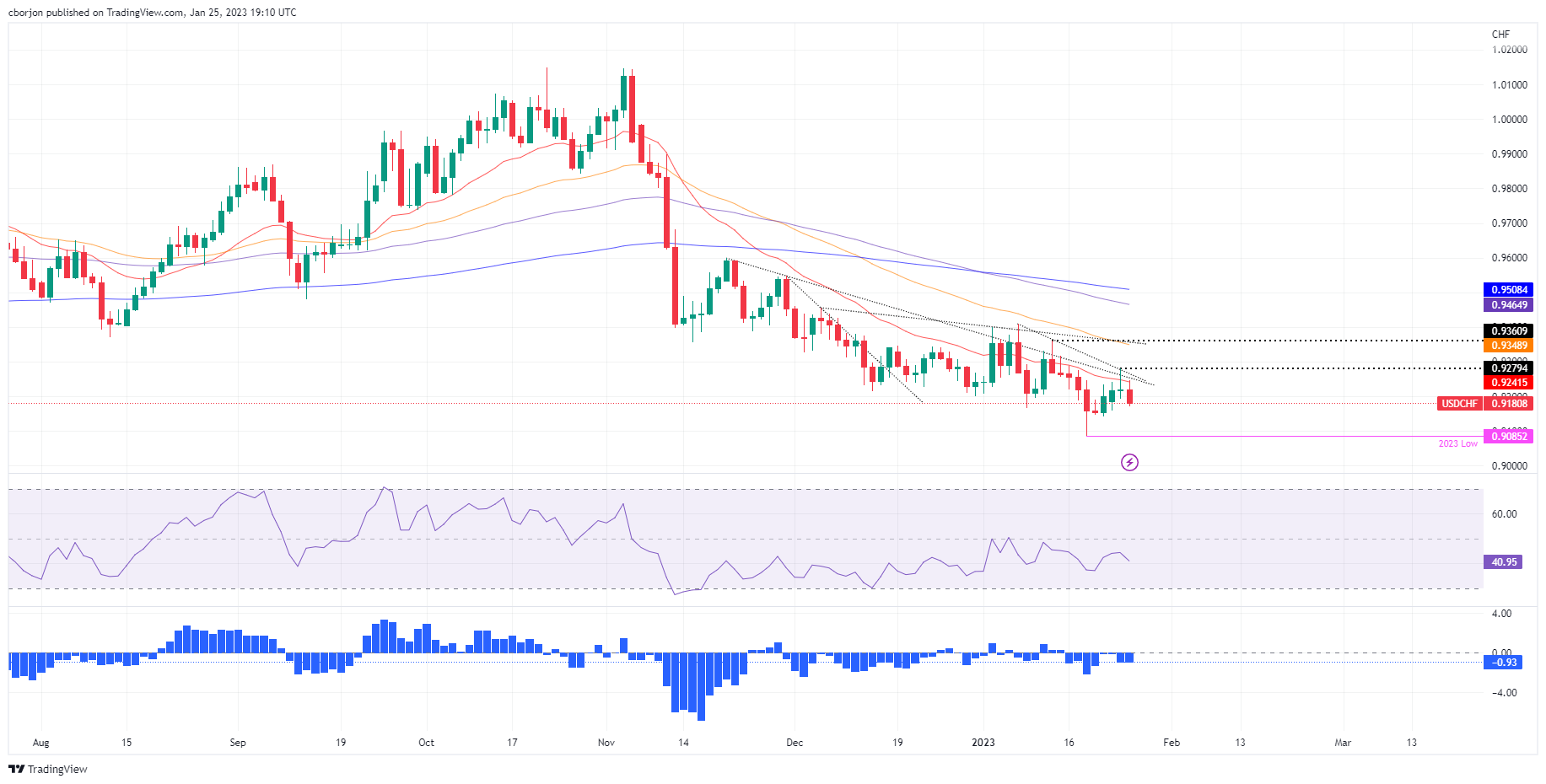
USD/CHF Key Technical Levels
The EUR/USD pair has risen 1200 pips during the last three months. Analysts at MUFG Bank are worried that the balance of risks is no longer as favourable for further upside following the rally. They see the pair trading in the 1.0400 – 1.1300 range over the next weeks.
Pricing in a better cyclical outlook for euro-zone economies
“We are sticking to our bullish bias for the EUR/USD although are more wary now that the balance of risks is no longer as favourable for further upside following strong gains in recent months. The pair has already reversed around three-quarters of the sell-off triggered by the start of the Ukraine conflict between late February and September of last year. Prior to the start of the conflict, EUR/USD was trading between 1.1200 and 1.1500 throughout most of last February.”
“We expect the ECB to deliver another 50bps hike at next week’s policy meeting and continue to signal that at least one more larger 50bps hike is likely at the March policy meeting. We only expect a slowdown in the pace of hikes back to 25bps in Q2 when there is more concrete evidence that inflation pressures are easing. It stands in contrast to our expectation for the Fed to further slow the pace of rate hikes by delivering a 25bps hike at next week’s FOMC meeting. We then expect the Fed to pause rate hikes in Q2 but are not expecting the Fed to signal yet that they will pause hikes soon. The Fed’s still relatively hawkish plan for further hikes beyond next week could help to dampen the USD selling pressure for now.”
“There are a number of key downside risks to our bullish EUR bias in the month ahead including: i) the ECB signals it is more open to slowing the pace of hike at the March policy meeting ii) the recent resilience of the euro-zone economies proves to be misleading/short-lived and growth slows sharply with more of lag than expected, and iii) geopolitical tensions between the West and Russia escalate further after tanks are sent to support Ukraine which alongside a pickup in demand from China demand lifts European energy prices.”
The greenback has already embarked on a prolonged period of depreciation that could last into 2024, warn analysts at Wells Fargo. They point out that the relative economic growth performance, and monetary policy outlook have turned less supportive of the US dollar.
No longer forecasting USD strength early this year
“The U.S. dollar has embarked upon a prolonged period of depreciation. Relative growth and monetary policy fundamentals have become less supportive of the greenback. We expect U.S. dollar depreciation to be gradual in early 2023 as the U.S. falls into recession during the second half of this year, but the Federal Reserve hesitates from lowering interest rates prematurely.”
“We expect the U.S. dollar's depreciation to gather pace in 2024 since, even as the U.S. economy begins stabilizing, we believe the Fed will start cutting interest rates quite aggressively starting early next year. From current levels, we forecast the Fed's trade-weighted dollar index versus advanced foreign economies to soften 3% by the end of 2023, and by a cumulative 8.5% by the end of 2024.”
- USD/CAD stop hunt is underway and the bears are eyeing the prior support structures.
- A 38.2% and 61.8% Fibo retracement is on the cards.
USD/CAD has started the stop hunt in the new hour following the conclusion to the Bank of Canada's red calendar event on Wednesday and ahead of key US data on Thursday.
The following illustrates the price action through the event and the move into in-the-money-longs that could continue all the way into the Fibonacci scale, with the 38.2% and 61.8% ratios eyed.
USD/CAD MTF analysis
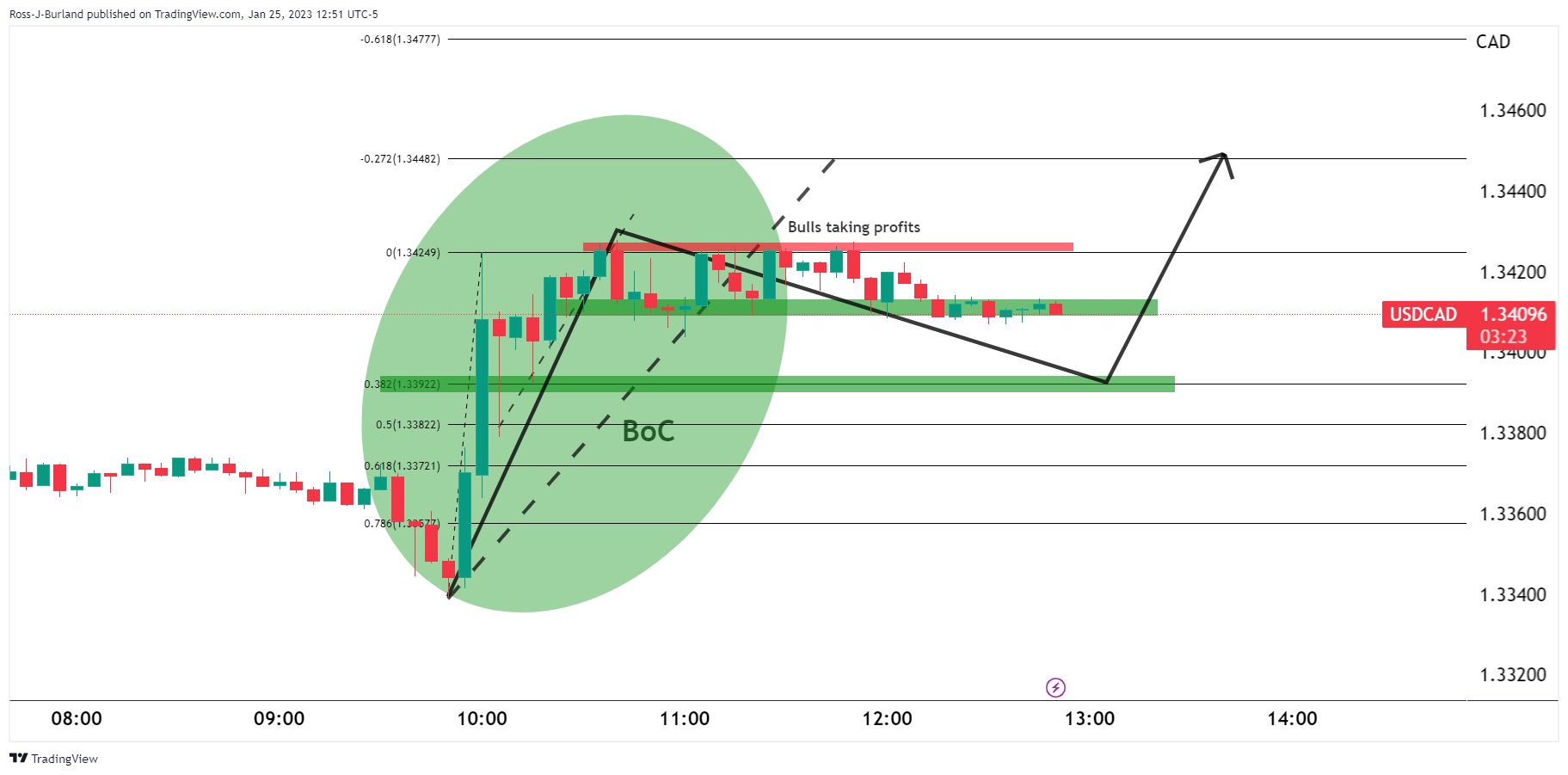
Before the new hour, the above schematic was playing out bearish due to failures to run higher through resistance and sliding to the backside of the bullish trendline support.
USD/CAD daily charts
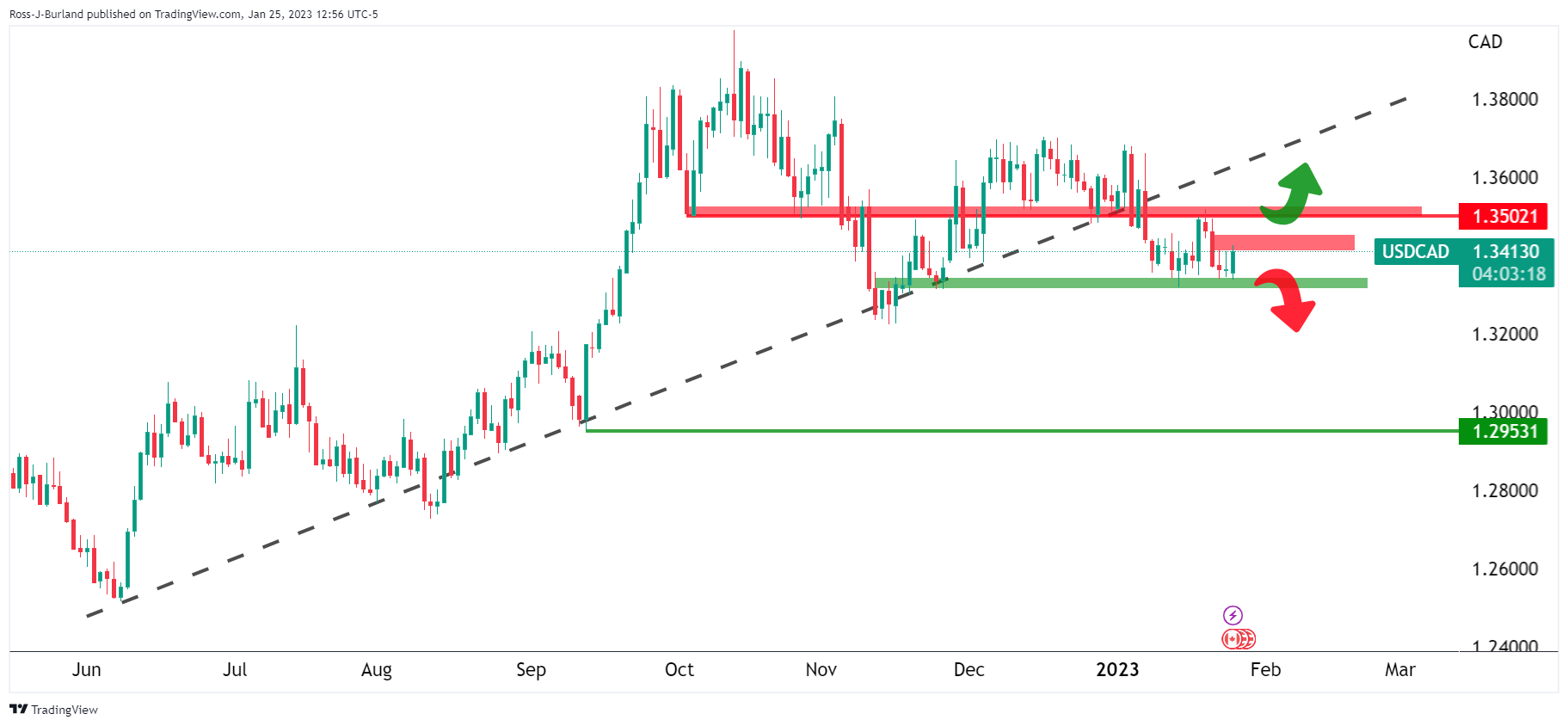
That does not mean that there would not be prospects of a bullish breakout as per the above daily chart. There are prospects of a move higher following a stop hunt:
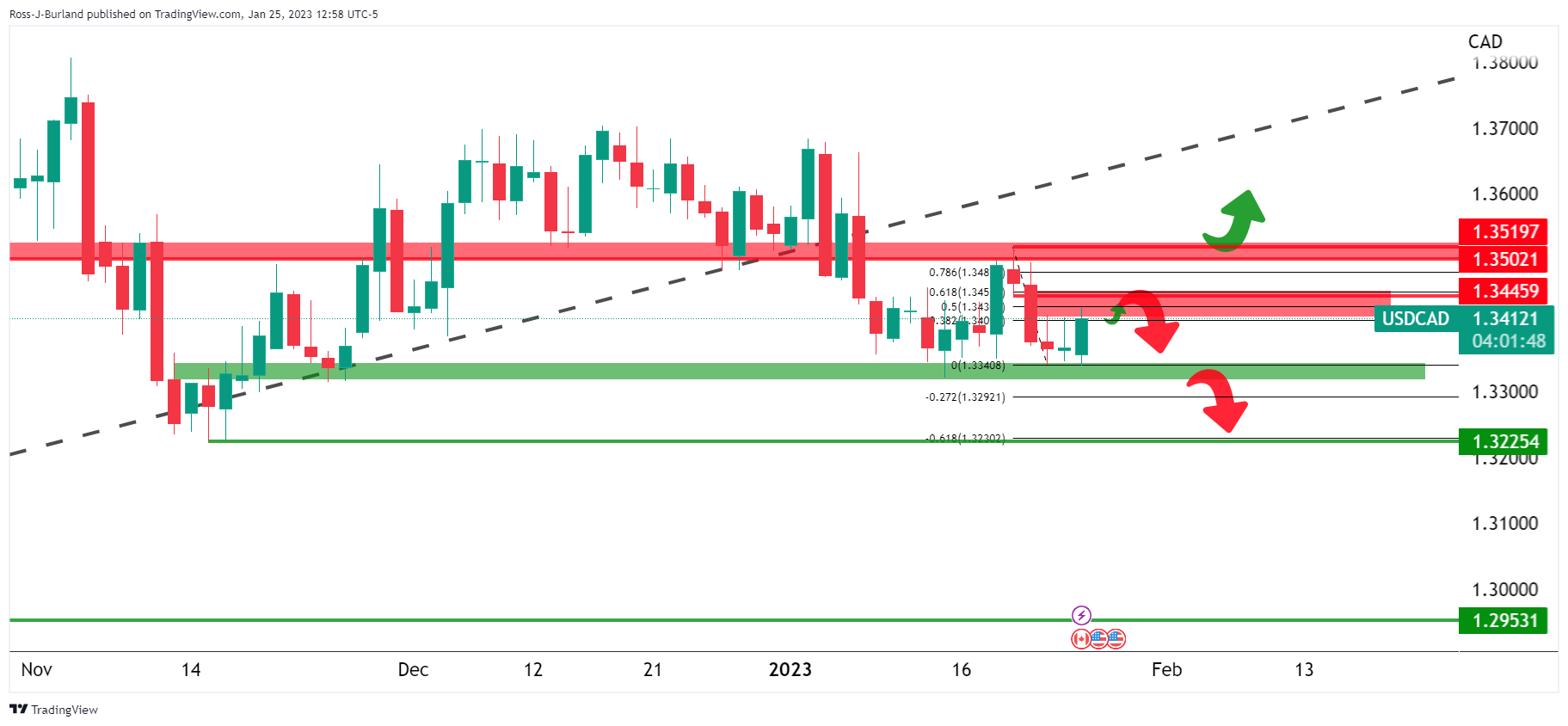
USD/CAD H1 charts
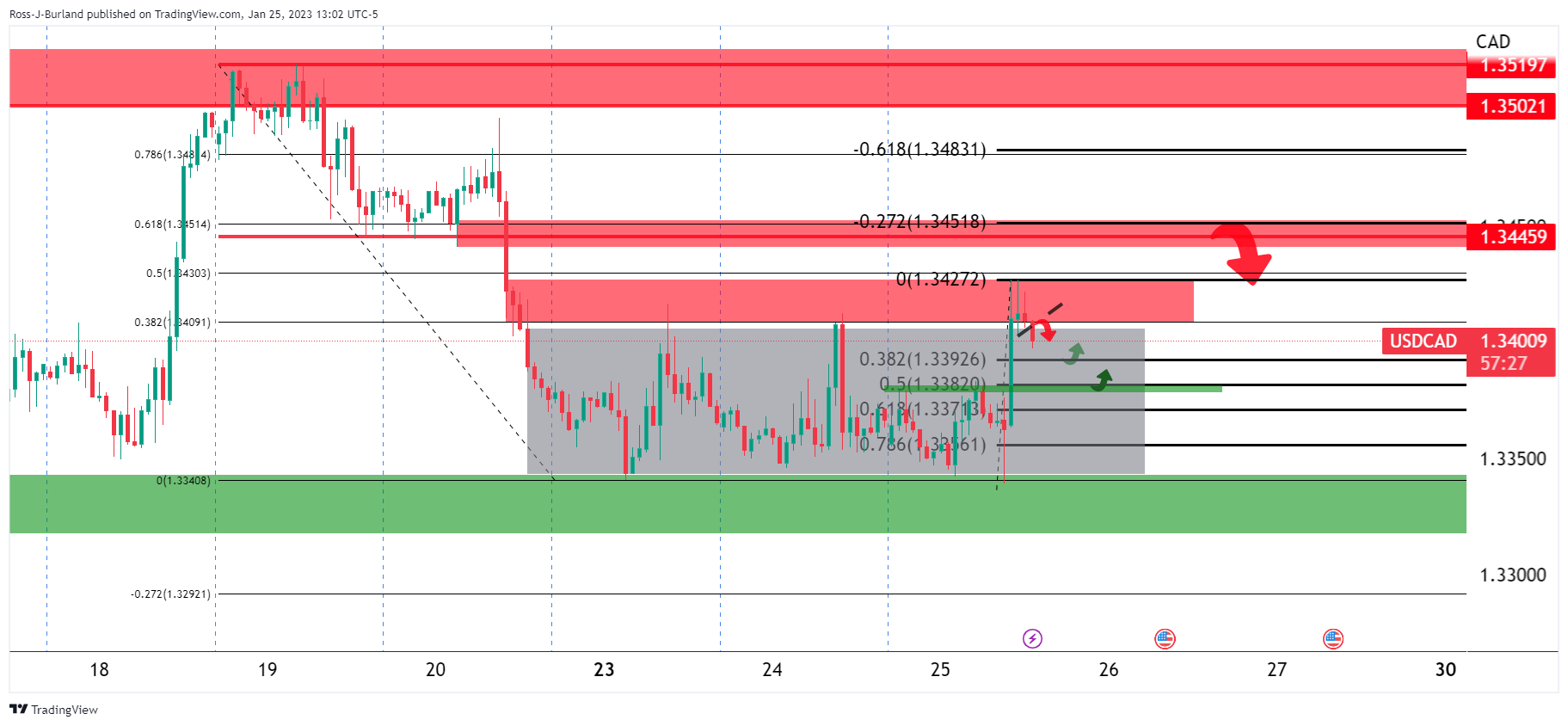
The price is trapped in a box (greyed area) between resistance and support. The BoC rally was decelerating into a triangle and a breakout was inevitable with the path of least resistance to the downside:
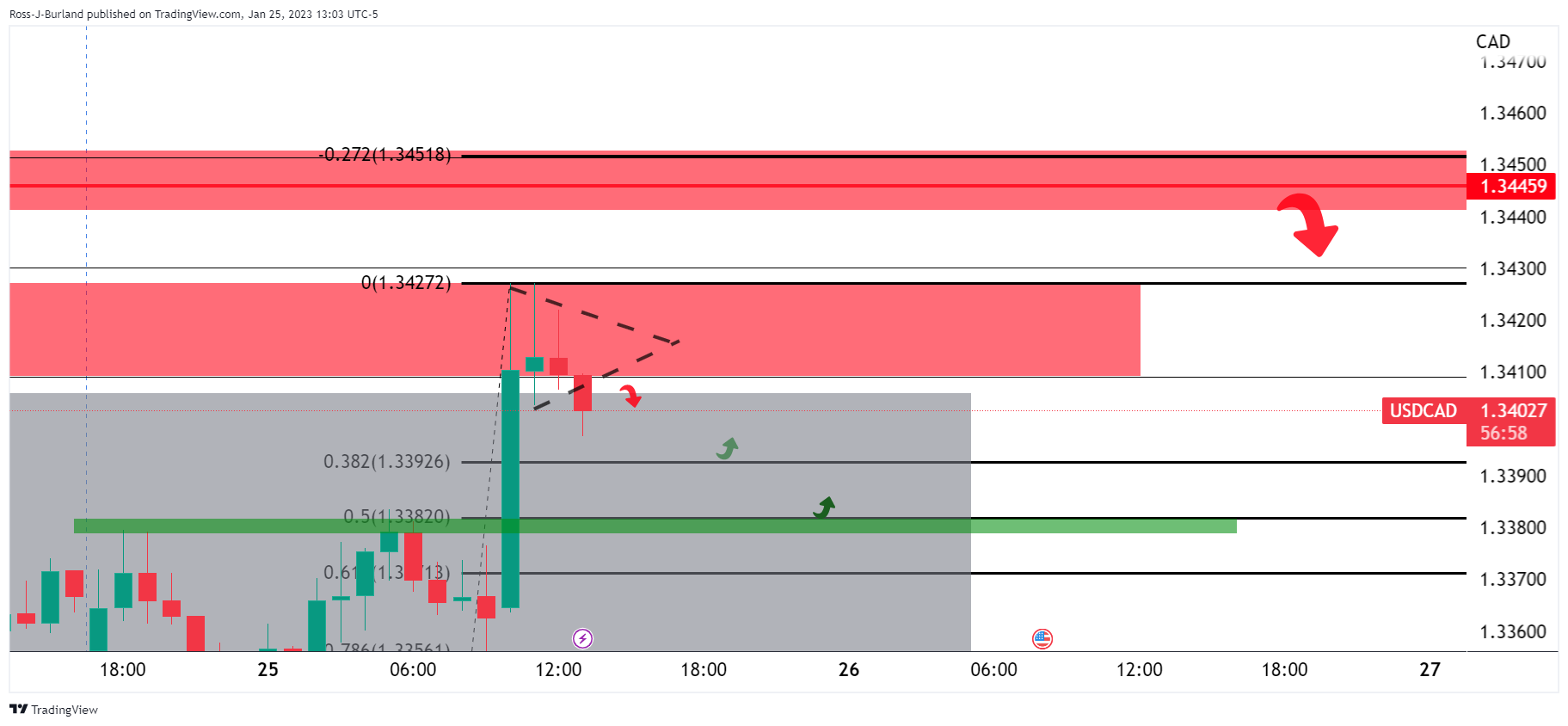
The stop hunt is underway as seen above. The Structures are as follows as per the 5-min chart:
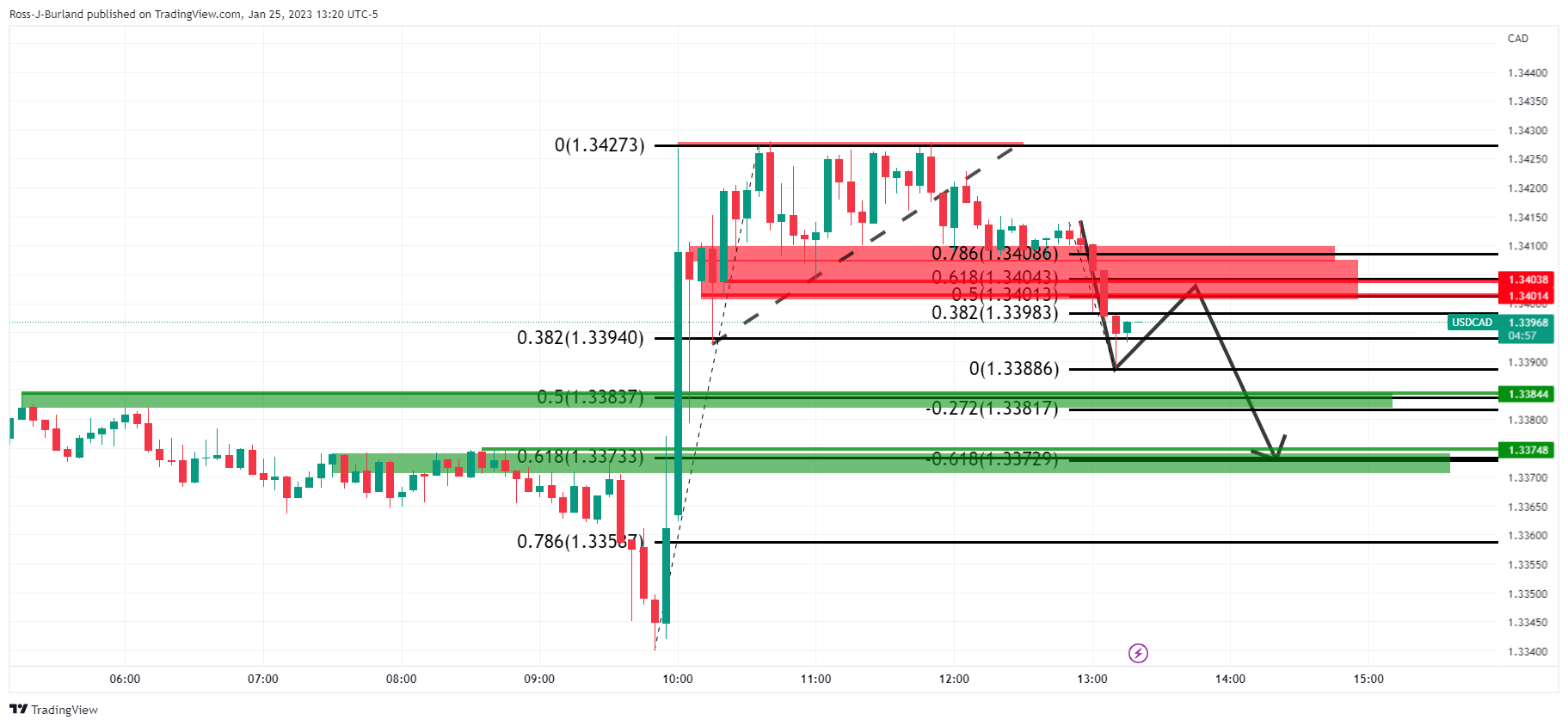
The January meeting of the Bank of Canada resulted, as expected, in a 25 basis points rate hike. BOC's Tiff Macklem said it is time to pause and assess whether the policy is sufficiently restrictive. Analysts at CIBC expect that interest rates will stay at 4.5% throughout the balance of this year, before being eased gradually in 2024.
BoC moves onto the sidelines
“The Bank of Canada hiked interest rates one more time, but gave a more explicit signal than anticipated that it was now moving onto the sidelines. The 25bp increase, taking the overnight rate to 4.5%, was well anticipated by the consensus. However the change in guidance was not, with the Bank now explicitly stating that if the economy evolves as it expects, then the policy rate will be kept on hold at its current level.”
“With the Monetary Policy Report's forecasts for GDP growth and inflation little changed from October and a touch stronger than our own, we suspect that the economy will indeed evolve in-line or even a bit weaker than the Bank suspects, and that today's hike in interest rates will mark the final one of this cycle.”
“We had expected that today's 25bp move would be the final one for this cycle, and the change in the Bank's guidance only reaffirms that belief. Even though there is still a slight bias within its communication towards raising interest rates further, today's statement suggests that the Bank will sit on the sidelines for now and wait for the accumulation of a few month's worth of data rather than necessarily reacting to near-term surprises.”
- GBP/USD bounces off weekly lows and reclaims 1.2300 on a soft US Dollar.
- The Producer Price Index in the UK cools down, sparking speculation that the Bank of England could tighten but not as aggressively as foreseen.
- Thursday’s US economic docket would feature GDP, unemployment claims, Durable Good Orders, and core PCE.
The GBP/USD solidly climbs and trims two days of consecutive losses after hitting a weekly low of 1.2263 on Wednesday. Risk aversion is the game’s name, while the US Dollar (USD) is pairing some of its earlier losses, underpinned by US bond yields rising. The GBP/USD is trading at 1.2384, clinging to gains of 0.42%.
UK's Producer Price Index eases, ahead of the BoE's next week meeting
During the European session, the GBP/USD slid to the lows of the day at 1.2282 amidst news that the UK’s Producer Price Index (PPI) for December cooled the most since April 2020, which would ease pressures for the Bank of England (BoE). Input prices paid by factories dropped -1.1% MoM, while the year-over-year data dropped 1.5% from 18% to 16.5%. Regarding Output prices, it fell -0.8% MoM beneath estimates for a 0.1% gain, while on an annual basis, it fell to 14.7% from 16.2%.
Therefore, speculations that the BoE would reassess how much tightening is needed to curb inflation weakened the GBP/USD. Additionally, weaker than-estimated UK PMIs for December, revealed Tuesday, sparked recessionary fears.
Meanwhile, the greenback has continued to weaken across the G8 FX board, as shown by the US Dollar Index, down 0.15%, staying at 101.767. Contrarily, US Treasury bond yields, paired with earlier losses, sit at 3.465%.
Aside from this, traders are bracing for a busy Thursday’s round of US economic data to be unveiled. The US economic docket will feature the Advance in Gross Domestic Product (GDP) for Q4, expected at 2.6%. Further, Durable Good Orders are expected to recover to 2.5%, compared to last month’s -2.1% plunge. Unemployment claims for the last week would also be updated, along with the US Federal Reserve Core PCE inflation reading.
Therefore, with money market futures chances at 75% of witnessing a 50 bps rate hike at the BoE meeting, further GBP/USD upside is expected.
GBP/USD Key Technical Levels
The USD/JPY pair is trading back under 130.00 after being unable to break above 131.00. Analysts at MUFG Bank have a neutral bias on the pair and see it trading in the range 127.00-134.00 over the next weeks.
We may have entered a short-term equilibrium zone
“It is important to stress that the BoJ speculation has played a secondary role when the overall drop of 20 big figures in USD/JPY is considered. The global fundamental backdrop and the intervention by the Japanese authorities combined to give a powerful impetus for a correction lower. A turn in US inflation to the downside, the approach of the expected end to monetary tightening outside of Japan and the collapse in energy prices are all JPY-supportive developments.”
“YCC policy speculation may pick up again. The primary candidates to take over from Governor Kuroda (Amamiya, Nakaso & Yamaguchi) are all expected to move away from ‘Abenomics’ (to differing degrees) which means speculation could well pick-up later in Q2.”
“We have narrowed the range for USD/JPY in the month ahead and assume the big move over the last three months will result in some narrower range trading. An announcement that Hirohide Yamaguchi would be put forward to the Diet could spark a bigger FX move as abrupt YCC changes would be brought forward by the markets. That would imply a sharper move to the downside than expected. To the upside, a 50bp hike by the Fed and a more hawkish FOMC communication would see a larger than expected move to the upside.”
Following the Bank of Canada's (BOC) decision to raise the policy rate by 25 basis points to 4.5%, BoC Governor Tiff Macklem delivers his remarks on the policy outlook and responds to questions from the press.
Key takeaways
"We will be looking for accumulation of evidence to raise rates again."
"It is far too early to be talking about interest rate cuts."
"Finance minister has told me the Bank of Canada will be allowed temporarily to retain earnings for the purpose of covering losses."
- USD/JPY remained pressured as the 50-DMA crossed beneath the 200-DMA.
- Bears stepped in and reclaimed 130.00, as they eye 129.00.
USD/JPY fell as the North American session progressed and tumbled below the 130.00 figure, as buyers failed to crack the 20-day Exponential Moving Average (EMA) at 130.74. Factors like a soft US Dollar (USD) and falling US Treasury bond yields are two fundamental reasons for renewed Japanese Yen (JPY) strength. At the time of writing, the USD/JPY is trading at 129.77.
USD/JPY Price Analysis: Technical outlook
Tuesday’s session was characterized by the USD/JPY reaching a weekly high at 131.11, slightly above the 20-day EMA, but dropped to 130.10. Today, the USD/JPY hit a daily high of 130.58 but extended its losses, while the 50-day Exponential Moving Average (EMA) crossed beneath the 200-day EMA, meaning a death cross emerged in the daily, suggesting that further downside is expected.
Oscillators like the Relative Strength Index (RSI) and the Rate of Change (RoC) aim downwards, supporting lower prices.
Therefore, the USD/JPY first support would be the day’s low of 129.26. Break below will expose the 129.00 psychological level, followed by the January 20 swing low at 128.34 and the YTD low of 127.21. As an alternate scenario, if the USD/JPY reclaims 130.00, the pair could challenge the 20-day EMA.

USD/JPY Key Technical Levels
Following the Bank of Canada's decision to raise the policy rate by 25 basis points to 4.5%, Bank of Canada (BoC) Governor Tiff Macklem delivers his remarks on the policy outlook and responds to questions.
Key takeaways
"Bank of Canada has raised rates rapidly, now it's time to pause and assess whether monetary policy is sufficiently restrictive."
"This is a conditional pause, dependent on the economy developing broadly in line with forecasts."
"If we need to do more to get inflation to the 2% target, we will; if upside risks materialise we are prepared to raise rates further."
"We are turning the corner on inflation, but are still a long way from our target."
"Economic growth and spending in H2 2022 were stronger than forecast, our overheated economy did not cool as much as we had expected."
"Lower gasoline prices are welcome but prices of essentials continue to rise too quickly."
Os Tuesday, Gold XAU/USD registered its highest daily close since April. Strategists at Credit Suisse expect the yellow metal to enjoy further gains.
Initial support aligns at $1,897
“Gold is expected to extend its rally to resistance next at the 78.6% retracement of the 2022 fall and April 2022 high of $1,973/98, with a fresh cap expected here.”
“Only above the $,2070/75 record highs of 2020 and 2022 would suggest we are seeing a significant and meaningful long-term break higher with resistance levels then seen at $2,300, then $2,500.”
“Support is seen at $1,897 initially, below which can see a pullback to $1,825.”
Markets are off to a solid start in 2023. Global equities (MSCI All Country World Index) have gained 5.1% year-to-date, with Europe’s Stoxx 50 climbing 8.6% and the S&P 500 rising a more modest 3.5%. The big question now is whether the rally will prove durable, economists at UBS report.
S&P 500 price targets are 3,700 and 4,000 for June and December
“We don't see much scope for markets to rally in the near term, especially given our outlook for continued pressure on corporate profit growth.”
“Our June and December S&P 500 price targets are 3,700 and 4,000, respectively, versus 3,972 at the end of last week.”
AUD/USD has regained the position of best-performing G10 currency in the year to date. The pair is expected to suffer a drop by the middle of 2023 but economists at Rabobank have edged up their 0.75 target to 12 months from 15 months.
Market will price out expectations of a Fed rate cut before the end of 2023
“We continue to expect the AUD to perform well this year relative to a basket of G10 currencies. That said, we look for a dip in the value of AUD/USD around the middle of the year. This is linked with our expectation that the market will price out expectations of a Fed rate cut before the end of 2023.”
“We have edged up our AUD/USD forecast and have brought forward our 0.75 target to 12 months from 15 months.”
- Gold price slides despite US Dollar weakness and falling US Treasury bond yields.
- Analysts said a technical move or profit-taking could be behind the XAU/USD’s fall.
- Risk aversion is the primary driver of price action on Wednesday.
- Gold Technical Analysis: Stills upward biased, though headed for a correction before resuming the uptrend.
Gold snaps two days of gains and retreats from weekly highs reached around $1942.51, stumbles beneath the $1940 figure amid a risk-off impulse that weighed on safe-haven assets, including the US Dollar (USD). US Treasury bond yields are also edging lower in a gold move that appears to be driven by profit-taking. At the time of writing, the XAU/USD exchanges hands at $1,933.00
Sentiment remains sour, weighed by earnings and US companies lowering forecasts
Wall Street extends its losses at the open, following a warning that Microsoft sales in cloud services might slow down. Other big tech companies are feeling the pain of higher interest rates in the United States (US) as the US Federal Reserve (Fed) tightened 400 basis points, its monetary policy, since March 2022, to curb high inflationary pressures. Nevertheless, the next week’s monetary policy decision, with financial markets widely expecting a 25 bps rate hike to the Federal Funds rate (FFR), could continue to weigh on the greenback.
The US Dollar Index (DXY), a gauge for measurement of the buck’s value vs. a basket of peers, losses 0.10% down at 101.828, undermined by a gloomy economic outlook in the US. The US 10-year Treasury bond yield eases one and a half bps and yields 3.44%.
The World Bank and Swiss Federal Office for Customs and Border Security reported Swiss exports of gold to China surged in 2022, at 478 metric tons. That’s up from 274 tons in 2021.
In the meantime, the US economic docket for Thursday would be busy, led by the Advance in Gross Domestic Product (GDP) for Q4, expected at 2.6%. Further, Durable Good Orders are expected to recover to 2.5%, compared to last month’s -2.1% plunge. Unemployment claims for the last week would also be updated, along with the US Federal Reserve Core PCE inflation reading.
Gold Technical Analysis
Technically speaking, XAU/USD is consolidating around the $1,910-$1,940 range during the last three trading sessions, unable to crack the $1,950 mark. Of note, the Relative Strength Index (RSI) continues at overbought territory, while the Rate of Change (RoC) retraces from its peak of the week, suggesting that buying pressure is waning. Hence, the Gold price might pull back in the near term before resuming its uptrend.
XAU/USD key support levels are $1,900, followed by the $1,896.74 January 18 daily low. Break below will expose the 20-day Exponential Moving Average (EMA) at $1,889.22. On the other hand, for an uptrend continuation, XAU/USD needs to reclaim $1,950 as it aims to rally toward $2,000.
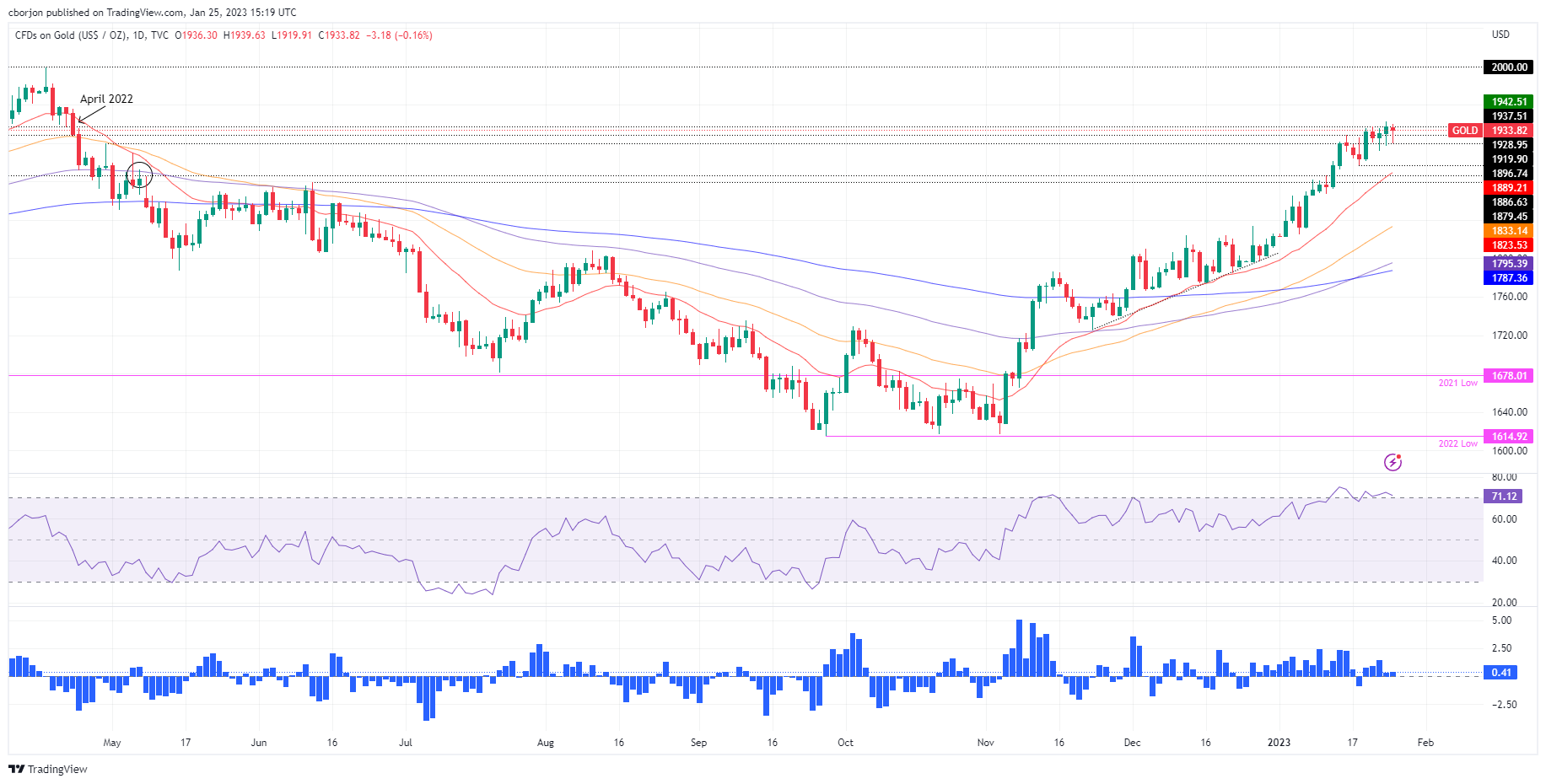
- Bank of Canada rises rates as expected, expects to hold now.
- Loonie weakens after the announcement.
- USD/CAD jumps but then pulls back toward 1.3400.
The USD/CAD jumped by more than 50 pips after the decision of the Bank of Canada and climbed to 1.3425, reaching the highest level since last Friday.
No more hikes?
The Bank of Canada, as expected, raised the key interest rate by 25 basis points to 4.5%. In the statement, the central banks mentioned that will likely hold rates at this level while assessing the impact of recent policy moves.
Following the announcement, the Loonie weakened across the board. The USD/CAD rose from 1.3365 to 1.3426. It then pulled back. Loonie’s crosses remain volatile as market participants digest the decision.
The BoC signals that its intention is to remain on hold which is not a surprise for markets. Analysts were considering that the hike at the January meeting could be the last one, taking into account the current economic outlook.
The USD/CAD retreated under 1.3400 after a few minutes. More volatility is expected. The pair needs to remain well above 1.3400 to keep the doors open to more gains over the next hours. The next resistance stands at 1.3440. The key support is the 1.3340 area and a break lower could trigger a bearish acceleration toward 1.3300.
Technical levels
The current row about the US debt ceiling is slowly becoming an issue for FX analysts. It has always worked out in the end, nonetheless, from the point of view of Ulrich Leuchtmann, Head of FX and Commodity Research at Commerzbank, there are reasons why we should not ignore the debt-ceiling issue completely.
How to deal with the US debt ceiling event risk?
“In conversations, I am often told: it has always worked out in the past; the debate about the debt ceiling is part of the US political foofaraw, in the end an agreement is always reached. And indeed, I tend to agree with that point of view.”
“And please do not believe that the USD levels would correctly reflect this event risk! How risks are valued on the market depends on the risk profile of the ‘average market participant’. At first glance that is a rather hazy concept, but the formal definition is not trivial, and for our purposes a rough idea is quite sufficient.”
“It is not a case of creating a panic if I suggest keeping an eye on the event risk of fiscal chaos in the US and the possible USD negative effects if you are going to enter USD longs. Even if it is likely that it will all end well yet again.”
- Euro supported by ECB monetary policy expectations.
- Pound attempts to recover ground.
- EUR/GBP with bullish bias, near strong barriers.
The EUR/GBP is trading flat, hovering around 0.8815, after rising for three consecutive days. The cross peaked at 0.8851, the highest level in a week before pulling back.
The Euro continues to receive support from European Central Bank’s officials who talk about the need to continue rising interest rates significantly. The latest round of economic data favors that perspective. The Eurozone PMIs surpassed expectations.
On Wednesday, the IFO business climate was released. For January the headline came in slightly below market consensus at 90.2 while the expectations index came in at 86.4. “While the outlook has brightened somewhat, the IFO readings suggest that this is starting to top out and so upside economic risks are likely limited, at least for now”, mentioned analysts at Brown Brother Harriman.
The cloudy outlook for the UK economy still weighs on the Pound. Still, the Bank of England is still seen raising rates at their next meeting.
At the 20-day SMA
The EUR/GBP is hovering at a critical area, around 0.8810/15 which contains the 20-day Simple Moving Average. If it manages to consolidate above, the Euro could gain momentum toward the next resistance at 0.8855/60, the last protection for another test of 0.8895/0.8900.
On the flip side, a daily close below 0.8790 should be a positive development for the Pound suggesting a deeper slide probably to the next support around 0.8740.
EUR/GBP daily chart
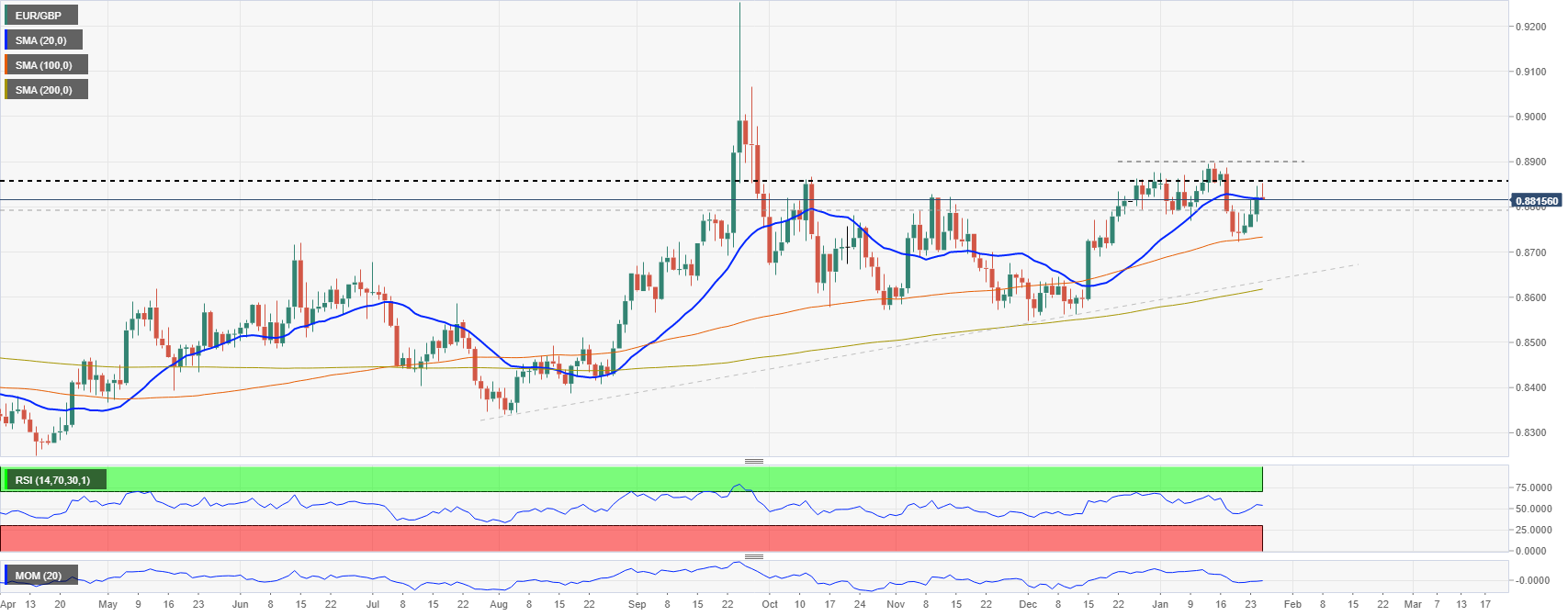
The Bank of Canada (BoC) announced on Wednesday that it hiked its benchmark interest rate by 25 basis points to 4.5% following the January policy meeting. This decision came in line with the market expectation.
In its policy statement, the BoC noted that it is likely to hold the rate at this level while assessing the impact of cumulative rate hikes.
Market reaction
With the initial reaction, USD/CAD rose sharply and was last seen rising 0.35% on the day at 1.3415.
Key takeaways from policy statement
"Global growth seen declining from 3.6% in 2022 to 1.9% in 2023; US growth to slow to 2.0% in 2022 and 0.5% in 2023."
"Output gap in Q4 was between 0.50% and 1.50%, down from upwardly revised 0.75% to 1.75% in Q3."
"3-month measures of core inflation have come down, suggesting core inflation has peaked."
"Prepared to increase policy rate further if needed to return inflation to 2% target; continuing the quantitative tightening program."
"There is growing evidence that restrictive economic policy is slowing activity, especially household spending."
"Financial conditions remain restrictive but have eased since October; C$ has been relatively stable vs US$."
"Global inflation remains high and broad-based."
- EUR/USD rebounds from earlier lows near 1.0860 on Tuesday.
- The German 10-year Bund yields drop to 3-day lows.
- Germany’s Business Climate improved in January.
The European currency now looks to extend the bounce off earlier lows in the 1.0860/55 band vs. the greenback and lifts EUR/USD back to the boundaries of 1.0900 the figure on Wednesday.
EUR/USD refocuses on the 1.0900 barrier
EUR/USD so far advances for the sixth session in a row in a context dominated by alternating risk appetite trends, as investors – and global assets in general – remain prudent ahead of the upcoming FOMC and ECB events next week.
Further support for the euro came once again from hawkish comments from ECB rate setters, this time Board members Makhlouf and Vasle, who advocated for half point rate raises and favoured staying in the restrictive territory for a while.
Also collaborating with the optimism around the euro and reinforcing the view that Germany – and the Euroland – could avoid a recession, the German Business Climate improved to 90.2 during January.
Across the pond, the MBA Mortgage Applications expanded 7.0% in the week to January 20.
What to look for around EUR
EUR/USD flirts once again with the 1.0900 neighbourhood following recent 9-month peaks (January 23).
In the meantime, price action around the European currency should continue to closely follow dollar dynamics, as well as the potential next steps from the ECB and the Federal Reserve.
Back to the euro area, recession concerns now appear to have dwindled, which at the same time remain an important driver sustaining the ongoing recovery in the single currency.
Key events in the euro area this week: Germany Ifo Business Climate (Wednesday) – Italy Business Confidence (Thursday) – France Consumer Confidence, ECB Lagarde (Friday).
Eminent issues on the back boiler: Continuation of the ECB hiking cycle amidst dwindling bets for a recession in the region and still elevated inflation. Impact of the war in Ukraine and the protracted energy crisis on the bloc’s growth prospects and inflation outlook. Risks of inflation becoming entrenched.
EUR/USD levels to watch
So far, the pair is gaining 0.12% at 1.0895 and faces the next up barrier at 1.0926 (2023 high January 23) followed by 1.0936 (weekly high April 21 2022) and finally 1.1000 (round level). On the flip side, the breakdown of 1.0766 (weekly low January 17) would target 1.0576 (55-day SMA) en route to 1.0481 (monthly low January 6).
Mexico is near the end of the tightening cycle. Thus, economists at CIBC Capital Markets would not chase the current USD/MXN downward trend from current levels.
Reaching the end of the tightening cycle
“Although we agree with Banxico’s governor Jonathan Heath view on the need for at least another 25 bps rate increase given above target core and headline inflation, we see Banxico moving to a data dependent stance next month as CPI comes in slightly below the most recent central bank forecast, likely ending it tightening cycle at 10.75%.”
“Note that the market continues to price aggressive rate cuts during the second half of 2023, bringing the overnight rate closer to 9.25%-9.50% by the end of the year. Hence, though recently breaking lower and pointing to its prepandemic level (18.50-18.52), we would not chase the current USD/MXN downward trend from current levels.”
“Q1 2023: 20.00 | Q2 2023: 21.00 (USD/MXN)”
USD/JPY continues to trade in a relatively tight range above 130.00 as market participants try to figure out how the Bank of Japan's (BoJ) monetary policy will be shaped when the new governor takes over. Economists at Rabobank see the pair at 128 on a three-month view.
There is likely scope for some change in BoJ policy in the coming months
“In the next few weeks, PM Kishida will nominate the next BoJ governor. This may bring its own set of surprises insofar as there is a possibility that speculators may have to accept that the outlook of the new governor may not be drastically different from the old. In our view, there is likely scope for some change in BoJ policy in the coming months. However, this may not be substantial.”
“On the assumption that the BoJ’s yield curve control policy is tweaked in the spring, we are forecasting USD/JPY at 128 on a three-month view but expect volatility around the March policy meeting given the risks that policy is again left unchanged.”
Silver price (XAG/USD) remains depressed. Economists at TD Securities expect the precious metal to stay under pressure.
Beginning of a reversal lower across precious metals
“In the absence of behemoth Chinese purchases, CTA trend follower liquidations in Silver are likely to weigh on prices.”
“We expect weakening upside momentum to spark a selling program as large as -8% of the funds' maximum historical position size, but a break above the $23.72 range could result in a more modest flow totaling -4% of this cohort's max size. This follows the deterioration in precious metal trend signals in Platinum, and could be hinting at the beginning of a reversal lower across the complex.”
“The jury is out on whether large-scale Chinese purchases of Gold will continue following Lunar New Year, but the analogy from India's reopening suggests that ongoing celebrations could mark the peak in retail demand.”
BoC Monetary Policy Decision – Overview
The Bank of Canada (BoC) is scheduled to announce its monetary policy decision this Wednesday at 15:00 GMT. The Canadian central bank is widely expected to lift its benchmark rate by 25 bps to 4.50% at the end of the January meeting. The markets, however, are also pricing in a small chance of the BoC leaving rates unchanged amid looming recession risks. Hence, the focus will also be on the accompanying policy statement and the post-meeting press conference, which will be looked upon for fresh cues about the future rate-hike path.
According to Dhwani Mehta, Senior Analyst and Asian Session Manager at FXStreet: “a pause in the BoC’s rate hike track could support the economy, especially after the Business Outlook Survey released by the central bank showed last week that more than 70% of Canadian consumers and two-thirds of business firms think a recession is likely in the next 12 months.”
Analysts at ING also offer a brief preview of the upcoming central bank event risk and write: “The BoC is getting close to the end point of its interest rate hiking phase. Inflation is showing signs of coming off, but the jobs market remains hot and as such we expect a final 25 bps interest rate hike. The BoC will likely characterise this as a pause, but we expect it to mark the peak as global recessionary forces are increasingly felt within Canada and inflation numbers continue to subside.”
How Could it Affect USD/CAD?
The BoC is unlikely to hint towards a more aggressive tightening and a dovish signal will be enough to exert heavy downward pressure on the Canadian Dollar. This, along with the emergence of some US Dollar buying, supports prospects for some upside for the USD/CAD pair. That said, the recent bullish run in crude oil prices might continue to underpin the commodity-linked Loonie and cap any meaningful gains for the major, at least for the time being.
Furthermore, traders might also refrain from placing fresh directional bets around the USD/CAD pair and move to the sidelines ahead of the crucial FOMC monetary policy meeting next week. Hence, any immediate market reaction is more likely to remain muted and fade rather quickly.
Key Notes
• Bank of Canada Preview: The final one, with a pause ahead?
• BoC Preview: Forecasts from eight major banks, edging towards a final rate hike
• USD/CAD Forecast: Bias seems tilted in favour of bearish traders, BoC decision awaited
About the BoC Interest Rate Decision
BoC Interest Rate Decision is announced by the Bank of Canada. If the BoC is hawkish about the inflationary outlook of the economy and raises the interest rates it is positive, or bullish, for the CAD. Likewise, if the BoC has a dovish view on the Canadian economy and keeps the ongoing interest rate, or cuts the interest rate it is seen as negative, or bearish.
"We need to continue to increase rates at our meeting next week – by taking a similar step to our December decisions," European Central Bank (ECB) Governing Council member Gabriel Makhlouf said on Wednesday. per Reuters. Makhlouf further added that they need to increase rates again at the March meeting.
"Our future policy decisions need to continue to be data-dependent given the prevailing uncertainty," Makhlouf explained and reiterated that interest rates will have to rise significantly at a steady pace to reach levels sufficiently restrictive.
Market reaction
EUR/USD pair showed no immediate reaction to these comments and was last seen trading modestly lower on the day at 1.0875.
- The barrel of the WTI hovers around the $80.00 region.
- The API reported a nearly 3.4M barrels build late on Tuesday.
- Recession fears, Chinese reopening continue to dictate the price action.
Prices of the WTI trade without a clear direction around the key $80.00 mark per barrel on Wednesday.
WTI focuses on the EIA report, China
Prices of the commodity came under pressure following Monday’s new 2023 high past the $82.00 mark per barrel.
The weekly leg lower, however, seems to have met some contention around the $80.00 region on Wednesday, all ahead of the weekly report by the EIA due later in the NA session.
On this, the API reported a nearly 3.4M barrel build in the week to January 20 late on Tuesday, which appears to have been weighing on the traders’ sentiment so far in the session along with persistent recession concerns and their expected impact on the demand for crude oil.
In the meantime, the next risk event for the commodity will be the OPEC+ gathering on February 1, where the cartel is expected to keep the current status quo regarding the crude oil output.
WTI significant levels
At the moment the barrel of WTI is down 0.02% at $80.19 and a breach of $78.84 (55-day SMA) would aim for $78.18 (weekly low January 19) and then $72.50 (2023 low January 5). On the upside, the next hurdle is located at $82.60 (2023 high January 23) followed by $83.32 (monthly high December 1 2022) and finally $93.73 (monthly high November 7 2022).
EUR/USD dips after another rejection of 1.09. The pair could slump to 1.0790 on a break below 1.0840, economists at Scotiabank report.
Broader bull trend remains intact
“Spot has reversed quite strongly from the daily high just above 1.09, giving the intraday chart a negative look.”
“The near-term outlook turns more EUR-negative below 1.0840 (minor double top trigger) which would put the EUR on course for a test of 1.0790.”
“The broader bull trend remains intact, however, and we continue to anticipate firm support for the EUR on relatively minor dips.”
The Bank of Canada rate decision could push the USD/CAD decisively into a new trading range. Economists at Scotiabank highlight the key breakout points for the pair.
CAD awaits BoC's Decision for next move
“A 25 bps hike and balanced statement should give the CAD a modest lift – considering that swaps have been (and remain) reluctant to fully price in this tightening; USD/CAD could test the upper 1.32s/low 1.33 zone. A more dovish outcome – no hike – will see spot move quickly higher to test the recent peaks around 1.3500/20 at least.”
“Technically, the short-term charts highlight key break-out points for USD/CAD in the short run – above 1.3415, which will prompt a retest of the 1.35 area (last week’s high) or below 1.3325 which should prompt USD losses to the 1.3275 area.”
See – BoC Preview: Forecasts from eight major banks, edging towards a final rate hike
- AUD/USD trims a part of its strong intraday gains to the highest level since August.
- The risk-off impulse benefits the safe-haven USD and caps the risk-sensitive Aussie.
- Bets for further rate hikes by the RBA should limit any deeper pullback for the pair.
The AUD/USD pair retreats nearly 50 pips from its highest level since mid-August touched earlier this Wednesday and is currently placed around the 0.7075 area, still up over 0.40% for the day.
A fresh wave of the global risk-aversion trade drives some haven flows towards the US Dollar and turns out to be a key factor acting as a headwind for the risk-sensitive Aussie. The market sentiment remains fragile amid worries about the economic headwinds stemming from the worst yet COVID-19 outbreak in China. Apart from this, the protracted Russia-Ukraine war has been fueling recession fears and tempers investors' appetite for perceived riskier assets.
The global flight to safety, along with the prospects for a less aggressive policy tightening by the Fed, exert some downward pressure on the US Treasury bond yields. In fact, the CME's FedWatch Tool points to over a 90% probability for a smaller 25 bps rate hike at the next FOMC meeting that concludes on February 1. This could keep a lid on any meaningful upside for the greenback and help limit any meaningful corrective pullback for the AUD/USD pair.
Moreover, the stronger Australian consumer inflation figures released earlier this Wednesday gives the Reserve Bank of Australia (RBA) reasons to keep raising interest rates. This should further contribute to limiting the downside for the AUD/USD pair. Hence, any subsequent pullback might still be seen as a buying opportunity, warranting some caution for bearish traders in the absence of any relevant market-moving economic releases from the United States (US).
Technical levels to watch
GBP/USD is dithering around the 1.23 support zone. Economists at Scotiabank expect the pair to suffer losses in the near term.
Risks still seem tilted towards a drop to 1.22
“The breakdown below the 1.23 noted support point extended briefly yesterday before the market recovered, giving the sense of a ‘false break’. The market has not been eager to give the Pound a big enough lift that would suggest a recovery was in store, however.”
“Risks still seem tilted towards a drop in the Pound to 1.22 before it can retest key resistance at 1.2450 again.”
Economists at Credit Suisse remain neutral on CAD ahead of today’s BoC rate decision, with a 1.3400 USD/CAD target and a 1.3140-1.3800 range for Q1.
A high bar for BoC surprises
“We’ve adopted a neutral bias for Q1 with a 1.34 USD/CAD target in a 1.3140-1.3800 range, and so far do not see a strong reason to change views. Strong pushback from the BoC today, pointing to further rate hikes ahead, might represent a challenge to our view. This said we suspect markets would adopt a data-dependent wait-and-see approach in this case, rather than rush back to price in further rate hikes.”
“A surprise featuring an unchanged outcome, while likely to drive a negative knee-jerk CAD reaction, would also likely be seen as consistent with the generally weak consensus view on Canada’s growth outlook, and as such not shocking or at odds with the priced-in monetary policy outlook.”
“External developments, such as next week’s FOMC, will continue to play a more prominent role in driving USD/CAD price action in coming weeks.”
See – BoC Preview: Forecasts from eight major banks, edging towards a final rate hike
- USD/JPY drift into negative territory for the second straight day amid reviving safe-haven demand.
- Looming recession risks weigh on investors’ sentiment and drive some haven flows towards the JPY.
- A modest pickup in the USD demand could lend support and help limit the downside for the major.
The USD/JPY pair attracts some sellers near the 130.60 area and turns lower for the second successive day on Wednesday. The pair maintains its offered tone heading into the North American session and is currently placed near the daily low, around the 129.75-129.70 region.
A combination of factors provides a modest lift to the Japanese Yen, which, in turn, is seen exerting some downward pressure on the USD/JPY pair. Despite the Bank of Japan's (BoJ) dovish decision last week, market participants seem convinced that high inflation may invite a more hawkish stance from the central bank later this year. Apart from this, a fresh wave of the global risk-aversion trade benefits the JPY's relative safe-haven status.
The market sentiment remains fragile amid looming recession risks, fueled by worries about the economic headwinds stemming from the worst yet COVID-19 outbreak in China and the protracted Russia-Ukraine war. Moreover, the latest report by World Bank noted that the global economy is now in its steepest slowdown following a post-recession recovery since 1970. This, in turn, is seen weighing on investors' sentiment and driving some haven flow to the JPY.
The global flight to safety, meanwhile, assists the US Dollar to gain some positive traction and move away from a nine-month low. This could lend some support to the USD/JPY pair and help limit deeper losses. Traders might also refrain from placing aggressive bets ahead of this week's important US macro releases, which might influence the Fed's rate-hiking cycle. This will drive the USD demand and provide a fresh directional impetus to the major.
In the meantime, the broader market risk sentiment, along with the USD price dynamics, will be looked upon to grab short-term opportunities around the USD/JPY pair in the absence of any relevant macro data from the US. Nevertheless, the recent price action and the fundamental backdrop suggest that the recent bearish trend might still be far from being over. Hence, any attempted recovery move could get sold into and remain limited, for the time being.
Technical levels to watch
- EUR/USD comes under some selling pressure on Wednesday.
- The pair could accelerate its gains above the YTD peak at 1.0926.
EUR/USD seems to have met some initial resistance in the area just above 1.0900 the figure on Wednesday.
The continuation of the uptrend now needs to rapidly clear the 2023 high at 1.0926 (January 23) to allow for a test of the weekly top at 1.0936 (April 21 2022).
A sustainable break above this level could pave the way for a challenge of the key barrier at 1.1000 the figure in the not-so-distant future
In the meantime, while above the short-term support line near 1.0660, extra gains should remain in store for the pair.
In the longer run, the constructive view remains unchanged while above the 200-day SMA, today at 1.0308.
EUR/USD daily chart

Later today, we have the Bank of Canada policy meeting. Economists at MUFG Bank do not expect a big reaction on the CAD unless the BoC explicitly signals a pause.
Approaching terminal rate?
“While we believe there is a good chance today’s 25 bps hike could be the last, we are less sure that the BoC will be willing to give explicit guidance on that today. There should be enough ‘between the lines’ for the markets to conclude a pause is more likely but we perhaps should not expect that view to be expressed explicitly.”
“An explicit signal of a pause would certainly weaken CAD but with the Fed decision a week away, we doubt we see a big reaction to a communication that does not include an explicit pause reference.”
“We continue to expect CAD to underperform more generally as the US Dollar weakens. The Canadian economy is more vulnerable to a period of sustained higher rates and that is likely to undermine appetite for CAD.”
See – BoC Preview: Forecasts from eight major banks, edging towards a final rate hike
Markets are likely expecting too much tightening from the BoE this year, eliminating any GBP upside in the next few quarters, in the view of economists at CIBC Capital Markets.
Overseas confidence in UK assets risks being tested
“The bank looks set to extend the run of policy tightening to ten straight BoE gatherings; remember, they began the cycle in December 2021. However, we anticipate the current 102 bps of hikes priced for 2023, the market is pricing a terminal rate of almost 4.50%, remains too aggressive.”
“With further substantive public sector strikes scheduled for February broad macro activity and overseas confidence in UK assets risks being tested.”
“Q1 2023: 1.21 | Q2 2023: 1.24 (GBP/USD)”
The Bank of Canada is set to raise rates one last time on Wednesday with a 25 bps hike, taking the overnight rate to 4.5%. The initial CAD reaction may be rather contained, in the view of economists at ING.
BoC not a key driver now
“25 bps of tightening is fully priced in for the March meeting, meaning that the BoC is widely expected to hike at the next occasion should it decide to hold this week. This means that the market reaction should not be very different if the BoC either: a) hikes by 25 bps and signals that rates may have peaked; b) holds rates but signals another hike may be on the cards.”
“Ultimately, barring a very dovish outcome (no hike and claiming that rates have peaked) or a very hawkish one (hike and signal more hikes), the impact on CAD may prove rather short-lived.”
See – BoC Preview: Forecasts from eight major banks, edging towards a final rate hike
AUD/USD builds gains after Australia’s Consumer Price Index (CPI) Q4 surpassed the consensus forecast. Economists at Société Générale expect the pair to extend its race higher.
Continued rise in inflation supports RBA's monetary tightening
“Inflation in Australia accelerated to a 32-year high of 7.8% from 7.3% in Q3. The core rate or trimmed mean jumped to 6.9% from 6.1%. Not the time for the RBA to pause next week. This should reinforce the uptrend for AUD/USD.”
“Resistance is situated at 0.7130/70.”
See: AUD and NZD to consolidate before strengthing through the remainder of the year – CIBC
- The index remains within a range bound theme around 102.00.
- Bullish attempts face immediate hurdle near the 103.00 mark.
DXY extends the side-lined mood for yet another day near the 102.00 zone on Wednesday.
Further range bound should not be ruled out for the time being. In case bears regain the upper hand, the index could then slip further back and revisit the so far 2023 low at 101.52 (January 18) ahead of the May 2022 low around 101.30 (May 30), all before the psychological 100.00 yardstick.
On the upside, the so far weekly high at 102.89 (January 18) is expected to offer initial resistance.
In the meantime, while below the 200-day SMA at 106.46 the outlook for the index should remain tilted to the negative side.
DXY daily chart
Economists at TD Securities discuss the Bank of Canada (BoC) interest rate decision and its implications for the USD/CAD pair.
Hawkish (10%)
50 bps Hike. BoC lifts overnight rate to 4.75%, maintains forward guidance. Statement strikes a hawkish tone, flagging resilient growth, tight labour markets, and persistent core inflation pressures. 2023 GDP revised higher in Jan MPR as lower energy prices drive downgrade to CPI projection. USD/CAD 1.32.”
Base Case (55%)
“25 bps Hike. BoC lifts overnight rate to 4.50%, maintains forward guidance. Statement strikes balanced tone, noting resilient Q4 growth and labour market strength alongside significant consumer headwinds. 2023 GDP unchanged in Jan MPR as CPI revised lower. USD/CAD 1.34.”
Dovish (35%)
“Rates unchanged at 4.25%. Bank passes on January hike, citing inflation progress, slower growth, and already restrictive policy stance. Dovish statement puts emphasis on 2023 growth headwinds as MPR projections for GDP and CPI revised lower. Policy statement maintains guidance from December, leaving door open for future hikes. USD/CAD 1.35.”
See – BoC Preview: Forecasts from eight major banks, edging towards a final rate hike
- EUR/JPY loses further ground and breaches the 142.00 level.
- The next support is seen at the key 200-day SMA near 140.80.
EUR/JPY adds to the weekly leg lower and breaks below the key support at 142.00, or 2-day lows, on Wednesday.
In case the downside accelerates, the next support of note emerges at the 200-day SMA, today at 140.79. A sustainable drop below the latter exposes extra weakness to, initially, the 138.00 neighbourhood.
The constructive outlook for EUR/JPY is seen unchanged above the 200-day SMA for the time being.
EUR/JPY daily chart
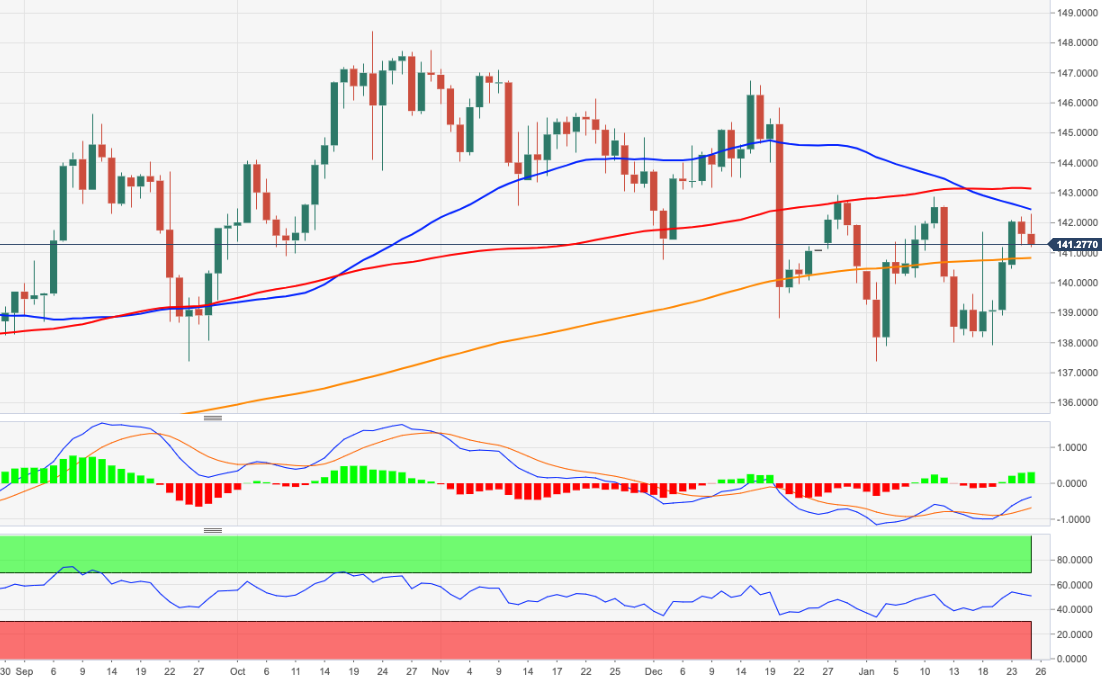
In the annual government economic report published on Wednesday, the German economy minister said that they do not see signs of a market recession as feared by many observers, as reported by Reuters.
The publication revealed that the Gross Domestic Product is forecast to expand by 0.2% in 2023 and inflation is expected to be 6% in 2023, compared to 7% in the autumn forecast.
Market reaction
EUR/USD showed no immediate reaction to these numbers and the pair was last seen trading at 1.0870, where it was down 0.12% on a daily basis.
AUD and NZD have both made strong starts in 2023. Economists at CIBC Capital Markets expect Antipodeans currencies to stabilize before staging another leg higher.
Early year gains face near-term headwinds
“The current outlook is for some consolidation in both AUD and NZD before gains through the remainder of the year. The near-term prompt for that is a retracement and pause being seen in USD/CNH.”
“In the medium-term, the leverage of both the AUD and NZD to a significantly more constructive China outlook than previously anticipated is real, and is more so for AUD.”
“Q1 2023: 0.68 | Q2 2023: 0.69 (AUD/USD)”
“Q1 2023: 0.63 | Q2 2023: 0.63 (NZD/USD)”
- Gold price retreats from a nine-month high as bulls opt to take some profits off the table.
- Bets for smaller rate hikes by Federal Reserve weigh on US Dollar and should limit losses.
- Looming recession risk might further lend some support to the safe-haven precious metal.
Gold price edges lower on Wednesday and moves away from a nine-month high, around the $1,942-$1,943 area touched the previous day. The XAU/USD remains on the defensive through the first half of the European session and is currently placed near the daily low, just below the $1,925 level, down nearly 0.70% for the day.
Bets for smaller rate hikes by Federal Reserve to benefit Gold price
The intraday downtick witnessed around the Gold price lacks any obvious fundamental catalyst and could be attributed to some profit-taking. That said, firming expectations for a less aggressive policy tightening by the Federal Reserve (Fed) could offer some support to the non-yielding yellow metal. In fact, the markets seem convinced that the Fed will soften its hawkish stance amid signs of easing inflationary pressures in the United States (US).
Softer US Dollar might further lend support to Gold price
The CME's FedWatch Tool points to over a 90% probability for a smaller 0.25 bps rate hike at the next Federal Open Market Committee (FOMC) meeting that concludes on February 1. This will mark a further moderation in the pace of the rate-hike cycle, which keeps the US Dollar on the defensive near a nine-month low. A softer greenback might turn out to be another factor that should help limit losses for the US Dollar-denominated Gold price.
Recession fears also favour XAU/USD bulls
Apart from this, the prevalent cautious mood could further act as a tailwind for the safe-haven Gold price. The recent optimism over the easing of strict COVID-19 restrictions in China remains capped amid looming recession risks. According to the latest report by World Bank, the global economy is now in its steepest slowdown following a post-recession recovery since 1970. This, in turn, takes its toll on the risk sentiment.
Focus on key macro data from United States
The aforementioned fundamental backdrop supports prospects for the emergence of some dip-buying around the Gold price. Bulls, however, seem reluctant and prefer to move to the sidelines ahead of this week's important US macro releases, including the Advance Q4 GDP print. This, along with the US Personal Consumption Expenditures (PCE) Price Index, will influence the Fed's interest rate strategy and provide a fresh directional impetus to the XAU/USD.
In the meantime, the USD price dynamics, the US bond yields and the broader risk sentiment will be looked upon for short-term opportunities in the absence of any relevant economic data from the US. Nevertheless, it will still be prudent to wait for strong follow-through selling before confirming that the Gold price has topped out in the near term and positioning for a deeper corrective pullback.
Gold price technical outlook
From a technical perspective, the $1,920 resistance breakpoint is likely to act as immediate support for the Gold price and protect the immediate downside. Any further decline might attract some buyers around the $1,911-$1,910 area, which should help limit losses near the $1,900 round figure. The latter should act as a pivotal point. A convincing break below might shift the near-term bias in favour of bearish traders and pave the way for some meaningful downside.
On the flip side, the $1,942-$1,943 region might continue to act as an immediate barrier for Gold price ahead of the $1,969-$1,970 zone. This is followed by the $1,980 barrier, above which bulls could aim to reclaim the $2,000 psychological mark for the first time since March 2022.
Key levels to watch
Hungarian central bank meeting turned out to be the non-event but managed to trigger a notable HUF rally. Economists at ING expect EUR/HUF to stabilise around 390.
Forint strongest since the middle of last year
“The Hungarian central bank confirmed its commitment to keeping conditions tight for a longer period and that it has taken a patient approach to monetary policy. Overall, it has sent a very clear signal that the hawkish mode will last for an extended period of time and the central bank is not going to allow any hasty moves.”
“The Forint is the strongest since the middle of last year and we believe it could still benefit from yesterday's decision. Added to this is the higher EUR/USD level compared to last week and yesterday's renewed drop in gas prices back below €60/MWh.”
“On the other hand, we may see some profit-taking today after the Forint's multi-day rally and ahead of Friday's risky sovereign rating review from S&P.”
“Overall, we expect the forint to stabilise around 390 EUR/HUF for now.”
Later in the day, the Bank of Canada (BoC) will announce its policy decisions. What is likely to be decisive for the Loonie is how hawkish the market will perceive the BoC to be and above all whether the rate cut expectations for late 2023 will be lowered, according to Elisabeth Andreae, FX Analyst at Commerzbank.
How hawkish will the Bank of Canada seem today?
“CAD is likely to receive short-term support if the BoC surprises with a larger rate step of 50 bps. That is not our main scenario but does not seem impossible in view of the robust economy and the stubbornly high core inflation rate.”
“A 25 bps rate hike, as generally expected, and a hawkish rate outlook are likely to support the Loonie at best.”
“If the BoC were to signal that it will take a break after the latest rate step the market is likely to interpret that as the end of the current rate hike cycle. This is likely to put a brake on rate fantasies and as a result, put pressure on the Loonie.”
See – BoC Preview: Forecasts from eight major banks, edging towards a final rate hike
Citing BoJ Governor Haruhiko Kuroda, a Japanese government official said on Wednesday that the Japanese central bank “will resolutely keep monetary environment easy.”
Kuroda added that “the BoJ aims to regain market functionality by tweaking yield curve control operations while maintaining easy monetary environment, the official noted.
In the last hour, the Japanese government downgraded the overall economic assessment for the first time in 11 months.
Market reaction
USD/JPY is testing daily lows just above 130.00, despite the dovish comments and discouraging economic outlook. The pair is down 0.07% on the day at 130.05, as of writing.
- GBP/AUD prolongs its bearish trend for the fourth straight day and dives to a multi-month low.
- A convincing break below the 200-day SMA and the 1.7500-1.7480 zone favours bearish traders.
- A slightly oversold RSI on hourly charts warrants caution before positioning for further downfall.
The GBP/AUD cross extends its recent sharp downfall from the 1.8000 neighbourhood and remains under heavy selling pressure for the fourth straight day on Wednesday. The downward trajectory drags spot prices to a nearly four-month low during the first half of the European session, though stalls just ahead of the 1.7300 round-figure mark.
The Australian Dollar's relative outperformance against its British counterpart comes amid rising odds for an additional rate hike by the Reserve Bank of Australia (RBA) in February. The bets were lifted by stronger domestic consumer inflation figures released earlier this Wednesday, which showed that the headline CPI accelerated to the highest level since 1990 during the fourth quarter.
That said, a softer tone around the equity markets - amid looming recession risks - might keep a lid on any further gains for the risk-sensitive Aussie. Apart from this, speculations that elevated consumer inflation will maintain pressure on the Bank of England (BoE) to continue raising rates could lend some support to the GBP/AUD cross and help limit further losses, for the time being.
From a technical perspective, the overnight close below the very important 200-day SMA and Wednesday's slump confirm a fresh bearish breakdown below the 1.7500-1.7480 horizontal support. This supports prospects for an extension of the ongoing depreciating move for the GBP/AUD cross. That said, the extremely oversold Relative Strength Index (RSI) on hourly charts warrants some caution.
Hence, it will be prudent to wait for some near-term consolidation or a modest rebound before traders start positioning for the next leg down. In the meantime, any attempted recovery is more likely to confront stiff resistance near the 1.7400 mark. Some follow-through strength, however, might trigger a short-covering rally and lift the GBP/AUD cross to the 1.7500 support breakpoint.
On the flip side, the daily swing low, just ahead of the 1.7300 round figure, now seems to protect the immediate downside. The next relevant support is pegged near the 1.7260-1.7255 zone, below which the GBP/AUD cross could accelerate the fall further towards the 1.7200 mark en route to the 1.7180-1.7175 horizontal support.
GBP/AUD daily chart
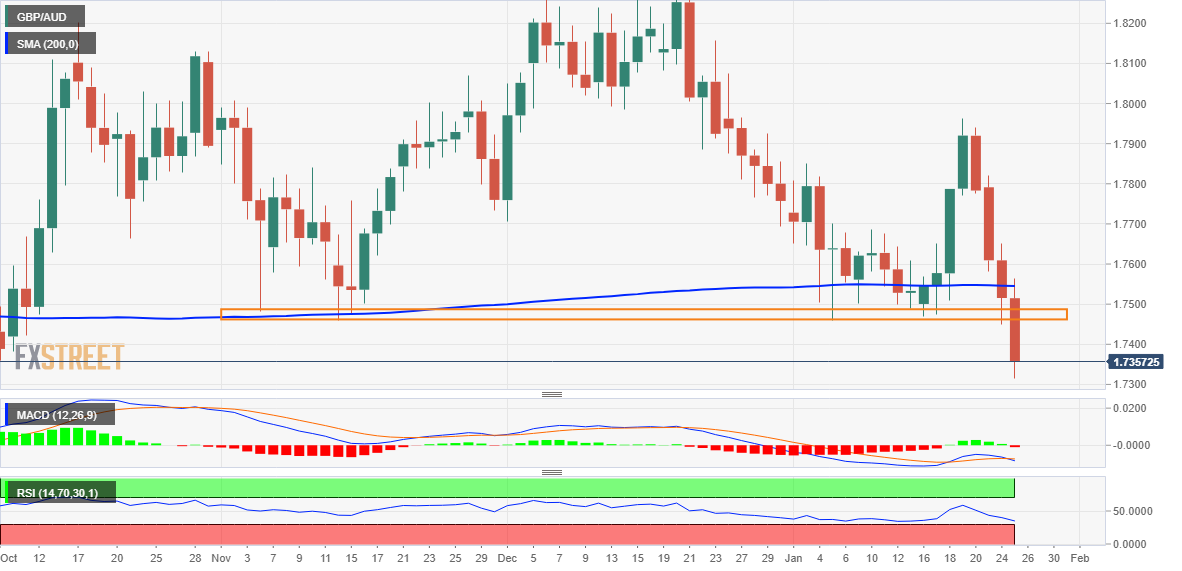
Key levels to watch
Following the release of the German IFO Business Survey, the institute’s Economist Klaus Wohlrabe said that “the German economy is starting the year with cautious optimism.”
Additional quotes
Probably won't be a recession, but GDP will probably shrink slightly in Q1 - mainly due to consumption.
48.4% of companies complained in Jan about supply bottlenecks vs 50.7% in Dec.
Inflationary pressure is easing; balance of companies wanting to raise prices falls to 35.4 points (December 40.1).
Companies' export expectations have brightened somewhat, cautious optimism is spreading.
- EUR/USD: 1.0850 emerging as a short-term floor – ING
As economists at ING note, 1.0850 has emerged as a buy-the-dip area in EUR/USD over the past two sessions.
A test of 1.1000 by the end of the week is looking more likely
“It does appear investors are happily buying the dip in EUR/USD around the 1.0850 handle at the moment, and that could prove to be a short-term floor for the pair.”
“Good data out of the Eurozone is likely keeping most investors on the bullish side of the Euro for now, and downside risks for EUR/USD appear contained.”
“A test of 1.1000 by the end of the week is looking more likely, although a decisive break higher is not our base case before the ECB.”
- German IFO Business Climate Index came in at 90.2 in January.
- IFO Current Economic Assessment for Germany dropped to 94.1 this month.
- January German IFO Expectations Index improved to 86.4.
The headline German IFO Business Climate Index advanced to 90.2 in January versus the previous reading of 88.6 and the forecast of 90.2.
Meanwhile, the Current Economic Assessment dropped to 94.1 points in the reported month as against December's 94.4 and 95.0 expected.
The IFO Expectations Index – indicating firms’ projections for the next six months, rose to 86.4 in January from the previous month’s 83.2 and against the estimates of 85.0.
Market reaction
EUR/USD is unimpressed by the mixed upbeat German IFO survey. At the time of writing, the pair is trading at 1.0875, down 0.06% on the day.
About German IFO
The headline IFO business climate index was rebased and recalibrated in April after the IFO Research Institute changed the series from the base year of 2000 to the base year of 2005 as of May 2011 and then changed the series to include services as of April 2018. The survey now includes 9,000 monthly survey responses from firms in the manufacturing, service sector, trade and construction.
- GBP/USD oscillates in a narrow trading band above the 1.2300 mark on Wednesday.
- Recession fears benefit the safe-haven USD and act as a headwind for the major.
- Expectations that the BoE will continue raising rates lends support and limit losses.
The GBP/USD pair struggles to gain any meaningful traction on Wednesday and oscillates in a narrow band through the early part of the European session. Spot prices hold above the 1.2300 mark, though remain well within the striking distance of a one-week low touched on Tuesday.
A softer risk tone benefits the US Dollar's relative safe-haven status against its British counterpart and turns out to be a key factor acting as a headwind for the GBP/USD pair. The USD bulls, however, seem reluctant amid firming expectations for a less aggressive policy tightening by the Fed. In fact, the markets have been pricing in a greater chance of a smaller 25 bps Fed rate hike in February. This, in turn, should keep a lid on any meaningful upside for the greenback.
Apart from this, speculations that elevated consumer inflation will maintain pressure on the Bank of England (BoE) to continue raising interest rates should limit the downside for the GBP/USD pair. In fact, the UK Office for National Statistics reported last week that the core CPI in the UK stayed at 6.3% in December or more than three times the BoE's 2% target. This, in turn, favours bullish traders and supports prospects for the emergence of some dip-buying around the major.
Nevertheless, the GBP/USD pair, for now, seems to have stalled the recent corrective pullback from the vicinity of mid-1.2400s, or its highest level since June 2022 touched on Monday. There isn't any major market-moving US economic data due on Wednesday. That said, the broader market risk sentiment might drive the USD and provide some impetus to the major. The focus, meanwhile, remains on the Advance US Q4 GDP print and the Core PCE Price Index on Thursday and Friday, respectively, which should influence the Fed's rate-hike path and determine the near-term trajectory for the buck.
Technical levels to watch
Gold trades near $1,930 as the weaker US Dollar continues to lend support. Economists at ANZ Bank expect a downside correction in the near term.
Dollar’s direction could reverse with any hawkish comments from the Fed
“Gold is benefitting from a weakening US Dollar and expectations of the Fed tapering its monetary tightening.”
“Inflation is still well above the Fed’s target range of 2%, and the Dollar’s direction could reverse with any hawkish comments from the central bank.”
“We expect a price correction in the short-term.”
- EUR/USD probes once again the area above 1.0900.
- The dollar kept the erratic performance for yet another session.
- Germany’s Business Climate takes centre stage later in the docket.
The single currency alternates gains with losses vs. the greenback and motivates EUR/USD to keep the trade in the upper end of the recent range near 1.0900 the figure.
EUR/USD now looks at domestic data
EUR/USD keeps the gradual uptrend well in place and manages to revisit the area beyond the 1.0900 barrier on Wednesday, where some decent resistance appears to have emerged so far.
The unabated, albeit slow paced, upside momentum in spot comes on the back of the equally slow downtrend in the greenback, which keeps the price action in the USD Index (DXY) depressed in the 102.00 area.
The ongoing upside in EUR/USD has been propped up by the hawkish rhetoric from ECB’s rate setters, who continue advocate for a 50 bps rate hike at both the February and March gatherings.
In the domestic calendar, all the attention will be on the release of the Business Climate in Germany for the current month measured by the Ifo institute. Across the Atlantic, the sole publication will come from the MBA weekly Mortgage Applications.
What to look for around EUR
EUR/USD flirts once again with the 1.0900 neighbourhood following recent 9-month peaks (January 23).
In the meantime, price action around the European currency should continue to closely follow dollar dynamics, as well as the potential next steps from the ECB and the Federal Reserve.
Back to the euro area, recession concerns now appear to have dwindled, which at the same time remain an important driver sustaining the ongoing recovery in the single currency.
Key events in the euro area this week: Germany Ifo Business Climate (Wednesday) – Italy Business Confidence (Thursday) – France Consumer Confidence, ECB Lagarde (Friday).
Eminent issues on the back boiler: Continuation of the ECB hiking cycle amidst dwindling bets for a recession in the region and still elevated inflation. Impact of the war in Ukraine and the protracted energy crisis on the bloc’s growth prospects and inflation outlook. Risks of inflation becoming entrenched.
EUR/USD levels to watch
So far, the pair is gaining 0.03% at 1.0886 and faces the next up barrier at 1.0926 (2023 high January 23) followed by 1.0936 (weekly high April 21 2022) and finally 1.1000 (round level). On the flip side, the breakdown of 1.0766 (weekly low January 17) would target 1.0576 (55-day SMA) en route to 1.0481 (monthly low January 6).
In the day ahead, the main highlight will be the Bank of Canada’s latest policy decision. Economists at Barclays Research expect the CAD impact to be slightly positive.
CAD remains first and foremost a risk/SPX trade
“We expect some CAD upside from a 25 bps hike by the BoC that is not completely priced in. However, CAD gains from underpriced BoC hikes in the past have been modest and short-lived and sustained gains depend on the risk backdrop.”
“Beyond the tactical considerations around this week’s meeting, CAD remains first and foremost a risk/SPX trade. Accordingly, sustained gains versus the US Dollar in particular likely require S&P 500 index catch-up with equity markets abroad.”
See – BoC Preview: Forecasts from eight major banks, edging towards a final rate hike
- NZD/USD meets with some supply in reaction to unimpressive consumer inflation data.
- The yearly CPI rate falls short of RBNZ’s forecast and weighs on the domestic currency.
- Subdued USD price action lends some support to the pair and helps limit deeper losses.
The NZD/USD pair comes under some selling pressure on Wednesday and snaps a three-day winning streak back closer to its highest level since June 2022 touched last week. The pair remains depressed below the 0.6500 psychological mark through the early European session, though lacks follow-through amid subdued US Dollar price action.
The New Zealand Dollar weakens a bit following the release of domestic consumer inflation data, which showed that the headline CPI decelerated to 1.4% during the fourth quarter from the 2.2% previous. Adding to this, the annual inflation rate came in below the Reserve Bank of New Zealand's (RBNZ) 7.5% forecast and remained stable at 7.2%. The data forces investors to lower the expectations for the cash rate peak in New Zealand to 5%, from 5.5% and prompts some selling around the NZD/USD pair.
Furthermore, worries about a deeper global economic downturn keep a lid on any optimism in the markets and further contributes to driving flows away from the risk-sensitive Kiwi. That said, the underlying bearish sentiment surrounding the greenback helps limit the downside for the NZD/USD pair. In fact, the USD Index, which tracks the greenback's performance against a basket of currencies, remains depressed near a nine-month low amid expectations for a less aggressive tightening by the Fed.
The markets now seem convinced that the US central bank will soften its hawkish stance and have been pricing in a greater chance of a smaller 25 bps rate hike in February. This might continue to weigh on the buck and supports prospects for the emergence of some dip-buying around the NZD/USD pair. Hence, it will be prudent to wait for strong follow-through selling before confirming that the pair has topped out in the near term and positioning for any deeper corrective pullback.
There isn't any major market-moving economic data due for release from the US on Wednesday. That said, the broader risk sentiment might influence the USD price dynamics and provide some impetus to the NZD/USD pair. Traders, however, might prefer to wait on the sidelines ahead of this week's important US macro releases, including the Advance Q4 GDP print and the Core PCE Price Index on Thursday and Friday, respectively.
Technical levels to watch
Sterling got a right old battering yesterday. Economists at Commerzbank expect GBP to continue struggling for the time being.
BoE torn between inflation Scylla and recession Charybdis
“The ONS announced that government deficit in December was higher than had been expected. The budget data rightly constitutes a GBP negative factor. Because against their background, real economic data are under much stronger scrutiny.”
“For none of the economic areas for which our economists produce projections is the outlook as pessimistic as for the UK. Against this background, it seems logical that it is assumed the BoE was facing a particularly difficult choice between the inflation Scylla and the recession Charybdis. It is difficult to imagine that the British central bankers will master these wanderings without damaging GBP.”
The Bank of Canada (BoC) is set to announce its interest rate decision on Wednesday, January 25 at 15:00 GMT and as we get closer to the release time, here are the expectations as forecast by the economists and researchers of eight major banks, regarding the upcoming announcement.
The BoC is set to deliver a 25 basis points (bps) hike, lifting the policy rate from 4.25% to 4.25% in what could be its final round of tightening.
Standard Chartered
“We now expect the BoC to raise the policy rate by 25 bps to 4.5%. We expect the BoC to be careful about signalling future hikes while not precluding them. This is largely in line with market expectations, so we do not expect a big CAD reaction. The CAD could fall if BoC Governor Macklem signals that the BoC hiking cycle is over, but we think he will most likely indicate that the hiking cycle is close to a peak, and not rule out future hikes in case they are needed.”
NBF
“The billion-dollar question is: Is inflation normalizing quickly enough? We think it is and we are very cautiously optimistic they’ll agree. As such, we are officially forecasting a ‘no change’ decision but we are not dismissing that there are valid reasons to expect the BoC to pull the trigger.”
ING
“The BoC is getting close to the end point of its interest rate hiking phase. Inflation is showing signs of coming off, but the jobs market remains hot and as such we expect a final 25 bps interest rate hike. The BoC will likely characterise this as a pause, but we expect it to mark the peak as global recessionary forces are increasingly felt within Canada and inflation numbers continue to subside.”
TDS
“We look for the BoC to hike by 25 bps and we expect this will be the last hike this cycle (though the forward-looking component will not preclude future hikes). While this is expected to be the last hike, the CAD may not receive much directional bias from this meeting as the curve may continue to be biased about looking at the other side of this interest rate cycle. That said, the CAD may be more sensitive to any dovish elements should the BOC emphasize elements from the BOS. We see a differentiated dynamic playing out on the crosses given risk correlations.”
RBC Economics
“Canada’s central bank is expected to slow the pace of interest rate hikes. And odds are that the 25 bps increase we anticipate (down from the 50 bps increase in December) could be the last of this hiking cycle. An unexpected surge in employment in December and a decline in the unemployment rate to a near record low of 5% is the main reason we expect the BoC to follow through with one final rate hike. Still, interest rates are likely high enough now that labour markets will soften in 2023.”
Citibank
“We expect another 25 bps hike to 4.50% with the updated policy statement likely to describe both growth and the labor market as having evolved somewhat stronger than expected, although with increasing concerns over softer activity as shown in the Q4 Business Outlook Survey. While there is a possibility that the BoC could show some preference for pausing rates and assessing how economic conditions evolve, we expect only very minor changes to guidance and their base case remains for another 25 bps hike in March, although highly data-dependent.”
CIBC
“The BoC is expected to deliver a further rate increase, albeit of a more modest 25 bps sizing. The statement will have to sound hawkish enough to justify the move, but look for indications from the following press conference that a pause will be seen from here and the conditions that the Bank eventually needs to see to start cutting interest rates again.”
Wells Fargo
“Recent activity data have been mixed, suggesting an end to the central bank's tightening cycle may not be that far away. With core inflation yet to show a more meaningful deceleration, we believe that could be enough for the BoC to deliver one final 25 bps policy rate increase to 4.50%. We expect the policy interest rate to remain at that level through most of this year before the BoC begins cutting interest rates in the final quarter of 2023.”
Here is what you need to know on Wednesday, January 25:
Markets remain indecisive mid-week as investors look for the next significant catalyst. The US Dollar Index stays near 102.00 following Tuesday's failed recovery attempt and the 10-year US Treasury bond yield stays slightly below 3.5%. Meanwhile, US stock index futures trade in negative territory, pointing to a cautious market mood in the European morning. IFO sentiment surveys from Germany will be featured in the European economic docket. Later in the day, the Bank of Canada (BoC) will announce its policy decisions.
On Tuesday, S&P Global PMI surveys from the US showed that the economic activity in the private sector continued to contract in early January with the Composite PMI arriving at 46.6. In the press release, "the rate of input cost inflation has accelerated into the new year, linked in part to upward wage pressures, which could encourage a further aggressive tightening of Fed policy despite rising recession risks," noted Chris Williamson, Chief Business Economist at S&P Global Market Intelligence. This comment helped the US Dollar outperform its rivals but the late rebound witnessed in Wall Street's main indexes made it difficult for the currency to preserve its strength.
During the Asian trading hours on Wednesday, the data from Australia showed that the Consumer Price Index (CPI) climbed to 7.8% on a yearly basis in the fourth quarter from 7.3%. With this reading surpassing the market expectation of 7.5%, market participants reconsidered the odds of the Reserve Bank of Australia (RBA). In turn, AUD/USD gained traction and was last seen trading at its highest level since mid-August at 0.7110, rising nearly 1% on a daily basis.
Statistics New Zealand reported on Wednesday that the annual CPI in the fourth quarter remained steady at 7.2%. New Zealand’s new Prime Minister (PM) Chris Hipkins said inflation was putting a strain on household budgets and added that more must be done to combat high inflation. Unlike AUD/USD, NZD/USD failed to gather bullish momentum after inflation data and was last seen posting small daily losses slightly below 0.6500.
USD/CAD closed the fourth straight trading day in negative territory on Tuesday and continued to push lower toward 1.3350 early Wednesday. The BoC is forecast to raise its policy rate by 25 basis points to 4.5%.
Bank of Canada Preview: The final one, with a pause ahead?
USD/JPY continues to trade in a relatively tight range above 130.00 as market participants try to figure out how the Bank of Japan's (BoJ) monetary policy will be shaped when the new governor takes over. Eiji Maeda, a former BoJ Executive Director in charge of monetary policy during the pandemic, told Bloomberg that it was more likely than not that the BoJ will take steps within the first six months of a new governorship.
EUR/USD managed to regain its traction after dropping toward 1.0830 with the initial reaction to US PMI data on Tuesday. The pair was last seen trading in positive territory a few pips above 1.0900.
GBP/USD closed the second straight day in negative territory on Tuesday but didn't have a difficult time holding above 1.2300. Nevertheless, the pair is having a hard time erasing its losses early Wednesday as markets keep a close eye on political developments in the UK.
After having spent the first half of the day fluctuating in a narrow channel, Gold price fell sharply in the early American session before reversing its direction. With the 10-year US Treasury bond yield dropping below 3.5% late Tuesday, XAU/USD registered its highest daily close since April. Early Wednesday, the pair stays in a consolidation phase slightly above $1,930.
Bitcoin lost more than 1% on Tuesday but didn't have a hard time finding support. At the time of press, BTC/USD was posting small daily gains at around $22,700. Ethereum extended its downward correction and erased more than 4% on Tuesday before stabilizing slightly above $1,500 early Wednesday.
- USD/JPY edges higher on Wednesday, though the modest intraday uptick lacks bullish conviction.
- Bets for smaller Fed rate hikes continue to weigh on the USD and act as a headwind for the pair.
- Hawkish BoJ expectations, recession fears benefit the safe-haven JPY and contribute to capping gains.
The USD/JPY pair attracts some buyers near the 130.00 psychological mark on Wednesday and reverses a part of the previous day's modest losses. Spot prices, however, seem to struggle to capitalize on the move and held steady around the mid-130.00s through the early European session.
The US Dollar remains on the defensive near a nine-month low, which, in turn, is seen as a key factor acting as a headwind for the USD/JPY pair. The markets now seem convinced that the Fed will soften its hawkish stance amid signs of easing inflationary pressures and have been pricing in a smaller 25 bps rate hike in February. This keeps a lid on the recent recovery in the US Treasury bond yields and continues to weigh on the greenback.
The Japanese Yen (JPY), on the other hand, draws support from fresh speculation that high inflation may invite a more hawkish stance from the Bank of Japan (BoJ) later this year. The bets were lifted after the latest CPI report from Japan showed that consumer inflation rose to a 41-year high level of 4% in December. Apart from this, worries about a deeper global economic downturn benefit the safe-haven JPY and contribute to capping the USD/JPY pair.
The aforementioned fundamental backdrop favours bearish traders and suggests that the path of least resistance for the USD/JPY pair is to the downside. The downside, however, seems cushioned as traders might prefer to move to the sidelines ahead of this week's important US macro releases, including the Advance Q4 GDP print and the Core PCE Price Index. The focus will then shift to the highly-anticipated FOMC monetary policy meeting, scheduled next week.
In the meantime, the US bond yields will play a key role in influencing the USD price dynamics in the absence of any relevant market-moving economic data from the US. Apart from this, traders will take cues from the broader risk sentiment to grab short-term opportunities around the USD/JPY pair.
Technical levels to watch
CME Group’s flash data for natural gas futures markets noted open interest reversed the previous daily drop and went up by around 4.3K contracts on Tuesday. On the opposite side, volume partially faded the previous daily build and shrank by around 91.6K contracts.
Natural Gas: The $3.00 mark is just around the corner
Natural Gas remains well under pressure. Tuesday’s decline was on the back of rising open interest and kept favouring the continuation of the downtrend in the very near term and with immediate support at the key $3.00 mark per MMBtu.
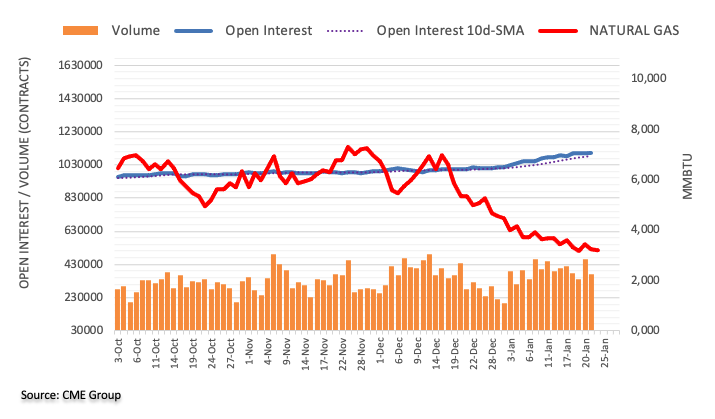
Considering advanced figures from CME Group for crude oil futures markets, traders added around 16.4K contracts to their open interest positions on Tuesday, clinching the third consecutive daily advance. On the other hand, volume resumed the downtrend and dropped by around 133.6K contracts.
WTI faces a minor support near $78.00
Prices of the WTI started the week on the back foot. Indeed, Tuesday’s moderate pullback was amidst increasing open interest, which is supportive of a deeper retracement in the very near term. That said, the weekly low near the $78.00 mark per barrel (January 19) now emerges as a potential next target fore the commodity.

Gold price returns to the red. As FXStreet’s Dhwani Mehta notes, $1,940 is a tough nut to crack for XAU/USD bulls.
Gold price could be briefly punished
“Gold sellers need a daily closing below the lower boundary of the rising wedge formation, now at $1,933, to confirm a downside break. On a rising wedge breakdown, Gold could extend the correction toward Monday’s high of $1,911, below which the $1,900 round figure could be tested.”
“Acceptance above the $1,940 hurdle is critical to renewing the upside. Further, a daily closing above the rising wedge resistance at $1,944 is needed to could negate the bearish bias in the near term.”
- AUD/USD takes the bids to rise to a fresh high since August 2022.
- A clear upside break of previous resistance from November, bullish MACD signals favor buyers.
- Nearly overbought RSI (14), multiple hurdle since June 2022 challenge immediate upside.
AUD/USD bulls cheer the strong Aussie inflation data as the quote renews the five-month peak near 0.7115 during early Wednesday.
In addition to the upbeat prints of the quarterly Australia Consumer Price Index (CPI) and Reserve Bank of Australia Trimmed Mean CPI, the Aussie pair’s ability to successfully cross an ascending trend line from November 15, around 0.7095 at the latest, also favor the bulls. It’s worth noting that the bullish MACD signals add strength to the upside move.
However, a horizontal area comprising multiple levels marked since June 2022, around 0.7130-40 restricts appears a strong resistance for the AUD/USD pair traders. Adding strength to the stated hurdle is the overbought condition of the RSI (14).
Should the Aussie pair stays comfortably beyond 0.7140, the odds of witnessing the pair’s run-up toward the mid-2022 peak surrounding 0.7285 can’t be ruled out.
Alternatively, intraday sellers could take entries in case the AUD/USD price drops below the resistance-turned-support line near 0.7095.
Even so, the previous weekly high near 0.7065 and the last Thursday’s low near 0.6870 may test the AUD/USD bears.
It should be noted that the 61.8% Fibonacci retracement level of the pair’s June-October 2022 downside and the 200-DMA, respectively near 0.6855 and 0.6815, appear the last defense of the pair buyers as a clear of the same might confirm the bearish trend.
AUD/USD: Daily chart
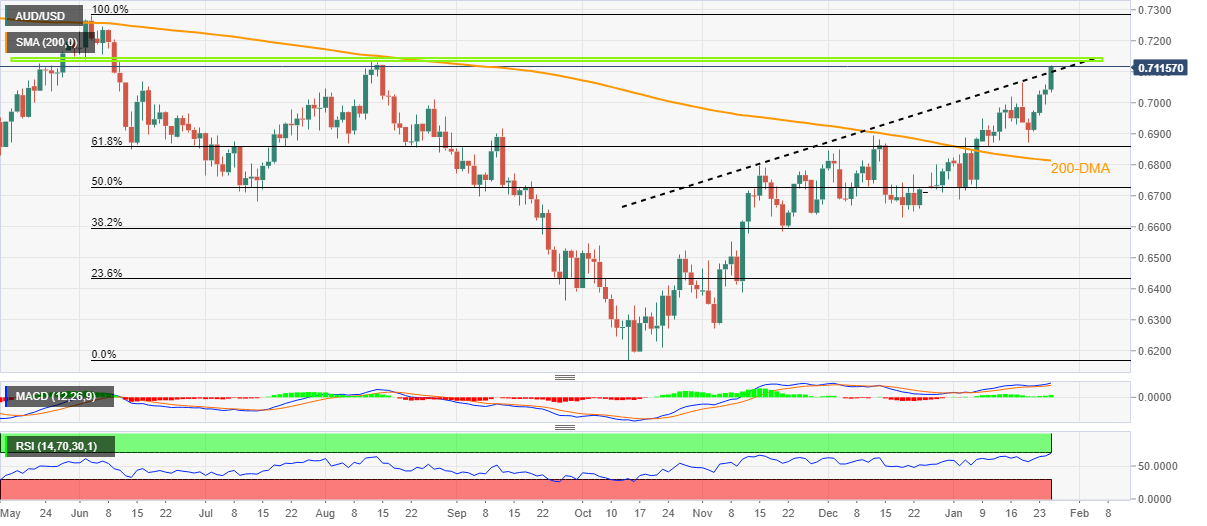
Trend: Limited upside expected
Open interest in gold futures markets shrank by nearly 2K contracts after three consecutive daily builds on Tuesday, according to preliminary prints from CME Group. Volume, instead, went up by the second straight session, now by around 42.8K contracts.
Gold: Rally has further legs to go
Gold prices charted a new YTD high past the $1940 mark per ounce troy on Tuesday. The daily gains, however, were on the back of diminishing open interest, hinting at the likelihood of a corrective decline in the very near term. In the longer run, the precious metal continues to target the key $2000 yardstick.
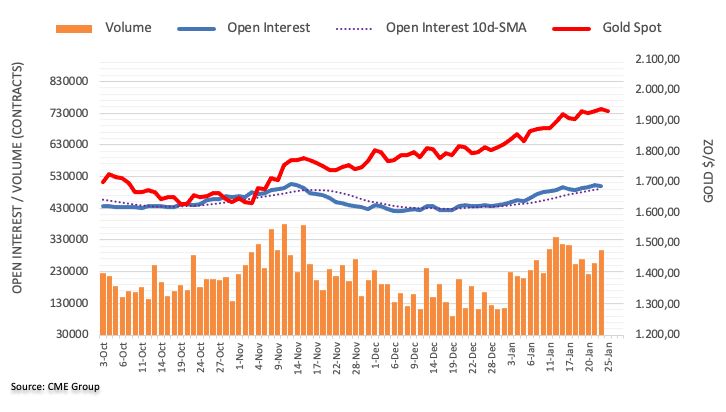
- The index keeps treading water around the 102.00 region.
- Markets remain largely side-lined ahead of key events next week.
- Weekly Mortgage Applications, EIA report only due later in the day.
The greenback, in terms of the USD Index (DXY), extends the multi-session consolidative mood around the 102.00 zone on Wednesday.
USD Index looks cautious ahead of FOMC
The index trades slightly on the defensive in the sub-102.00 zone against the backdrop of the generalized range bound theme in the global markets, all in light of the FOMC gathering due on February 1.
On the latter, and while a 25 bps interest rate raise is almost fully priced in, market participants are expected to closely follow the subsequent press conference by Chief Powell in search for any hint of the future moves by the central bank, particularly following the current opposite views from investors – who keep favouring a pivot in the Fed’s policy – and the persistent hawkish stance from policy makers.
Nothing to write home about in the US data space, as only the weekly Mortgage Applications tracked by MBA are only due seconded by the EIA’s report on US crude oil stockpiles.
What to look for around USD
The dollar’s price action remains depressed in the lower end of the recent range in the sub-102.00 region so far this week.
The idea of a probable pivot in the Fed’s policy continues to weigh on the greenback and keeps the price action around the DXY depressed. This view, however, also comes in contrast to the hawkish message from the latest FOMC Minutes and recent comments from rate setters, all pointing to the need to advance to a more restrictive stance and stay there for longer, at the time when rates are seen climbing above the 5.0% mark.
On the latter, the tight labour market and the resilience of the economy are also seen supportive of the firm message from the Federal Reserve and the continuation of its hiking cycle.
Key events in the US this week: MBA Mortgage Applications (Wednesday) – Durable Goods Orders, Advanced Q4 GDP Growth Rate, Chicago Fed National Activity Index, Initial Jobless Claims, New Home Sales (Thursday) – PCE, Core PCE, Personal Income, Personal Spending, Pending Home Sales, Final Michigan Consumer Sentiment (Friday).
Eminent issues on the back boiler: Rising conviction of a soft landing of the US economy. Prospects for extra rate hikes by the Federal Reserve vs. speculation of a recession in the next months. Fed’s pivot. Geopolitical effervescence vs. Russia and China. US-China trade conflict.
USD Index relevant levels
Now, the index retreats 0.11% at 101.81 and faces the next support at 101.52 (2023 low January 18) seconded by 101.29 (monthly low May 30 2022) and finally 100.00 (psychological level). On the upside, a breakout of the weekly high at 102.89 (January 18) would pave the way for a test of 105.63 (monthly high January 6) and then 106.46 (200-day SMA).
- EUR/USD renews intrday high but the bulls struggle to keep the reins during five-day uptrend.
- Successful trading above 200-HMA, immediate resistance break favor buyers.
- RSI (14) fails to accompany higher lows on prices, suggesting the lack of strength in upside momentum.
EUR/USD picks up bids to refresh intraday top near 1.0910 during early Wednesday, staying firmer for the fifth consecutive day. Even so, the buyers struggle to keep the driver’s seat as of late. In doing so, the Euro fades the bounce off the 200-Hour Moving Average (HMA), as well as struggling to rise despite breaking a downward-sloping trend line from Monday.
It’s worth noting that the sluggish MACD signals join the RSI's (14) inability to back the EUR/USD run-up, marked by higher lows on prices and lower lows on the RSI, to lure the pair sellers.
However, a clear downside break of the previous resistance line, around 1.0870 by the press time, appears necessary for the pair sellers to take entries.
Even so, the 200-HMA level surrounding 1.0840 could act as the last defense of the EUR/USD bulls, a break of which should open the door for the pair’s slump towards the early month peak surrounding 1.0760.
On the contrary, the monthly high near 1.0930 will precede a late April 2022 peak of 1.0935 to attract EUR/USD buyers.
Following that, the run-up will find a hard time as the 1.1000 round figure and March 2022 top close to 1.1185 could challenge the north run.
EUR/USD: Hourly chart

Trend: Pullback expected
FX option expiries for Jan 25 NY cut at 10:00 Eastern Time, via DTCC, can be found below.
- EUR/GBP: EUR amounts
- 0.8505 480m
- 0.9065 489m
- USD/CAD is set to extend the downside to near the weekly low around 1.3320.
- Bank of Canada is expected to hike the interest rate further by 25 bps to 4.5%.
- The expectation of a smaller interest rate hike by the Federal Reserve is backed by escalating recession fears.
- USD/CAD is expected to deliver a breakdown of the Inverted Flag chart pattern that might expand volatility ahead.
USD/CAD is hovering near the critical support above 1.3340 in the early European session. The Loonie asset has dropped after failing to sustain above 1.3400 and is expected to decline further to near the weekly lows around 1.3320. The major is following the footprints of the US Dollar Index (DXY), which is displaying a subdued performance.
Weakness in the S&P500 futures led by a dip in Microsoft earnings due to missed estimates in the cloud business and technical glitches in the NYSE has turned investors’ risk-averse. Also, investors are restricting themselves from building full-capacity positions ahead of the United States Gross Domestic Product (GDP) data. The US Dollar Index (DXY) is struggling to sustain above the 101.50 resistance. The alpha created by the US government bonds has rebounded firmly. The 10-year US Treasury yields have scaled to near 3.47%.
Bank of Canada to tighten policy further
To tame stubborn inflation, the Bank of Canada (BoC) might continue to tighten its monetary policy further. Canada’s inflation has been recorded at 6.3% from its December Consumer Price Index (CPI) report, which is three times more than the 2% inflation target.
According to a poll from Reuters, Bank of Canada Governor Tiff Macklem’s aggressive policy tightening campaign is expected to calm down as the street sees a further interest rate hike by 25 basis points (bps) to 4.50%. Also, it conveys that the Bank of Canada will keep interest rates at 4.5% for the rest of the year, which indicates that this might be the end of further policy tightening. Canada’s headline inflation stood at 6.3% for December and is expected to remain above 2% inflation target till Q3CY2024.
Factors that have kept Canada’s inflation at the rooftop are the tight labor market and supply chain bottlenecks. Upbeat employment opportunities have not provided a significant reason to producers to trim the prices of goods and services at factory gates. A higher-than-projected hawkish interest rate decision by the Bank of Canada might strengthen the Canadian Dollar.
Oil price attempts a recovery from $80.00
Sheer weakness in the oil prices witnessed on Tuesday has met with demand in Wednesday morning around the critical support of $80.00. The black gold witnessed immense pressure as oil demand is expected to witness short-term pain due to extended holidays in Chinese markets for Lunar New Year celebrations. Also, the absence of chatters about supply cuts in the report from OPEC impacted the oil price.
Meanwhile, the oil price has attempted a recovery amid headlines that the United States is considering refilling the Strategic Petroleum Reserve (SPR). US President Joe Biden exploited the oil reserves to fight rising oil prices in CY2022. It is worth noting that Canada is a leading exporter of oil to the United States and a recovery in the oil price might support the Canadian Dollar.
Contraction in US GDP might accelerate recession fears
After a better-than-projected preliminary United States S&P PMI data, investors are shifting their focus toward the release of Thursday’s Gross Domestic Product (GDP). The street is expecting the fourth quarter GDP at 2.8% vs. the prior release of 3.2%. Investors should be aware of the fact that the US Bureau of Economic Analysis reported negative growth in the first two quarters of CY2022. And further contraction in the fourth quarter might accelerate recession fears. The rationale behind softening of economic activities is the higher interest rates by the Federal Reserve (Fed), which has trimmed the leakage of borrowings due to higher interest obligations.
Apart from that, chatters about interest rate policy by the Federal Reserve are impacting the US Dollar. The street is expecting a further deceleration in the pace of policy tightening by the Federal Reserve as inflation has been softened significantly.
USD/CAD technical outlook
-638102233901273112.png)
USD/CAD is forming an Inverted Flag chart pattern on an hourly scale that indicates a sheer consolidation, which is followed by a breakdown in the same. Usually, the consolidation phase of the chart pattern serves as an inventory adjustment in which those participants initiate shorts, which prefer to enter an auction after the establishment of a bearish bias.
Downward-sloping 20-and 50-period Exponential Moving Average (EMA) at 1.3365 and 1.3375 respectively are acting as a major barricade for the US Dollar.
Meanwhile, the Relative Strength Index (RSI) (14) is oscillating in a 40.00-60.00 range, which indicates volatility contraction.
- Silver traders take offers to refresh intraday low while paring previous daily losses.
- DXY steadies during three-week downtrend as traders brace for US Q4 GDP.
- Inactive yields, light calendar adds to the market’s indecision ahead of key catalysts.
Silver price (XAG/USD) remains depressed around intraday low of $23.50 as traders seek fresh clues to extend the fortnight-long downtrend during early Wednesday in Europe. In doing so, the bright metal takes clues from a pause in the US Dollar’s downtrend while reversing the previous day’s gains.
That said, the US Dollar Index (DXY) steadies around 102.00 as bears await the US Gross Domestic Product (GDP) for the fourth quarter (Q4) and the next week’s Federal Open Market Committee (FOMC) meeting.
It’s worth noting that the downbeat US activity data join the dovish concerns surrounding the Federal Reserve’s (Fed) next moves to keep XAG/USD buyers hopeful. However, an absence of Chinese traders and the pre-Fed blackout period joins the consolidation in the commodity markets, due to China’s Lunar New Year holidays, which seem to weigh on the Silver price of late.
Additionally, the market’s dicey moves and a lack of major data/events also probe the commodity traders. While portraying the mood, US Treasury bond yields remain inactive after Tuesday’s pullback while the S&P 500 Futures print mild losses but the stocks in the Asia-Pacific region trade mixed and support the currencies of the zone.
Moving on, Silver traders will pay close attention to the risk catalyst ahead of the US Q4 GDP as recession woes challenge the partially industrial commodity. However, major attention will be given to the next week’s Federal Open Market Committee (FOMC) meeting for clear directions.
To sum up, the Silver price remains on the bear’s radar for the day but the bulls are lurking ahead of the key data/events.
Silver price technical analysis
A sustained downside break of the seven-week-old ascending trend line, now immediate resistance near $23.70, keeps Silver bears hopeful of retesting the monthly low near $22.75.
Economists at Goldman Sachs believe that it’s the final rate hike for the Bank of Canada (BoC) this Wednesday, as the central bank is likely to pause tightening going forward.
Key quotes
"Our economists expect the BoC to slow the pace of hikes to 25bps at this week's meeting and to pause thereafter, assuming inflation is in line with our forecasts.
“We will be most focused on any potential changes in forward guidance or comments from Governor Macklem on the strength of the labor market.”
"Overall, risks lean toward a pause next week rather than a larger-than-expected hike in our view, meaning USD/CAD faces upside risk on the meeting. Until then, if the broad Dollar continues breaking lower, which seems to have few obstacles in the near term, CAD is likely to see additional weakness on crosses.”
Related reads
- Bank of Canada Preview: The final one, with a pause ahead?
- BoC Preview: With modest conviction we expect a 25bps hike – Scotiabank
- EUR/GBP grinds near weekly high, up for the fourth consecutive day.
- Clear rebound from 50% Fibonacci retracement, upside break of 100-SMA favor bulls.
- One-week-old resistance line restricts immediate upside ahead of monthly top.
EUR/GBP picks up bids to 0.8845 as bulls poke intraday high, as well as the weekly top, heading into Wednesday’s European session. In doing so, the cross-currency pair rises for the fourth consecutive day after reversing from the 50% Fibonacci retracement of its run-up from early December to January 13.
In addition to a successful rebound from the key Fibonacci retracement level of 0.8722, the EUR/GBP pair’s ability to cross the 100-SMA hurdle, as well as the bullish MACD signals, favor the bulls.
It should be noted, however, that a downward-sloping resistance line from January 13, close to 0.8860 at the latest, guards the quote’s immediate upside.
That said, the quote’s run-up beyond 0.8860 could enable the EUR/GBP bulls to refresh the monthly high, currently around 0.8900. In that case, the 61.8% Fibonacci Expansion (FE) of its moves between December 01, 2022, and January 13, 2023, close to 0.8955, will gain the market’s attention.
Alternatively, pullback moves may initially aim for the 100-SMA level surrounding 0.8815 ahead of targeting the 0.8800 round figure.
Following that, the 50% Fibonacci retracement level of 0.8722 should lure the EUR/GBP bears.
In a case where the quote remains bearish past 0.8722, the 61.8% Fibonacci retracement level near 0.8680, also known as the “golden ratio”, will be crucial to watch.
EUR/GBP: Four-hour chart
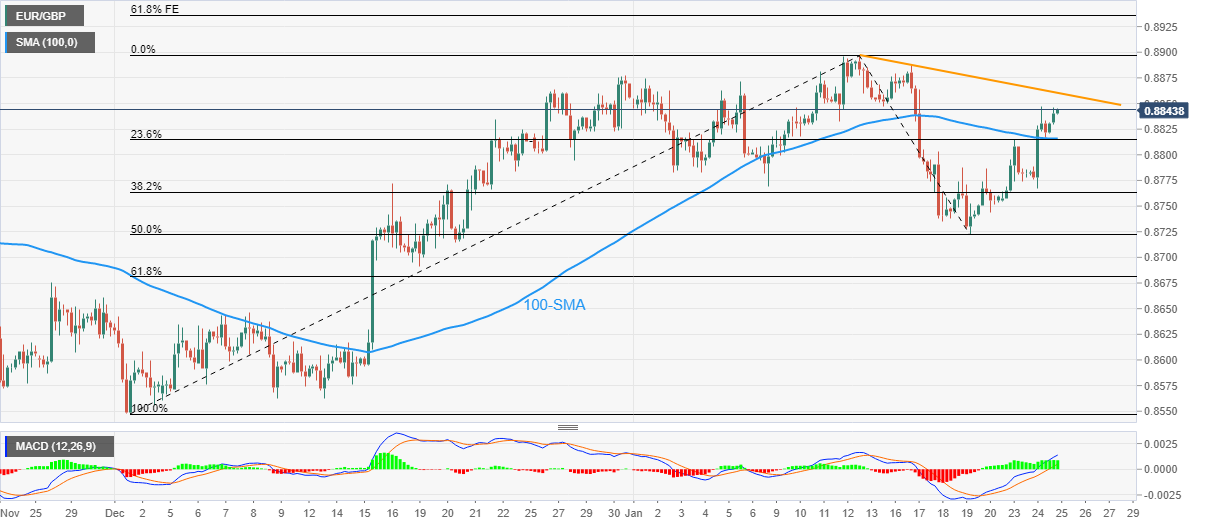
Trend: Further upside expected
Eiji Maeda, a former Bank of Japan (BoJ) Executive Director in charge of monetary policy during the pandemic, said in a Bloomberg interview on Tuesday, “it’s more likely than not that the BOJ will take steps within the first six months of a new governorship.”
Additional quotes
“Still, even if YCC and the negative interest rate come to an end, the bank will probably continue with monetary easing” to keep rates low.
“Mild inflation is starting to take root.”
“An economic cycle where inflation pushes up wages may be starting to emerge.”
Market reaction
USD/JPY was last seen trading at 130.52, adding 0.29% on the day.
- GBP/USD struggles for clear directions after two-day downtrend.
- UK’s record deficit, fresh Brexit woes and fears of strong recession due to workers’ strikes favor bears.
- Receding hawkish concerns surrounding Fed, downbeat US data put a floor under the Cable price.
- Second-tier UK data may entertain traders ahead of US Q4 GDP.
GBP/USD holds lower ground near 1.2320 as bears seek more clues to rule further heading into Wednesday’s London open. In doing so, the Cable pair remains sidelined after a two-day downtrend while copying the broad market inaction.
In addition to a lack of liquidity in the markets, receding hawkish hopes from both the Bank of England (BoE) and the Federal Reserve (Fed) also seems to limit the quote’s latest moves.
As per the latest Reuters Poll, the BoE has a gap for only two rate hikes worth 0.25% before hitting the pivot level. On the other hand, “Fed fund futures see only two more quarter-point rate hikes by the Fed to a peak of around 5% by June, before it starts cutting rates later in the year. The Federal Reserve itself has insisted it still has 75 bps of increases in the pipeline,” said Reuters.
Additionally, downbeat prints of both the UK and the US activity data for January failed to provide any clear directions for the Cable pair traders.
It’s worth noting, however, that the various stimulus and energy payments have led to the UK’s record deficit but couldn’t solve the workers’ problem in Britain, both of which signal more negatives for the GBP/USD pair. Additionally, the talks of the sustained disagreement between the UK and Europe over Brexit also lure the pair sellers.
On the other hand, US recession woes are on the table and hence the US Dollar trades dicey ahead of the US Gross Domestic Product (GDP) for the fourth quarter (Q4) and the next week’s Federal Open Market Committee (FOMC) meeting.
Amid these plays, US Treasury bond yields remain inactive after Tuesday’s pullback while the S&P 500 Futures print mild losses but the stocks in the Asia-Pacific region trade mixed and support the currencies of the zone.
Looking forward, the UK Producer Price Index (PPI) details for January may entertain GBP/USD traders ahead of Thursday’s key US Q4 GDP and the next week’s Fed meeting.
Technical analysis
A daily closing below the 13-day-old support line, now resistance around 1.2350, keeps GBP/USD bears hopeful.
“Specific monetary policy tools are up to Bank of Japan (BoJ) to decide, including yield curve control, negative interest rate, ETF buying,” said Japan Prime Minister Fumio Kishida early Wednesday per Reuters.
More comments
Government and BoJ have agreed to closely cooperate to conduct nimble policies, aiming for economic growth in tandem with wage hikes and sustainable, stable achievement of inflation target.
Premature to mention chance of revising government-BoJ joint statement at this stage since next boj governor has not been decided.
Will make appropriate decision on the next BoJ governor while watching future economic trends.
Will appoint the next BoJ governor based on the candidate's aptitudes at the end of incumbent Kuroda’s term-end on April 8.
USD/JPY renews intraday high
Following the news, USD/JPY refreshed intraday high near 130.60, up 0.24% on the day at the latest.
Also read: USD/JPY traces sluggish yields above 130.00 as Yen traders await BoJ Summary, US GDP and Fed
- A power-pack action is absent as major markets are closed on account of the Lunar New Year holidays.
- The US Dollar Index is struggling to find foot after surrendering the critical support of 101.50.
- Oil price has attempted a recovery after dropping to near 101.50 amid escalating supply worries.
Markets in the Asian domain are mostly closed to celebrate Lunar New Year. Japanese stocks have extended their rally despite weakness in the S&P500 futures. Equities in the United States are facing pressure as Microsoft missed the estimates and a technical glitch in NYSE on Tuesday has triggered volatility in the S&P500 futures.
At the press time, Japan’s Nikkei225 gained 0.43%, KOSPI surged 1.30%, and Nifty50 drops 0.67% while Chinese and Hong Kong markets are closed on account of the Lunar New Year.
The US Dollar Index (DXY) has sensed rejection from the 101.50 resistance and is expected to resume its downside journey. However, investors should brace for topsy-turvy moves by the USD index ahead of the release of the Gross Domestic Product (GDP) data. On Tuesday, the USD Index displayed sheer volatility after the release of the better-than-projected preliminary US S&P PMI data.
Manufacturing PMI landed at 46.8, higher than the expectations of 46.1 and the former release of 46.2. Also, the Services PMI remained upbeat and scaled higher to 46.6 against the consensus of 44.5 and the prior release of 44.7. The release of the better-than-anticipated US PMI has trimmed recession fears for a while.
Japanese stocks are clearly in an upside trend as Japan’s officials are constantly putting efforts to ramp up growth and wages in the economy. Investors are getting ‘gung ho’ over equities as officials are continuously pumping money to spurt the growth rate. On wage growth, A former Bank of Japan (BoJ) Chief Economist, Kazuo Momma, said in an MNI interview on Wednesday, the BoJ will have to wait until August to gain good insight into whether wage increases are gaining traction.
On the oil front, closed production activities in China due to Lunar New Year celebrations resulted in a sell-off on Tuesday. However, the oil price is showing signs of recovery after dropping to near $80.00 amid growing supply worries. US President Joe Biden is considering refilling the Strategic Petroleum Reserve (SPR) after exploiting it significantly to combat rising oil prices in CY2022.
- Gold Price pares weekly gains with mild losses as it snaps two-day uptrend.
- Global markets remain sidelined amid pre-GDP anxiety, mixed concerns surrounding Fed.
- Light calendar, off in China add to the market’s inaction and probe XAU/USD traders.
Gold price (XAU/USD) prints mild losses around $1,930 as it consolidates the gains marked during the last six consecutive weeks. That said, sluggish markets on early Wednesday join the cautious mood ahead of the key US data/events, as well as technical formation, to tease the XAU/USD sellers after rising in the last two days in a row.
US Treasury bond yields portray the market’s inaction as Tuesday’s US activity numbers showed improvement for January but marked the seventh consecutive contraction in PMIs and kept the recession fears on the table.
Elsewhere, hawkish comments from the European Central Bank (ECB) officials ahead of the next week’s monetary policy contrasts with the market’s receding bets on the aggressive Fed rate hikes to confuse traders. “Fed fund futures see only two more quarter-point rate hikes by the Fed to a peak of around 5% by June, before it starts cutting rates later in the year. The Federal Reserve itself has insisted it still has 75 bps of increases in the pipeline,” said Reuters.
It’s worth observing that the strong inflation data in Australia and New Zealand earlier in the day also weighed on the Gold price amid fears of aggressive rate hikes from the Reserve Bank of Australia (RBA) and the Reserve Bank of New Zealand (RBNZ).
Against this backdrop, the S&P 500 Futures print mild losses but the stocks in the Asia-Pacific region trade mixed and support the currencies of the zone.
Moving on, Gold traders may witness sluggish moves and can pare recent gains ahead of Thursday’s US data dump comprising the monthly Durable Goods Orders, weekly Jobless Claims and the preliminary readings of the Q4 GDP. Above all, the next week’s Federal Open Market Committee (FOMC) meeting is the most important event for the XAU/USD traders to watch for clear directions.
Gold price: Technical analysis
Gold price takes a U-turn from the one-week-old ascending resistance line, around $1,942 by the press time, which in turn takes clues from the overbought RSI and looming bears on the MACD to keep sellers hopeful.
However, the 10-DMA support level surrounding $1,920 restricts the immediate downside of the Gold price.
Should the bright metal remains weak past $1,920, the previous weekly bottom near $1,896 could act as the last defense of the Gold buyers.
On the flip side, Gold’s successful trading above the adjacent resistance line, close to $1,942 at the latest, could propel the quote toward an ascending trend line from December 13, 2022, close to $1,962.
It should be noted that March 2022 peak near $1,966 could act as an extra filter to the north before highlighting the $2,000 psychological magnet.
Gold price: Daily chart
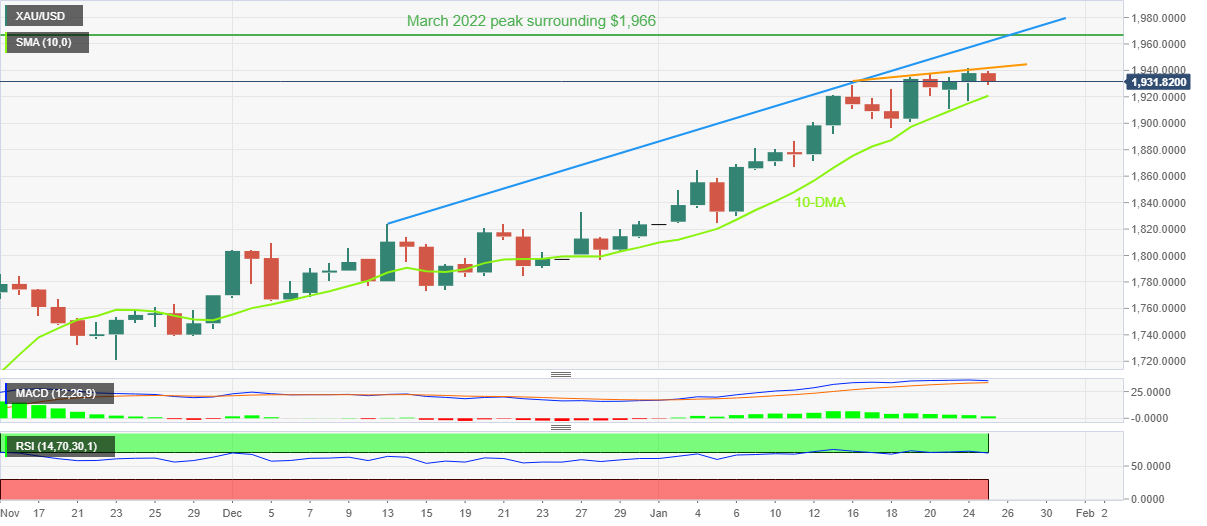
Trend: Pullback expected
- USD/INR retreats from weekly high, prints mild losses of late.
- Greenback remains depressed as US activities shrank for the seventh consecutive month.
- Cautious mood ahead of key data/events join sluggish yields, Oil price rebound to probe Indian Rupee buyers.
USD/INR bulls take a breather after a two-day uptrend amid Wednesday’s sluggish markets, refreshing intraday low near 81.50 at the latest. In doing so, the Indian Rupee (INR) pair traces the inactive yields, as well as the mixed performance of the US Dollar, amid a light calendar at home.
After reversing the two-day uptrend, the US Treasury bond yields remain sidelined as market players await fresh clues to confirm the recession woes. With this, the USD/INR pair portrays the cautious mood ahead of the US Gross Domestic Product (GDP) for the fourth quarter (Q4) and the next week’s Federal Open Market Committee (FOMC) meeting.
It should be noted that the US S&P Global PMIs moderated for January but failed to regain the 50.0 mark. That said, the Composite PMI for January increased to 46.6 from 45.0 prior and the 44.7 consensuses, marking the seventh consecutive below-50 figure.
With this, Fed fund futures signal the market’s receding hawkish bias. “Fed fund futures see only two more quarter-point rate hikes by the Fed to a peak of around 5% by June, before it starts cutting rates later in the year. The Federal Reserve itself has insisted it still has 75 bps of increases in the pipeline,” said Reuters.
As a result, the US Dollar Index (DXY) braces for the three-week downtrend despite being inactive around 102.00 as of late.
That said, the WTI crude oil prices also consolidate recent losses around $80.50, up half a percent to snap a two-day losing streak by the press time. As India relies on Oil imports and has a record Current Account Deficit (CAD), the higher Oil price weighs on the INR.
Amid these plays, the S&P 500 Futures print mild losses but the stocks in the Asia-Pacific region trade mixed and support the currencies of the zone.
Moving on, a light calendar challenges USD/INR moves while Thursday’s US Q4 GDP will be crucial for near-term directions. Following that, Friday’s opening of Adani Enterprise Initial Public Offering (IPO) from India will be important to gauge foreign inflows that seemed to have favored INR bulls of late. It’s worth observing, however, that the next week’s Federal Open Market Committee (FOMC) meeting is the most important event for the pair traders to watch for clear directions.
Technical analysis
With the latest pullback, the USD/INR pair marks another failure to cross the 100-DMA, around 81.80 by the press time, which in turn favors the odds of witnessing a fresh monthly low, currently around 80.90.
- EUR/USD is getting prepared for shifting the auction profile above 1.0900 as USD Index has turned subdued.
- The ECB may hike interest rates further by 50 bps and may not reach the terminal rate by the end of summer.
- Uncertainty over the US GDP data has supported US yields to rebound to near 3.47%.
The EUR/USD pair has refreshed its day’s high minutely above the round-level resistance of 1.0900 and is aiming to shift the auction profile above the same. The major currency pair has sharply moved higher after sensing a responsive buying action from the critical support of 1.0840. The Euro has gained significant buying interest as the odds of an extreme policy tightening by the European Central Bank (ECB) ahead are soaring dramatically.
The US Dollar Index (DXY) is continuously facing pressure from the 101.50 resistance after surrendering the same as the street is expecting a further slowdown in the pace of interest rate hiking by the Federal Reserve (Fed). Meanwhile, the return generated by US Treasury bonds has rebounded firmly. The 10-year US Treasury yields is near 3.47%, at the press time, and is looking to add gains further ahead of the release of the United States Gross Domestic Product (GDP) data.
S&P500 futures are looking to place foot after a sell-off led by growing uncertainty as earnings season is triggering volatility. NYSE technical glitch and missed earnings by tech-giant Microsoft are weighing on the US equities.
The odds of a bigger interest rate hike by the ECB are escalating sharply. ECB policymaker Gediminas Simkus reiterated on Tuesday that the ECB should continue with 50 basis points (bps) rate hikes amid growing wage pressures, as reported by Bloomberg. He has trimmed the expectations of reaching to the terminal rate by the end of summer citing that strong core inflation shows that their battle against inflation is not over yet.
Regarding Euro’s future, economists at CIBC Capital Markets cited that improving macro backdrop and continued policy tightening from the ECB portend Euro strength in 2023.
- AUD/USD has encountered the 0.7100 resistance amid sky-rocketing Australian inflation.
- The RBA may find an interest rate peak at 3.60% by June in CY2023.
- Weaker US yields are weighing on the US Dollar as the Fed is expected to announce a smaller rate hike ahead.
The AUD/USD pair has touched the round-level resistance of 0.7100 for the first time in the past five months amid fresh highs in the Australian inflation rate at 7.8% on an annual basis for the fourth quarter of CY2022. The annual CPI has been released stronger than the expectations of 7.5% and the prior release of 7.3%. On a quarterly basis, the inflation rate has climbed to 1.9% vs. the consensus of 1.6% and the former release of 1.8%.
There is no denying the fact that a stronger-than-projected Australian inflation rate is going to compel the Reserve Bank of Australia (RBA) for hiking interest rates further in its February monetary policy meeting. An Australian Financial Review survey of 34 economists conveys that RBA Governor Philip Lowe to continue hiking interest rates further to 3.60%. The RBA is expected to hike its Official Cash Rate (OCR) by 25 basis points (bps) in February and June. Also, one of the outcomes of the survey is that the first post-pandemic-era rate cut will be in play by March 2024.
Earlier this week, Australian Treasurer Jim Chalmers cited that the worst part of the country's inflation crisis was over. He believes "The Australian economy will begin to soften a bit this year and that is the inevitable likely consequence of higher interest rates and a slowing global economy.” Fresh highs in the inflation rate indicate that the interest rate peak has not been found and the worst is not over yet.
Meanwhile, S&P500 futures have witnessed a marginal recovery after falling sharply in early Asia. Amid the absence of recovery signs in the 500-US stock basket futures, risk-perceived assets are still at risk and investors might avoid them further. The US Dollar Index (DXY) is struggling in sustaining above the immediate resistance of 101.50, weighed down by weaker yields. Also, the rising chances of a smaller interest rate hike by the Federal Reserve (Fed) in its February monetary policy is impacting the US Dollar.
A former BoJ Chief Economist, Kazuo Momma, said in an MNI interview on Wednesday, the Bank of Japan (BoJ) will have to wait until August to gain good insight into whether wage increases are gaining traction.
Additional quotes
"As for wages, the most typical data is the government's monthly labor survey. The BOJ is focused on macro-economic data and the bank cannot assess overall wages through only one month of data.”
“The BoJ needs to examine wage data for the April-June period to ascertain how the trend of wages has changed, but wage data for June will only be available in early August.”
“Bank officials are also closely watching the process of spring wage negotiations, which offer very important information, and the scale of wage hikes in fiscal 2023.”
"Apart from the government's subsidies, the year-on-year rise of Japan's consumer prices will likely fall as import prices are falling."
"Manufacturers may weaken in the wake of a slowdown of overseas economies but a steady economic recovery on a whole is projected.”
"Eating and drinking services, accommodation and various events that had been restricted (by the government) will activate.”
"Meanwhile, the BOJ survey showed that household circumstances are worsening amid high prices.”
Related reads
- USD/JPY traces sluggish yields above 130.00 as Yen traders await BoJ Summary, US GDP and Fed
- BoJ conducts bond-buying operation on Wednesday
The Bank of Japan (BoJ) announced that it conducted bond-buying in its routine daily operation on Wednesday.
Key details
“BoJ offers to buy 500 bln yen in 1-3 yr JGBs.”
“BoJ offers to buy 500 bln yen in 3-5 yr JGBs.”
“BoJ offers to buy 575 bln yen in 5-10 yr JGBs.”
Market reaction
USD/JPY is holding higher ground near 130.50, adding 0.19% on the day. The pair shrugs off weak US Treasury yields.
New Zealand’s new Prime Minister (PM) Chris Hipkins expressed his view on stubbornly high inflation this Wednesday.
Key quotes
“Inflation is putting a strain on household budgets.”
“More must be done to combat high inflation.”
Related reads
- RBNZ: Annualized Q4 Sectoral Factor Model Inflation accelerates by 5.8%
- NZD/USD Price Analysis: Classic case of cup-and-handle highlights 0.6535 as the key hurdle
- USD/JPY prints mild gains after reversing from weekly top the previous day.
- Yields remain sidelined as traders await more clarity on growth prospects, Fed moves.
- US PMIs were mixed but downbeat equities and higher prints of inflation data elsewhere allowed yields/USD to defend Yen buyers.
- Light calendar ahead of US GDP, FOMC restricts immediate moves.
USD/JPY floats above 130.00, printing mild gains around 130.30 by the press time, amid sluggish markets on early Wednesday. In doing so, the Yen pair takes clues from the inactive Treasury bond yields amid a lack of data/events at home. Also likely to restrict the quote’s immediate moves could be the market’s cautious mood ahead of the Bank of Japan's (BOJ) Summary of Opinions and US Gross Domestic Product (GDP) for the fourth quarter (Q4), not to forget the next week’s Federal Open Market Committee (FOMC) meeting.
That said, the US 10-year Treasury bond yields drop 1.5 basis points (bps) to 3.45% while the two-year counterpart posted the biggest daily loss in a week around the 4.15% level. It should be noted that the S&P 500 Futures drop half a percent to 4,012, extending the previous day’s U-turn from the 1.5-month high.
While Wall Street’s mixed closing and the US Dollar’s failure to cheer the improvement in January PMI underpin USD/JPY weakness, together with hawkish bias from the BoJ, the market’s preparations for the next week’s Fed meeting propel the Yen pair.
It should be noted that Tuesday’s technical glitch joined the mixed earnings report to confuse equity traders the previous day. “Fourth quarter earnings season is in full swing, with 72 of the companies in the S&P 500 having reported. Of those, 65% have beaten consensus, just a hair below the 66% long-term average, according to Refinitiv,” said Reuters.
On the other hand, the US Dollar Index (DXY) remains pressured as the US activity data for January remained below 50.0 level and suggested contraction despite improving a bit.
The US PMIs moderated in the last few months but the growth is yet to witness as January’s US S&P Global Composite PMI for January increased to 46.6 from 45.0 prior and the 44.7 consensus, marking the seventh consecutive read below 50. It’s worth observing that preliminary readings of the US S&P Global Manufacturing PMI for January rose past 46.2 market forecast and 46.1 market expectations with 46.8 figure while the Services PMI followed the suit with the 46.6 figure for the said month, versus 44.5 forecast and 44.7 prior.
Amid these plays, Fed fund futures signal the market’s receding hawkish bias. “Fed fund futures see only two more quarter-point rate hikes by the Fed to a peak of around 5% by June, before it starts cutting rates later in the year. The Federal Reserve itself has insisted it still has 75 bps of increases in the pipeline,” said Reuters.
To sum up, USD/JPY portrays the typical pre-data anxiety while defending the 130.00 round figure. However, bears have an upper hand considering the hawkish bias surrounding BoJ.
Technical analysis
A two-month-old bearish channel restricts USD/JPY moves between 132.00 and 125.90.
The Scotiabank Research Team offers a sneak peek at what to expect from Wednesday’s Bank of Canada (BoC) interest rate decision, which could stir the CAD markets.
Also read: Bank of Canada Preview: The final one, with a pause ahead?
Key quotes
“The Bank of Canada weighs in with a full suite of communications this Wednesday including an updated policy statement and Monetary Policy Report with fresh forecasts (10am ET) followed by the 11am ET press conference hosted by Governor Macklem and SDG Rogers. This will also be the first time that the BoC releases meeting minutes two weeks later on February 8th and a day after Macklem speaks in Quebec City. The timing puts the minutes between the BoE’s release on the same day and the Fed’s release three weeks after meetings.”
“Markets are almost fully priced for a 25bps rate hike. All of the big domestic banks’ economics shops expect a 25bps hike including the Scotia Economics house view.”
“It is with modest conviction that we expect a 25bps hike.
“I would assign 55% odds to a 25bps hike, 35–40% odds to a pause and we can’t fully shut the door to a hawkish surprise as a low probability but high impact tail risk.”
“Part of the reason for that is that the BoC surprises in both directions when it (often) chooses to surprise.”
Deputy Governor Kozicki said on December 8th that “We are still prepared to be forceful” which is code language for a larger-than-normal rate hike “If there were to be a very large shock.” What has happened since probably doesn’t qualify, but it was after she spoke that over 100k jobs were created in a single month and forecasts for US GDP growth began to be revised sharply higher with implications for spillover effects into Canada’s economy.”
In its monthly report of economic and financial issues, the Bank of Korea (BoK), the South Korean central bank, said “past monetary policy change in Japan had only limited impact on won.”
Additional takeaways
“Private consumption in 2023 likely to be weaker than expected.”
“Country's housing price decline faster than in other countries.”
“Domestic CP market recovery to become more pronounced going forward.”
“Domestic household debt falling without big credit event concern.“
Market reaction
At the time of writing, USD/KRW is trading modestly flat at around 1,232, having slipped from higher levels near 1,235.
- NZD/USD picks up bids to pare intraday losses inside bullish chart formation.
- Looming bear cross on MACD, RSI retreat signal further pullback.
- 100-SMA puts a floor under the Kiwi price, bulls can aim for previous yearly top on sustained break of 0.6535.
NZD/USD licks its wounds near 0.6490 as it pares the intraday loss, the first in four days, during the mid-Asian session on Wednesday. In doing so, the quote justifies the RSI (14) retreat from the overbought territory, as well as the impending bear cross on the MACD.
Even so, the upbeat New Zealand inflation data and a cup-and-handle bullish chart formation on the four-hour play keep the Kiwi pair buyers hopeful.
That said, the quote’s latest weakness remains elusive unless breaking the 100-SMA support of 0.6380.
In a case where the NZD/USD pair drops below 0.6380, the bullish chart formation gets rejection, which in turn can drag the quote toward the monthly low near 0.6190. It should be noted that the 0.6300 round figure may offer an intermediate halt during the fall.
Alternatively, bulls need to portray a successful break of the 0.6535 hurdle to confirm the cup-and-handle chart pattern to theoretically aim for the previous yearly top surrounding 0.7035.
During the anticipated run-up, the mid-2022 peak near 0.6575 may act as buffer while the RSI conditions may challenge the NZD/USD bulls on the way to 0.7035.
NZD/USD: Four-hour chart

Trend: Pullback expected
The Reserve Bank of New Zealand (RBNZ) released its Sectoral Factor Model Inflation gauge for the fourth quarter of 2022 this Wednesday.
The gauge climbed further to 5.8% YoY in Q4 2022 vs. 5.6% seen in Q3.

In early Asia, New Zealand’s Consumer Price Index (CPI) rose by 1.4% QoQ in the fourth quarter, beating expectations of a 1.3% increase. Meanwhile, the annualized inflation steadied at 7.2% but bettered estimates of 7.1%.
FX Implications
The Kiwi dollar is unimpressed by the RBNZ inflation gauge, as NZD/USD is keeping its recovery mode intact toward 0.6500.
At the time of writing, the Kiwi is trading at 0.6489, down 0.20% on the day.
About the RBNZ Sectoral Factor Model Inflation
The Reserve Bank of New Zealand has a set of models that produce core inflation estimates. The sectoral factor model estimates a measure of core inflation based on co-movements - the extent to which individual price series move together. It takes a sectoral approach, estimating core inflation based on two sets of prices: prices of tradable items, which are either imported or exposed to international competition, and prices of non-tradable items, which are those produced domestically and not facing competition from imports.
| Raw materials | Closed | Change, % |
|---|---|---|
| Silver | 23.671 | 0.93 |
| Gold | 1937.455 | 0.33 |
| Palladium | 1742.95 | 2.44 |
- Market sentiment remains mixed as traders brace for next week’s Fed meeting after mixed PMIs.
- Cautious mood ahead of US Q4 GDP joins blackout periods at Fed, ECB to restrict market moves.
- S&P 500 Futures extends pullback from six-week high, US Treasury bond yields stay defensive.
- Light calendar, mixed clues keep traders guessing ahead of US GDP, FOMC.
Risk appetite wanes during Wednesday’s sluggish Asian session as traders try to gauge the recent activity data ahead of the next week's all-important monetary policy meetings, not to forget Thursday’s US Gross Domestic Product (GDP) for the fourth quarter (Q4). It’s worth noting that the mixed earnings and China’s absence from the markets, as well as cautious mood ahead of the European Central Bank (ECB) and the Federal Reserve (Fed) monetary policy meetings, seem to challenge the momentum traders of late.
While portraying the mood, S&P 500 Futures drop half a percent to 4,012, extending the previous day’s U-turn from the 1.5-month high. Further, the US 10-year Treasury bond yields drop 1.5 basis points (bps) to 3.45% while the two-year counterpart posted the biggest daily loss in a week around the 4.15% level.
It’s worth noting that Wall Street closed mixed on Tuesday as a technical glitch joined the mixed earnings report. “Fourth quarter earnings season is in full swing, with 72 of the companies in the S&P 500 having reported. Of those, 65% have beaten consensus, just a hair below the 66% long-term average, according to Refinitiv,” said Reuters.
Among the key equity headlines were the underwhelming forward guidance from 3M and General Electric, as well as the US Justice Department’s lawsuit against Google.
Elsewhere, the US Dollar Index (DXY) remains pressured as the US activity data for January remained below 50.0 level and suggested contraction despite improving a bit. The same help the prices of Gold and Oil to remain firmer.
It should be observed that the early-day release of quarterly inflation data from New Zealand and Australia entertained traders with the AUD/USD leading the G10 bulls around 0.7090 by the press time.
Looking forward, the first readings of the US fourth-quarter (Q4) Gross Domestic Product (GDP), up for publishing on Thursday, will be crucial to watch for immediate directions. The reason appears logical due to the next week’s Federal Open Market Committee (FOMC) meeting, as well as the talks of the US recession. Forecasts suggest the world’s biggest economy eases with 2.8% annualized growth.
Also read: US Gross Domestic Product Preview: Three reasons to expect a US Dollar-boosting outcome
- GBP/USD bears are lurking below key resistance ahead of important US data this week.
- The price is being resisted at a 61.8% Fibonacci correction level.
GBP/USD is now teetering on the edge of rolling over following a significant correction from the breakout lows. GBP/USD has been falling out below the structure that was identified in the prior analysis as follows:

The bears were moving in at the end of last week as illustrated on the 4-hour chart above. We have seen a push lower following tests in the 1.24 area that indeed failed.

GBP/USD update

The price is now teetering on the edge of rolling over following a significant correction from the breakout lows. The pair has moved into a 61.8% Fibonacci retracement level and is meeting old support. A break here opens the risk of a strong drop as we progress through the week. However, there is important data on the calendar from the US economy and investors may be sitting on their hands until then.
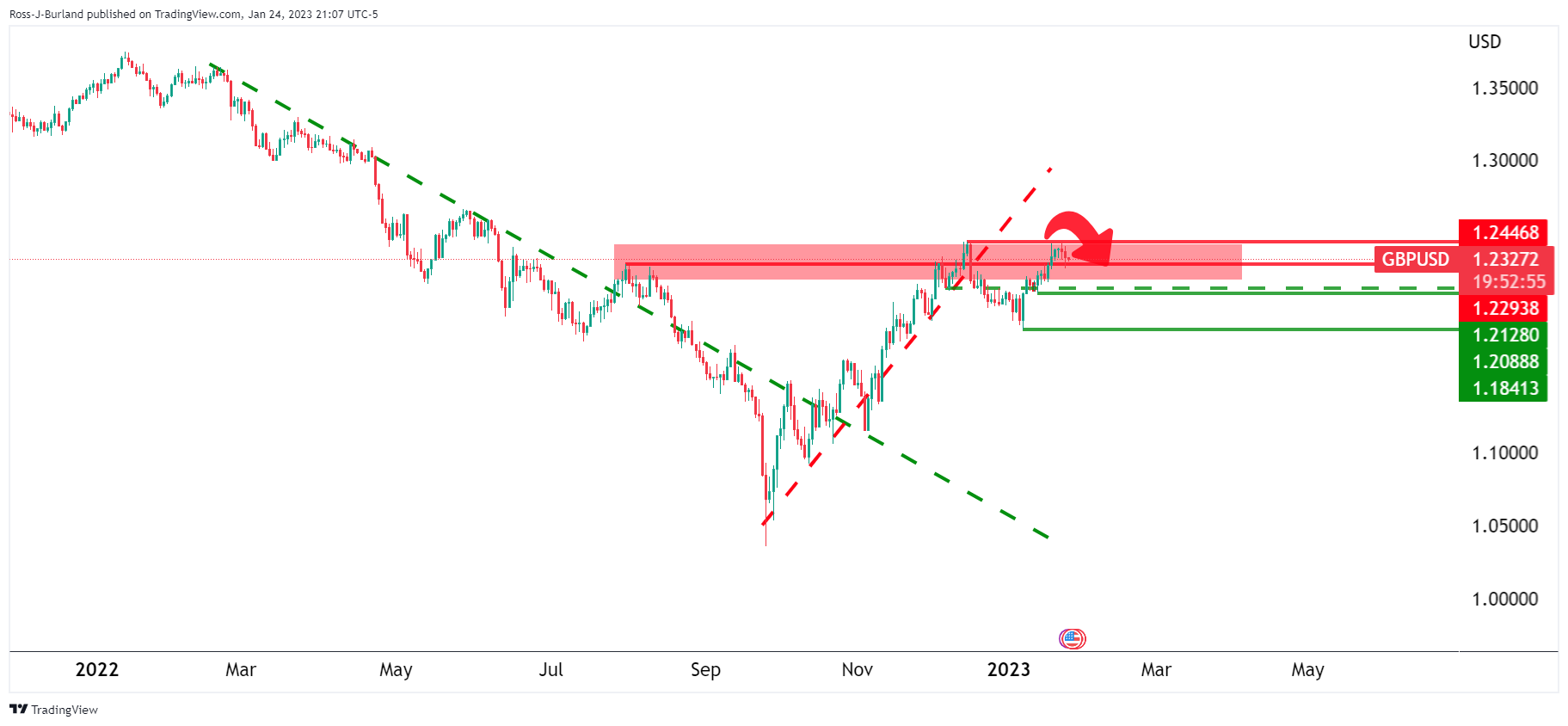
Nevertheless, the daily outlook is bearish all the while the price is below the the1.2450s with 1.2080 eyed on a break below 1.2300.
- Gold price is attempting to surpass $1,940.00 as US yields drop further.
- The USD Index to remain weak this year as attention is turning towards policy tightening in other advanced economies.
- Gold price is auctioning in a Rising Wedge, portraying a volatility contraction.
Gold price (XAU/USD) is aiming to overstep the immediate resistance of $1,940.00 in the Tokyo session. The precious metal is gaining strength amid rising demand for the US government bonds that have weakened yields further. The 10-year US Treasury yields have dropped to near 3.45%.
A sell-off in the S&P500 futures is indicating that the risk-taking capacity of the market participants is fading away. Missed estimates by tech-giant Microsoft in its December earnings and technical glitch in NYSE are impacting United States equities. The US Dollar Index (DXY) is displaying a sideways profile around 101.50 as investors await US Gross Domestic Product (GDP) data for fresh impetus.
Gold price might find strength if US GDP contracts dramatically, which might further bolster the expectations for a smaller interest rate hike by the Federal Reserve (Fed) in its February meeting. As per the estimates, the annual Q4CY2022 GDP will contract to 2.8% from the former release of 3.2%. For the USD Index outlook, economists at CIBC Capital Markets look for the mighty US Dollar to weaken in 2023 as the Fed is set to undershoot market expectations for the peak fed funds rate, and attention turning to policy tightening in other advanced economies.
Gold technical analysis
Gold price is auctioning in a Rising Wedge chart pattern on an hourly scale that indicates volatility contraction, which will result in wider ticks and heavy volume after an explosion. The 20-period Exponential Moving Average (EMA) at $1,935.33 is acting as a cushion for the Gold bulls.
Meanwhile, the Relative Strength Index (RSI) (14) is oscillating in a 40.00-60.00 range that demonstrates a lackluster performance by the Gold price ahead.
Gold hourly chart
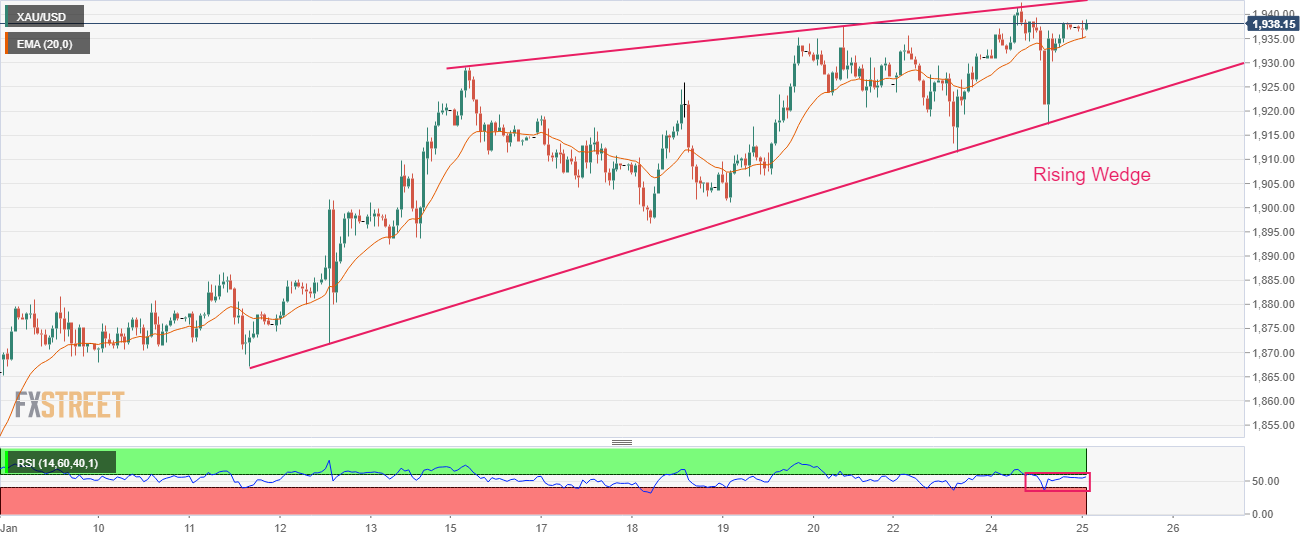
- EUR/USD grinds higher during five-week winning streak, steadies of late.
- Bullish chart pattern, sustained bounce off 50-SMA joins upbeat RSI to keep buyers hopeful.
- Sellers need to conquer monthly support to retake control.
EUR/USD prints mild gains around the 1.0900 threshold as traders await fresh clues to extend the five-day uptrend during Wednesday’s sluggish Asian session.
Even so, the two-week-old rising trend channel joins the EUR/USD pair’s successful rebound from the 50-SMA, around 1.0835 by the press time, to underpin the bullish bias for the major currency pair.
It’s worth noting that the weekly resistance breakout and the firmer RSI (14) also keep the EUR/USD bulls hopeful.
That said, the EUR/USD bulls are en route to the top line of the aforementioned bullish channel, close to 1.0945 at the latest.
Following that, the 1.1000 round figure and March 2022 peak surrounding 1.1185 could gain the market’s attention.
Alternatively, pullback moves need to drop back below the immediate resistance-turned-support line from Monday, close to 1.0875 at the latest, before aiming for the 50-SMA support of 1.0838.
Even if the EUR/USD pair remains bearish past 1.0838, the lower line of the stated channel, near 1.0820 by the press time, becomes the key to watch for clear directions.
It should be observed that a horizontal area comprising multiple levels marked since the start of 2023, close to 1.0700, will be crucial for the EUR/USD bear’s conviction.
EUR/USD: Four-hour chart
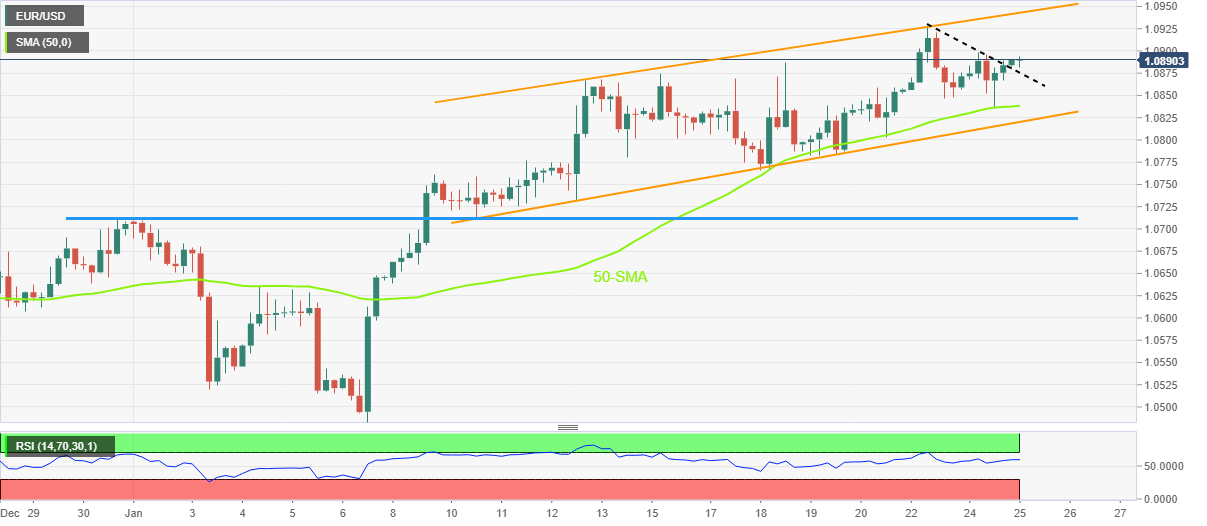
Trend: Further upside expected
- USD/CAD is facing stiff resistance in surpassing the 1.3380 hurdle as the focus shifts to BoC policy.
- BoC Governor is expected to hike interest rates further by 25 bps to 4.5%.
- A sell-off in S&P500 futures is portraying caution in the market mood.
The USD/CAD pair is facing barricades in paddling above the immediate resistance of 1.3380 in the Asian session. The Loonie asset is expected to display a volatility contraction as investors are awaiting the interest rate decision by the Bank of Canada (BoC) for fresh cues. To tame the roaring inflation, BoC Governor Tiff Macklem might continue hiking interest rates further.
Meanwhile, S&P500 futures are facing immense sell-off, portraying that investors are getting risk-averse ahead of the release of the United States Gross Domestic Product (GDP) data. The 500-US stock basket futures have dropped sharply amid a decline in investors’ risk appetite. The US Dollar Index (DXY) is building a cushion around 101.50. The 10-year US Treasury yields have dropped below 3.46%.
According to a poll from Reuters, BoC Governor Tiff Macklem’s aggressive policy-tightening campaign is expected to calm as the street sees a further interest rate hike by 25 basis points (bps) to 4.50%. Also, it states that the Canadian central bank will keep interest rates at 4.5% for the rest of the year, which indicates that this might be the end of further policy tightening. Canada’s headline inflation stood at 6.3% for December and is expected to remain above the 2% inflation target till Q3CY2024.
Oil prices have attempted a recovery after dropping to near $80.00 as US President Joe Biden is considering refilling the Strategic Petroleum Reserve (SPR), which was eased to combat mounting oil prices. This might disturb the equilibrium in the demand-supply mechanism, which might result in short-term pain for oil buyers due to higher prices. It is worth noting that Canada is a leading exporter of oil to the United States and a recovery in oil prices will support the Canadian Dollar.
On the United States front, the release of the GDP data might trigger volatility ahead. According to the consensus, the annualized GDP is seen lower at 2.8% vs. the prior release of 3.2%.
- WTI steadies after two-day downtrend, mildly bid of late.
- Fears of recession joins successive addition in the US inventories, Biden’s push for SPR to weigh on prices.
- OPEC+ chatters add strength to the upside filters.
- Softer US Dollar, China-linked optimism puts a floor under the prices.
WTI crude oil picks up bids to pare the two-day losses around $80.30, printing mild gains during early Wednesday in Asia. In doing so, the black gold prices benefit from the softer US Dollar amid sluggish trading hours. However, economic fears and growing concerns over inventory build, as well as higher supplies, seem to probe the Oil buyers of late.
That said, US Dollar Index (DXY) remains pressured after the January activity data suggests the contraction despite being in contraction region. January’s US S&P Global Composite PMI for increased to 46.6 from 45.0 prior and the 44.7 consensus, marking the seventh consecutive read below 50. It’s worth observing that preliminary readings of the US S&P Global Manufacturing PMI for January rose past 46.2 market forecast and 46.1 market expectations with 46.8 figure while the Services PMI followed the suit with the 46.6 figure for the said month, versus 44.5 forecast and 44.7 prior.
On the other hand, the American Petroleum Institute’s (API) weekly US Crude Oil Stock report for the week ended on January 20 showed the addition of 3.378 million barrels versus 7.615M prior increase. With this, the API stockpiles grew for the fourth consecutive week.
It should be noted that the US activity numbers weren’t the only one which were softer, the figures from Germany also couldn’t impress the oil buyers.
Also challenging the energy benchmark prices could be the latest tension surrounding US and Chinese ties due to Beijing-based companies’ alleged role in the Russian war. On the same line could be US President Joe Biden’s readiness to use the US Strategic Petroleum Reserves (SPR) and using veto rights to defend the action in case needed.
Additionally, Reuters came out with news suggesting no major change in the OPEC+ output policy while citing an anonymous source. “The Joint Ministerial Monitoring Committee (JMMC) of the Organization of the Petroleum Exporting Countries (OPEC) and allies led by Russia, known collectively as OPEC+, is unlikely to recommend any changes to oil output policy,” said Reuters citing five OPEC+ sources. OPEC+ is scheduled to meet next week, on February 1.
Looking forward, the official weekly Crude Oil Stocks Change report from the Energy Information Administration (EIA) for the week ended on January 20, prior 8.408M, will be watched closely for confirmation of the API data.
Technical analysis
A failure to cross the 100-DMA hurdle, around $81.70 by the press time, highlights three-week-old support line, close to $79.50 by the press time, as the key support to watch.
- AUD/USD bulls eye the 0.7100s on the CPI beat.
- Bulls move back in following worthy correction.
AUD/USD bulls have moved in at a 61.8% Fibonacci retracement level following the correction of the high-impact data event in today's Tokyo session as the following illustrates.
The Aussie Consumer Price Index beat expectations and sent AUD/USD from a low of 0.7038 to a fresh bull cycle high of 0.7084 on the knee-jerk. However, the pair sank back into the spike but has since started to recover and is targeting a break of the session highs at the time of writing.
AUD/USD 1-min chart
The price could rally into the 0.7100/20 area as per the daily chart:
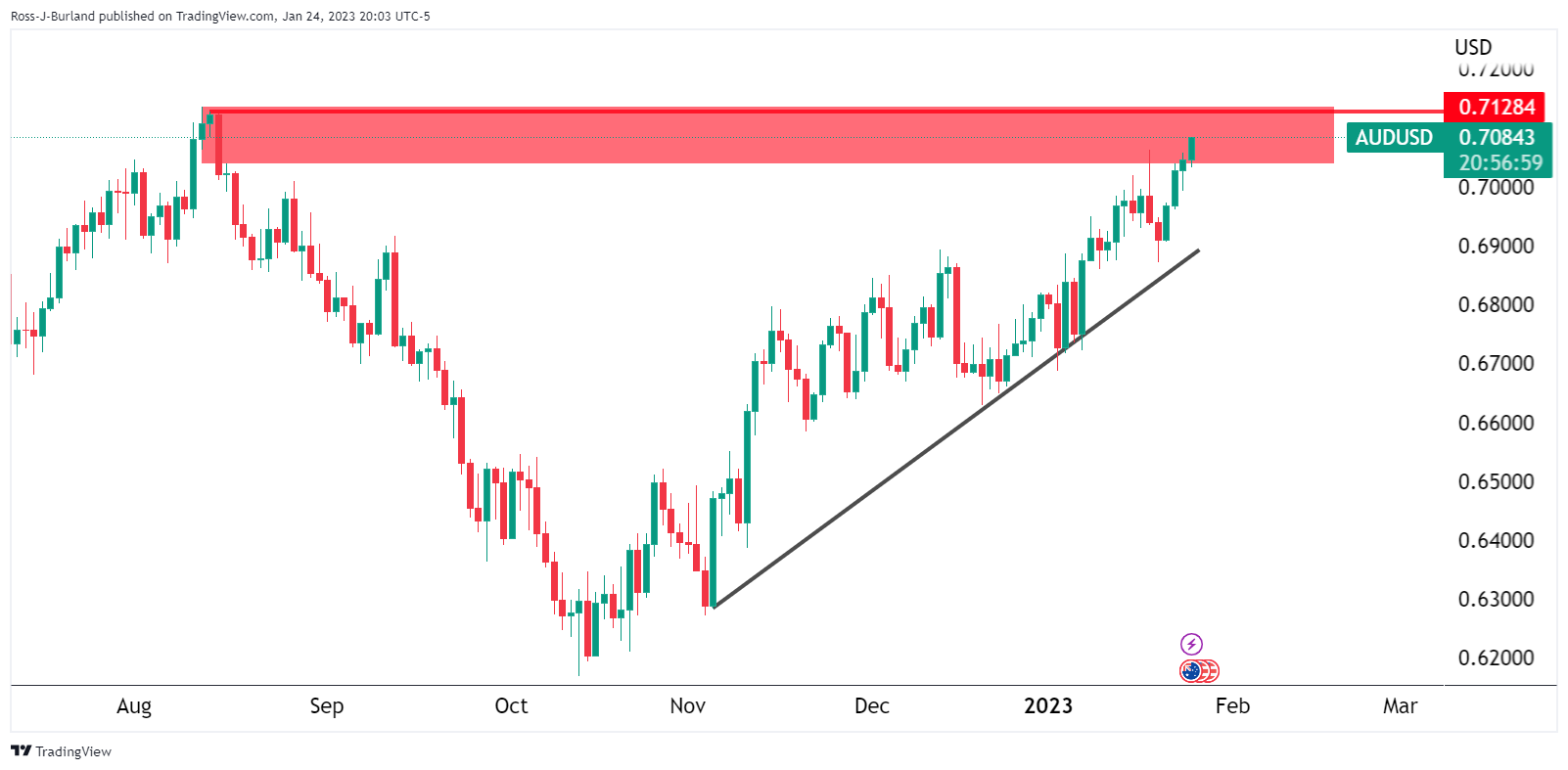
- AUD/NZD takes the bids to refresh one-week high after upbeat quarterly inflation data from Australia, New Zealand.
- Overbought RSI, descending resistance line from November 11 challenge pair buyers.
- Five-week-old ascending trend line, 200-SMA restrict short-term declines.
AUD/NZD jumps the most in three weeks after inflation data from Australia and New Zealand published upbeat results early Wednesday. That said, the exotic pair grinds higher past 1.0900 at the latest, following the recent run-up to 1.0926.
Earlier in the day, New Zealand Consumer Price Index (CPI) for the fourth quarter (Q4) rose past 7.1% YoY market forecast to reprint the 7.2% figures while the QoQ data suggests a 1.4% number against 1.3% expected and 2.2% prior. It’s worth noting that the Reserve Bank of New Zealand (RBNZ) anticipated 7.5% yearly inflation in its November meeting.
Following that Australia’s Q4 CPI rose to 7.8% YoY versus 7.5% expected and 7.3% prior while the RBA Trimmed Mean CPI jumped to 6.9% YoY compared to 6.5% market forecasts and 6.1% previous readings. Further, the Monthly CPI rose to 8.4% from 7.3% previous readings and 7.7% market forecasts.
Given the comparatively stronger Aussie inflation numbers, the AUD/NZD pair pokes a downward-sloping resistance line from November 11, around 1.0920 by the press time. However, the overbought RSI and fears of the Reserve Bank of Australia’s (RBA) less-hawkish play challenge the pair buyers. Also acting as an immediate upside hurdle is the monthly peak surrounding 1.0940.
It’s worth mentioning that the bullish MACD signals keep the AUD/NZD buyers hopeful. That said, the five-week-long rising trend line and the 200-SMA restrict the quote’s immediate downside to around 1.0780 and 1.0735 respectively.
Overall, AUD/NZD is likely to remain firmer but the upside room appears limited.
AUD/NZD: Four-hour chart
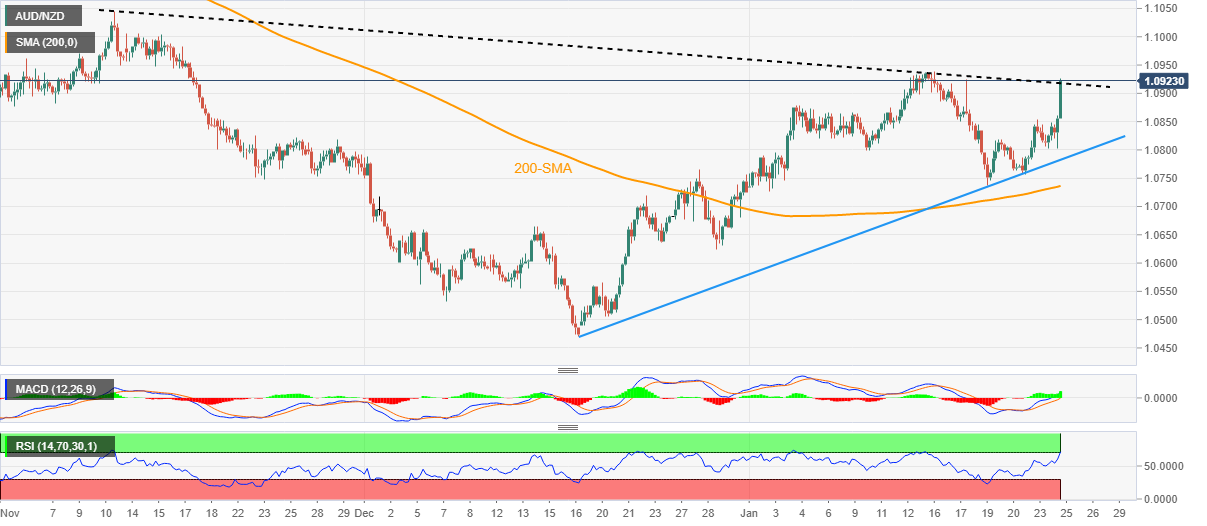
Trend: Pullback expected
- AUD/JPY climbs to near 92.40 amid a sharp increase in Australian inflation.
- Annual Australian inflation has jumped to 7.8% while quarterly inflation has climbed to 1.9%.
- Rising interest rates by the RBA have contracted the scale of economic activities significantly.
The AUD/JPY pair has jumped to near 92.40 as the Australian Bureau of Statistics has reported a higher-than-anticipated Consumer Price Index (CPI) report for the fourth quarter of CY2022. The annual CPI has jumped to 7.8% from the expectations of 7.5% and the prior release of 7.3%. On a quarterly basis, the inflation rate has climbed to 1.9% vs. the consensus of 1.6% and the former release of 1.8%.
A higher-than-expected inflation rate is going to compel the Reserve Bank of Australia (RBA) for hiking interest rates further in its February monetary policy meeting. The Australian Financial Review’s survey of 34 economists put the first post-pandemic-era rate cut in play by March 2024. But before that, it expects RBA Governor Philip Lowe to continue hiking interest rates further to 3.60%. The RBA is expected to hike its Official Cash Rate (OCR) by 25 basis points (bps) in February and June.
Meanwhile, economic activities in the Australian region have been constantly contracting for the past seven months due to restrictive monetary policy. According to the preliminary S&P PMI (Jan), Australian Manufacturing PMI has trimmed consecutively for the seven-month to 49.8 while the street was expecting an expansion to 50.3. Also, the Services PMI has dropped vigorously to 48.3 from the consensus of 49.7, released on Tuesday.
On the Tokyo front, the Japanese Yen bulls are continuously facing pressure from the market participants after Bank of Japan (BoJ) Governor Haruhiko Kuroda kept a dovish stance on interest rates and also kept the range of Japanese Government Bonds (JGBs) unchanged. This week, the release of The Tokyo inflation data will be of utmost importance.
- AUD/USD renews multi-day high on strong Aussie inflation report.
- Quarterly Aussie CPI marked 7.8% YoY figures while RBA Trimmed Mean CPI also rose to 6.9% in Q4.
- Mixed sentiment, cautious mood in market also weigh on the risk barometer pair.
- US GDP is the key to watch amid growing support for Fed policy pivot.
AUD/USD jumps to a fresh high since August 15 after strong Australian inflation data please the bulls during early Wednesday. It should be noted, however, that the downbeat sentiment probes the pair due to its risk-barometer status.
That said, Australia’s fourth quarter (Q4) Consumer Price Index (CPI) rose to 7.8% YoY versus 7.5% expected and 7.3% prior while the RBA Trimmed Mean CPI jumped to 6.9% YoY compared to 6.5% market forecasts and 6.1% previous readings. Further, the Monthly CPI rose to 8.4% from 7.3% previous readings and 7.7% market forecasts.
Given the upbeat signals from the inflation data supporting the odds favoring the Reserve Bank of Australia’s (RBA) hawkish move, the AUD/USD prices rallied post-release.
Also read: Breaking: AUD/USD rallies hard on Aussie CPI beat
Other than the Aussie inflation data, the cautious mood in the market ahead of Thursday’s US growth numbers and the next week’s Federal Open Market Committee (FOMC) monetary policy meeting also weigh on the AUD/USD prices. However, mixed signals from the US data and receding hawkish Fed bets seem to put a floor under the Aussie pair.
As per the latest activity data from the US, the outcome has moderated in the last few months but the growth is yet to witness as January’s US S&P Global Composite PMI for January increased to 46.6 from 45.0 prior and the 44.7 consensus, marking the seventh consecutive read below 50. It’s worth observing that preliminary readings of the US S&P Global Manufacturing PMI for January rose past 46.2 market forecast and 46.1 market expectations with 46.8 figure while the Services PMI followed the suit with the 46.6 figure for the said month, versus 44.5 forecast and 44.7 prior.
After the mixed data, Fed fund futures signal the market’s receding hawkish bias. “Fed fund futures see only two more quarter-point rate hikes by the Fed to a peak of around 5% by June, before it starts cutting rates later in the year. The Federal Reserve itself has insisted it still has 75 bps of increases in the pipeline,” said Reuters.
Amid these plays, the S&P 500 Futures print mild losses while tracking Wall Street whereas the US 10-year Treasury yields remain dicey near 3.45%, down for the fourth consecutive week.
Moving on, the first readings of the US fourth-quarter (Q4) Gross Domestic Product (GDP), up for publishing on Thursday, will be crucial to watch for immediate directions. The reason appears logical due to the next week’s Federal Reserve (Fed) meeting, as well as the talks of the US recession. Forecasts suggest the world’s biggest economy eases with 2.8% annualized growth.
Also read: US Gross Domestic Product Preview: Three reasons to expect a US Dollar-boosting outcome
Technical analysis
Given the successful break of a one-week-old descending resistance line, around 0.7060 by the press time, the AUD/USD is on the way to the August 2022 peak surrounding 0.7136.
The monthly Consumer Price Index (YoY), released by the RBA and republished by the Australian Bureau of Statistics has arrived as follows:
- Australia Q4 Headline CPI 1.9% QoQ vs. the expected 1.6%, the prior was 1.8%
- Trimmed mean +1.7 pct QoQ (Reuters poll +1.5 pct).
- Q4 (all groups) +1.9 pct QoQ (Reuters poll +1.6 pct).
- RBA weighted median CPI +1.6 pct QoQ (Reuters poll +1.4 pct).
- RBA Trimmed mean CPI +6.9 pct YoY (Reuters poll +6.5 pct).
AUD/USD update
AUD/USD is rallying hard to a fresh bull cycle high near 0.7080.

About the monthly CPI
This is a measure of price movements by the comparison between the retail prices of a representative shopping basket of goods and services. The purchasing power of AUD is dragged down by inflation. The CPI is a key indicator to measure inflation and changes in purchasing trends. A high reading is seen as positive (or bullish) for the AUD, while a low reading is seen as negative (or bearish). Note: This indicator started to be published in 2022 and it updates the price change for the last 12 months in Australia in a monthly basis, instead of the quarterly period of the main Australian CPI.
| Index | Change, points | Closed | Change, % |
|---|---|---|---|
| NIKKEI 225 | 393.15 | 27299.19 | 1.46 |
| ASX 200 | 33.1 | 7490.4 | 0.44 |
| FTSE 100 | -27.34 | 7757.36 | -0.35 |
| DAX | -9.84 | 15093.11 | -0.07 |
| CAC 40 | 18.46 | 7050.48 | 0.26 |
| Dow Jones | 104.4 | 33733.96 | 0.31 |
| S&P 500 | -2.86 | 4016.95 | -0.07 |
| NASDAQ Composite | -30.14 | 11334.27 | -0.27 |
- USD/JPY 131.00 is an upside target that could otherwise give way to a full-on rally to fresh bull cycle highs.
- 130.50 is first key objective on the upside while it meets a 50% mean reversion of the prior bearish impulse.
USD/JPY is perking up in Asia but is treading thin ice along a fragile support structure around 130 the figure following a pop into key resistance on Tuesday near a 1-week high near 131.00, some way higher than 127.21 and its worst level since May recently scored.
The Bank of Japan policy review was a catalyst for the upside following the surprise hold on a policy that has enabled the pair to trend and test the daily trendline resistance as the following technical analysis below will illustrate.
Nevertheless, the US Dollar edged lower against the majority of the forex board, weakened after data showed the eurozone business activity made a surprise return to modest growth, sinking the DXY index as investors weigh the Federal Reserve vs. the European Central Bank.
With this regard, the Fed fund futures see only two more quarter-point rate hikes by the Fed to a peak of around 5% by June, before it starts cutting rates later in the year. However, many analysts are on the fence and some expect a more hawkish Fed given that it has insisted it still has 75 bps of increases in the pipeline.
For instance, analysts at Brown Brothers Harriman have also of the opinion that the market is underestimating the potential for a higher for longer Federal Reserve. ''Core Personal Consumption Expenditures, PCE, has largely been in a 4.5-5.5% range since November 2021,'' they said. ''We think the Fed needs to see further improvement before even contemplating any sort of pivot.''
Analysts at ANZ Bank recently wrote a note, entitled, ''Fed tightening not done yet,'' that ''so far in early 2023, US data releases have indicated a mild easing in inflationary pressures and softer demand. This indicates the Fed’s aggressive tightening last year is starting to take effect,'' the analysts explained. ''Weakness in housing is evident (existing home sales fell 17.8% last year), manufacturing activity has faltered and Retail Sales are returning to trend.''
Big data week for US Dollar
Meanwhile, the week is about to get busier. US Core PCE prices likely accelerated to a 0.3% MoM pace in Dec, though a 0.4% gain can't be discarded, analysts at TD Securities explained. ''The YoY rate likely slowed to 4.5%, suggesting prices continue to moderate but remain sticky at high levels. We also look for Gross Domestic Product growth to have stayed strong in Q4, posting another above-trend gain. Growth was likely supported by firm showings from the consumer and inventories.''
USD/JPY technical analysis
- USD/JPY Price Analysis: Bears cap the bulls ahead of key events
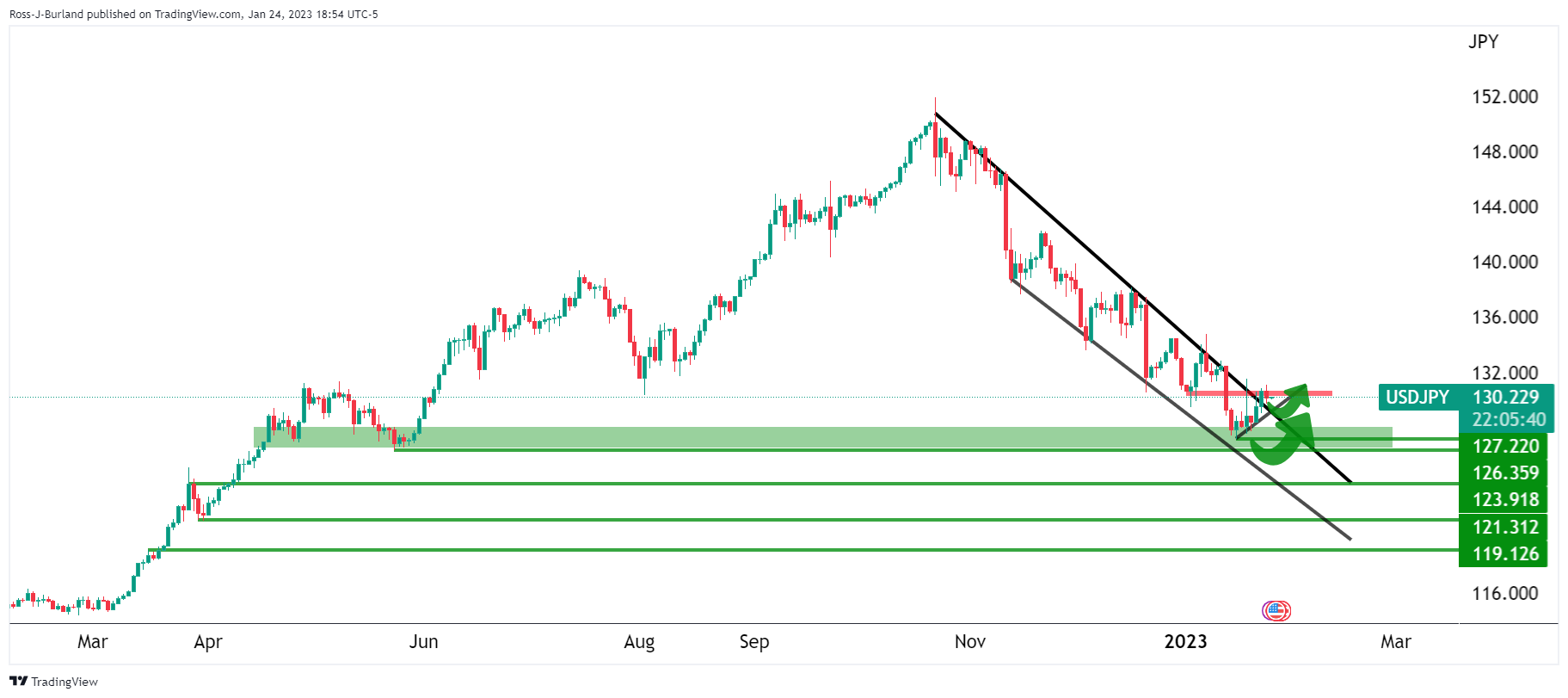
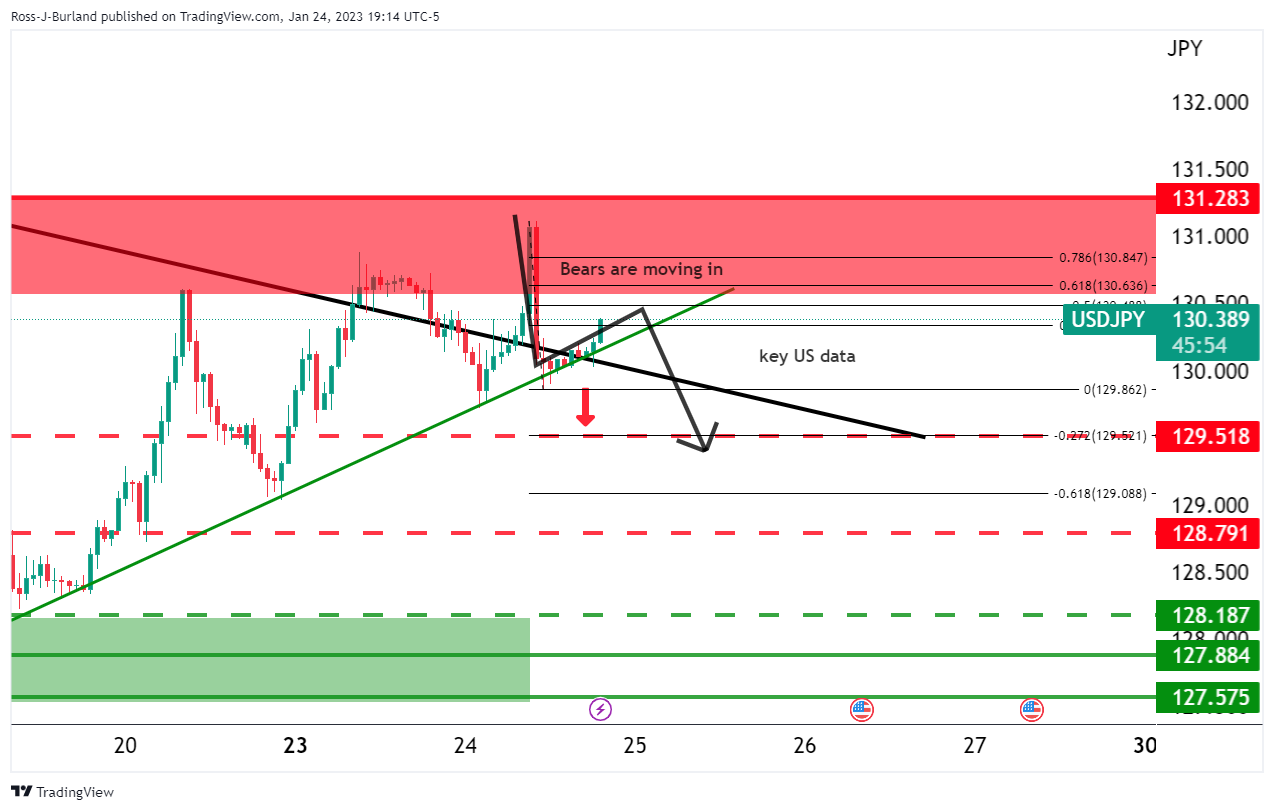
The bulls are trying to hold on but they may be pressured before long as the correction fizzles out and bears move in to test commitments at the trendline. 130.50 is key on the upside while it meets a 50% mean reversion of the prior bearish impulse. The 131.00 is an upside target that could otherwise give way to a full-on rally to fresh bull cycle highs beyond major dynamic daily resistance.
| Pare | Closed | Change, % |
|---|---|---|
| AUDUSD | 0.70477 | 0.31 |
| EURJPY | 141.737 | -0.16 |
| EURUSD | 1.08882 | 0.15 |
| GBPJPY | 160.651 | -0.57 |
| GBPUSD | 1.23412 | -0.28 |
| NZDUSD | 0.65085 | 0.44 |
| USDCAD | 1.33654 | -0.01 |
| USDCHF | 0.92247 | 0.09 |
| USDJPY | 130.174 | -0.33 |
- GBP/JPY has shifted its auction profile above 160.00 amid rising hawkish BoE bets.
- According to a Reuters poll, the BoE might hike its interest rates by 50 bps to 4% in February.
- Higher-than-expected UK PPI data could accelerate inflation projections further.
The GBP/JPY pair sensed a decent buying interest after dropping to near the round-level resistance of 160.00. The cross is attempting to extend its recovery meaningfully above 160.50 amid rising expectations for the continuation of bulky interest rate hikes by the Bank of England (BoE) ahead.
Following the footprints of sideways GBP/USD, the GBP/JPY pair is also demonstrating rangebound oscillation. The Pound Sterling is likely to remain in the bullish territory as the BoE seems bound to tighten interest rate policy further to contain stubborn inflation.
The latest poll conducted by Reuters for BoE interest rate projections claims that 29 of 42 economists are favoring a 50 basis point (bps) interest rate hike to 4.00 on February 02 by BoE Governor Andrew Bailey. However, residual economists have favored a 25 bps interest rate hike. In the agenda of restricting inflation to 2%, the BoE has to continue hiking interest rates further as an increment in food prices has offset the impact of softening energy prices. Also, the shortage of labor has been a major concern for the United Kingdom's economy.
For further guidance, the release of the UK Producer Price Index (PPI) will remain in the spotlight. The core PPI output is seen higher at 13.9% vs. the former release of 13.3%. An occurrence of the same might trigger inflation projections further and could create more troubles for the BoE policymakers. Also, it might strengthen the odds of a bumper interest rate hike by the BoE.
Meanwhile, economists at CIBC Capital Markets are favoring strength in Japanese Yen in the second half of CY2023 considering the fact that the Bank of Japan (BoJ) might exit from negative rates and the largest foreign holding of US Treasuries by Japan would compress the interest rate spread.
- US Dollar Index treads water after a volatile day, eyes third consecutive weekly loss.
- US activities shrunk in January even if the PMIs moderated, hawkish ECB concerns also weigh on DXY.
- Fed fund futures signal the policy pivot to be nearer than the US central bank signaled.
- Advances readings of US Q4 GDP are the key ahead of next week’s FOMC.
US Dollar Index (DXY) treads water around 101.90-95 as it struggles to pause late Tuesday’s pullback from 102.43 amid a sluggish Asian session on Wednesday. In doing so, the greenback’s gauge versus the six major currencies portrays the market’s cautious mood ahead of Thursday’s key US growth numbers and the next week’s Federal Open Market Committee (FOMC) monetary policy meeting.
It’s worth noting that the DXY failed to benefit from the sour sentiment on Tuesday amid mixed concerns surrounding the US activity data. That said, preliminary readings of the US S&P Global Manufacturing PMI for January rose past 46.2 market forecast and 46.1 market expectations with 46.8 figure while the Services PMI followed the suit with the 46.6 figure for the said month, versus 44.5 forecast and 44.7 prior. That said, the S&P Global Composite PMI for January increased to 46.6 from 45.0 prior and the 44.7 consensus, marking the seventh consecutive read below 50.
Following the US data, the US Dollar Index managed to rise for a brief time before closing in the red. The reason could be linked to the comments from Chief Business Economist at S&P Global Chris Williamson who said, “The US economy has started 2023 on a disappointingly soft note, with business activity contracting sharply again in January."
On the other hand, an easing in the market’s favor for the hawkish Fed moves in the next week also weighed on the DXY. “Fed fund futures see only two more quarter-point rate hikes by the Fed to a peak of around 5% by June, before it starts cutting rates later in the year. The Federal Reserve itself has insisted it still has 75 bps of increases in the pipeline,” said Reuters.
Furthermore, the increasing chatters surrounding the European Central Bank’s (ECB) 50 basis points (bps) rate hike in the next week and upbeat Eurozone PMI data also weigh on the DXY. That said, European Central Bank (ECB) policymaker Gediminas Simkus was the latest to back 50 bps rate hike while the first readings of the Eurozone S&P Global Manufacturing PMI crossed the 48.5 market forecasts and 47.8 previous readouts with 48.8 figure for January. Further, the Services PMI also impressed Euro bulls with 50.7 mark versus 50.2 expected 49.8 prior. With this, the Composite PMI for the bloc increased to 50.2 from 49.3 previous readings and 49.8 market forecasts.
Following the data releases, Chris Williamson, Chief Business Economist at S&P Global said, “A steadying of the Eurozone economy at the start of the years adds to evidence that the region might escape recession.”
Looking forward, a light calendar and the absence of the Fed and the ECB talks ahead of next week’s monetary policies could restrict the DXY moves. However, the bears are likely to keep the reins amid bearish bias surrounding the Federal Reserve, as well as the hawkish concerns about the European Central Bank. That said, the first readings of the US fourth-quarter (Q4) Gross Domestic Product (GDP), up for publishing on Thursday, will be crucial to watch for immediate directions. The reason appears logical due to the next week’s Federal Reserve (Fed) meeting, as well as the talks of the US recession. Forecasts suggest the world’s biggest economy eases with 2.8% annualized growth.
Also read: US Gross Domestic Product Preview: Three reasons to expect a US Dollar-boosting outcome
Technical analysis
Unless crossing the previous monthly low surrounding 103.40, the US Dollar is on the way to the latest swing low near 101.50 ahead of challenging the May 2022 bottom close to 101.30.
© 2000-2025. Bản quyền Teletrade.
Trang web này được quản lý bởi Teletrade D.J. LLC 2351 LLC 2022 (Euro House, Richmond Hill Road, Kingstown, VC0100, St. Vincent and the Grenadines).
Thông tin trên trang web không phải là cơ sở để đưa ra quyết định đầu tư và chỉ được cung cấp cho mục đích làm quen.
Giao dịch trên thị trường tài chính (đặc biệt là giao dịch sử dụng các công cụ biên) mở ra những cơ hội lớn và tạo điều kiện cho các nhà đầu tư sẵn sàng mạo hiểm để thu lợi nhuận, tuy nhiên nó mang trong mình nguy cơ rủi ro khá cao. Chính vì vậy trước khi tiến hành giao dịch cần phải xem xét mọi mặt vấn đề chấp nhận tiến hành giao dịch cụ thể xét theo quan điểm của nguồn lực tài chính sẵn có và mức độ am hiểu thị trường tài chính.
Sử dụng thông tin: sử dụng toàn bộ hay riêng biệt các dữ liệu trên trang web của công ty TeleTrade như một nguồn cung cấp thông tin nhất định. Việc sử dụng tư liệu từ trang web cần kèm theo liên kết đến trang teletrade.vn. Việc tự động thu thập số liệu cũng như thông tin từ trang web TeleTrade đều không được phép.
Xin vui lòng liên hệ với pr@teletrade.global nếu có câu hỏi.
